
H W co CO CO \ W <r \ z
UTAH HISTORICAL QUARTERLY (ISSN 0042-143X)
EDITORIAL STAFF
MAX J EVANS, Editor
STANFORD J. LAYTON, Managing Editor
KRISTEN S. ROGERS, Associate Editor
ALLAN KENT POWELL, Book Review Editor
ADVISORY BOARD OF EDITORS
AUDREY M. GODFREY, Logan, 2000
LEE ANN KREUTZER, Torrey, 2000
ROBERT S MCPHERSON, Blanding, 2001
MIRIAM B MURPHY, Murray, 2000
ANTONETTE CHAMBERS NOBLE, Cora, WY, 1999
RICHARD C ROBERTS, Ogden,2001
JANET BURTON SEEGMILLER, Cedar City, 1999
GARY TOPPING, Salt Lake City, 1999
RICHARD S VAN WAGONER, Lehi, 2001
Utah Historical Quarterly was established in 1928 to publish articles, documents, and reviews contributing to knowledge of Utah's history The Quarterly is published four times a year by the Utah State Historical Society, 300 Rio Grande, Salt Lake City, Utah 84101 Phone (801)533-3500 for membership and publications information. Members of the Society receive the Quarterly, Beehive History, Utah Preservation, and the bimonthly Nezvsletter upon payment of the annual dues: individual, $20.00; institution, $20.00; student and senior citizen (age sixty-five or over), $15.00; contributing, $25.00; sustaining, $35.00; patron, $50.00; business, $100.00
Materials for publication should be submitted in duplicate, typed double-space, with footnotes at the end Authors are encouraged to submit material in a computer-readable form, on VA inch MSDOS or PC-DOS diskettes, standard ASCII text file For additional information on requirements contact the managing editor. Articles and book reviews represent the views of the authors and are not necessarily those of the Utah State Historical Society

Periodicals postage is paid at Salt Lake City, Utah
POSTMASTER: Send address change to Utah Historical Quarterly, 300 Rio Grande, Salt Lake City, Utah 84101
^o<
UTAH STATE j HISTORICAL] SOCIET Y
THE COVER On September 1, 1936, PresidentFranklin D. Roosevelt was in Utahfor thefuneral of his Secretary of War, former Utah governor George Dern. He is shown here on that occasion with Eleanor Roosevelt and Governor Henry Blood, a Democrat who, like Roosevelt himself was upfor re-election that year.
© Copyright 1999 Utah State Historical Society

HISTORICA L QUARTERL Y Contents WINTER 1999 \ VOLUME 67 \ NUMBER 1 IN THIS ISSUE 3 MORMONS AND THE NEW DEAL: THE 1936 PRESIDENTIAL ELECTION IN UTAH BRIAN Q. CANNON 4 "BEEN GRAZED ALMOST TO EXTINCTION": THE ENVIRONMENT, HUMAN ACTION, AND UTAH FLOODING, 1900-1940 ANDREW M. HONKER 23 "THE MURDEROUS PAIN OF LIVING": THOUGHTS ON THE DEATH OF EVERETT RUESS GARYJAMES BERGERA 48 MUCH ADO ABOUT NOTHING: THE SANJUAN RIVER GOLD RUSH, 1892-93 ROBERT S. MCPHERSON and RICHARD KITCHEN 68 BOOKREVIEWS 88 BOOKNOTICES 95 LETTERS 96
JUDY DYKMAN and COLLEEN WHITLEY
The Silver Queen: Her Royal Highness Suzanne Bransford Emery Holmes Delitch Engalitcheff, 18591942 ANN CHAMBERS NOBLE
88
MICHAEL F ANDERSON Living at the Edge: Explorers, Exploiters and Settlers of the Grand Canyon Region BART ANDERSON 89
ANTON PAUL SOHN A Saw, Pocket Instruments, and Two Ounces of Whiskey: Frontier Military Medicine in the Great Basin . . . .EDWARD J. DAVTES II 90
DAVID R MACIEL and MARIA HERRARASOBEK Culture across Borders: Mexican Immigration and Popular Culture . . .DAVID CLARK KNOWLTON 92
RONALD M. JAMES and C. ELIZABETH RAYMOND Comstock Women: The Making of a Mining Community . . . .NANCYJ. TANIGUCHI 93

Books reviewed
In this issue
During the first century of statehood, Utahns have proven themselves notably mainstream in electoral politics. In twenty-six presidential elections, the Beehive State has lined up behind the winner no less than twenty times And in die eleven presidential elections from 1916 through 1956, the state pattern matched the national pattern perfectly. With considerable justification, the late Richard Poll could argue in the mid-1980s that "any disposition [of Utahns] to emphasize differences has long since given way to a desire to be the most American of all." Never was this generalization more conspicuously applicable than in 1936 as Utah joined forty-five other states in supporting Franklin D. Roosevelt's bid for a second term Yet, in at least on respect, this was an apparent anomaly: the typical Utah voter had to ignore the wishes of LDS church leadership to vote for FDR The dynamics of that interesting occurrence are analyzed and detailed in our first article.
The New Deal years are also at the heart of the second selection. Here the management of the public lands is put under the historian's glass in order to assess the cause and impact of floods in northern Utah during the 1920s and 30s. Once again, certain features suggest the Utah experience was typical of a much larger pattern, while other features are distinctly atypical. Equally interesting are the implications that this analysis holds for future planning as the state's growth rates continue to soar.

We then join in a historian-as-detective scenario as the next article seeks to resolve the riddle of Everett Ruess. A precocious, sensitive young poet and introvert, Everett simply vanished in 1934 during one of his solitary journeys into the beautiful wilds of southern Utah. The only clues he left behind are cryptic clips from his poetry and other musings, teasing and tormenting historians for decades. New and plausible hypotheses, of the type advanced here, are always welcome.
While young Ruess explored canyon country to find his soul, hundreds of other men preceded him by a full generation in quest of something equally elusive: gold from the San Juan. Doomed to personal disappointment by geological imperatives, these argonauts soon grumbled their way back home. Only the historical record was enriched, and that little treasure is generously shared in our concluding selection.
funiper tree, block print by Everett Ruess. From On Desert Trails (El Centro, CA: Desert Magazine Press, 1940).
Mormons and the New Deal: The 1936 Presidential Election in Utah
 BYBRIAN Q. CANNON
BYBRIAN Q. CANNON
KE$ GOOD :ME 9 fo
Cartoon from Salt Lake Tribune, November 2, 1936, one day before the presidential election. All photosfrom USHS collections.
Brian Q. Cannon is an associate professor of history at Brigham Young University.
I N 1936, ALFRED LANDON, THE REPUBLICAN governor of Kansas, attempted to wrest the presidency from the controversial but immensely popular Franklin D. Roosevelt. In Utah during that campaign, the Church of Jesus Christ of Latter-day Saints, through President Heber J. Grant and counselors J. Reuben Clark and David O. McKay, made one of its few direct forays into presidential politics in the twentieth century
The efforts of church leaders to influence the campaign began to be apparent to Utahns when Clark, first counselor in the First Presidency, attended the Republican national convention inJune as a delegate at large and there helped write the Republican platform. Later that summer he spent a week in Topeka drafting speeches for Landon Standing in the church administration building upon returning from Kansas, Clark told reporters that he was "more impressed than ever 'with the sterling qualities which will make him [Landon] a great president.'" At this early date, Clark was voicing his own opinions and not speaking officially for the First Presidency, but the fact that he made these comments in the church administration building gave them a quasi-official tenor Several weeks later, the New York Times reported that Heber J Grant had expressed his "great hope" to Republican national chairman John Hamilton "that Governor Landon would be elected."1
Regardless of the views of LDS leaders, it was clear that Landon would face an uphill battle in Utah. A poll conducted in June by the American Institute of Public Opinion had shown that 63 percent of Utahns planned on voting for Roosevelt Only in traditionally Democratic states in the South did Roosevelt enjoy greater popularity.2
Some Utah Republicans attempted to turn the situation around not only by using Clark's personal endorsement of Landon but by quoting from church president HeberJ. Grant's conference addresses regarding the importance of industry, the evils of the dole, and the need to maintain the Constitution. Margaret M. Cannon, a prominent
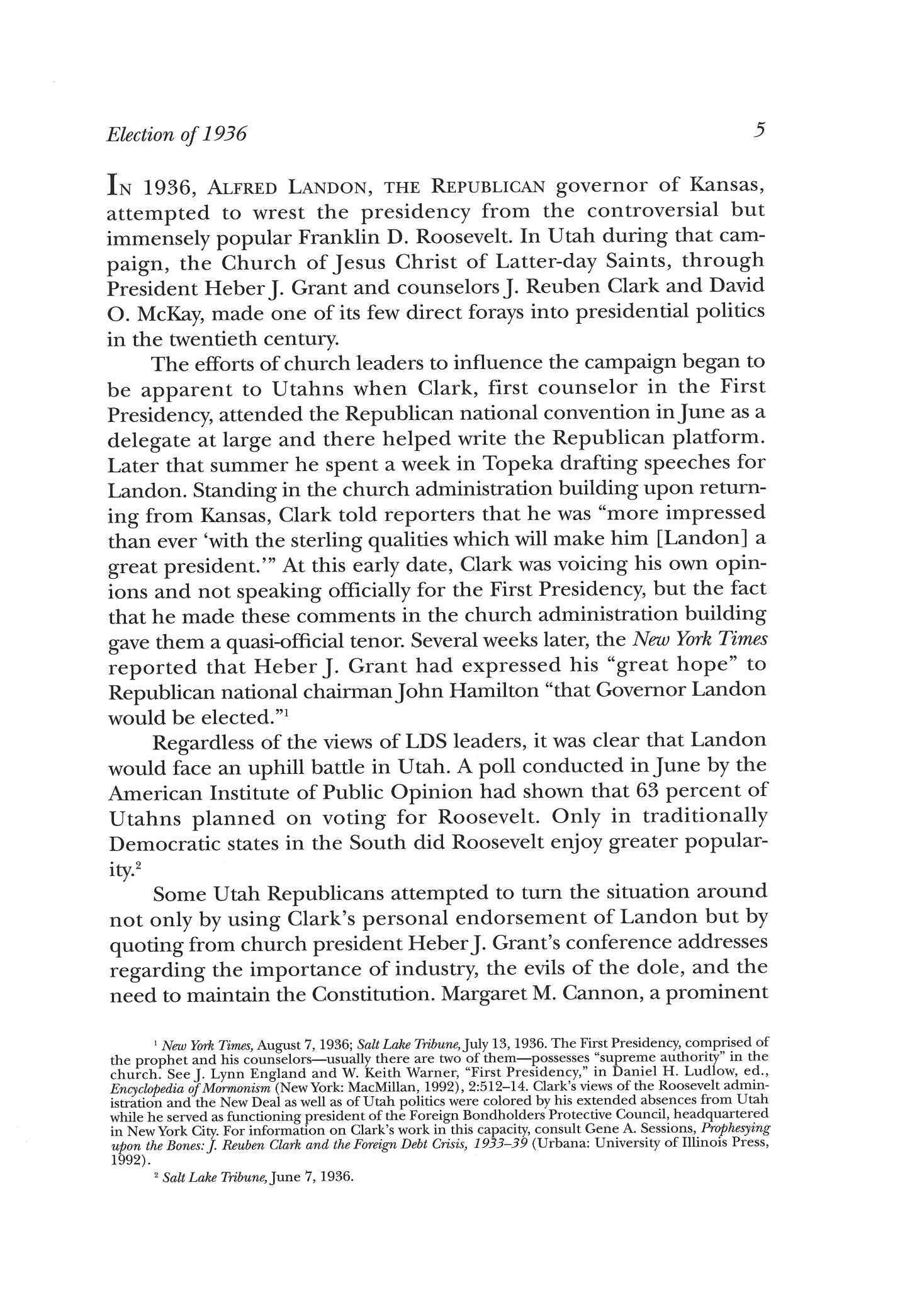
1 New York Times, August 7, 1936; Salt Lake Tribune, July 13, 1936 The First Presidency, comprised of the prophet and his counselors—usually there are two of them—possesses "supreme authority" in the church See J Lynn England and W Keith Warner, "First Presidency," in Daniel H Ludlow, ed., Encyclopedia ofMormonism (New York: MacMillan, 1992), 2:512-14 Clark's views of the Roosevelt administration and the New Deal as well as of Utah politics were colored by his extended absences from Utah while he served as functioning president of the Foreign Bondholders Protective Council, headquartered in New York City For information on Clark's work in this capacity, consult Gene A Sessions, Prophesying upon the Bones:J. Reuben Clark and the Foreign Debt Crisis, 1933-39 (Urbana: University of Illinois Press, 1992)
2 Salt Lake Tribune, June 7, 1936
Election of 1936 5
figure in the state Republican party, attended many party rallies "where they have opened with a good Mormon prayer and they have sung the customary hymns and also have related what Pres. Grant has said at Conference." 3 Although there could be little doubt in the minds of church members how the First Presidency, and especially Presidents Grant and Clark, would vote in November, the First Presidency had still balanced Clark's vigorous work in Landon's behalf with an official statement on July 3 denouncing Communism but proclaiming, "The Church does not interfere, and has no intention of trying to interfere, with the fullest and freest exercise of the political franchise of its members, under and within the Constitution."4
3 Margaret M Cannon toJ Reuben Clark QRC],July 21, 1936, Folder 1, Box 348, J Reuben Clark Papers [JRCP], Archives and Manuscripts, Harold B Lee Library, Brigham Young University
4 Deseret News, July 3, 1936 Heber J Grant, a one-time Democrat, had become disillusioned with the Democratic Party by this time. As Thomas G. Alexander has noted, Grant "looked at political matters principally from a moralistic or tenure perspective Republican, Democratic or Independent persuasion mattered less to him than did his perception of the morality or experience of the candidate." The Democrats' attempts to repeal Prohibition early in the decade contributed heavily to Grant's disdain for the party and for Roosevelt. Still, James Henry Moyle believed that Grant "was a conservative Democrat up to the time of the death of his counselor and greatly-loved cousin, Anthony W Ivins, in 1934." Ivins was
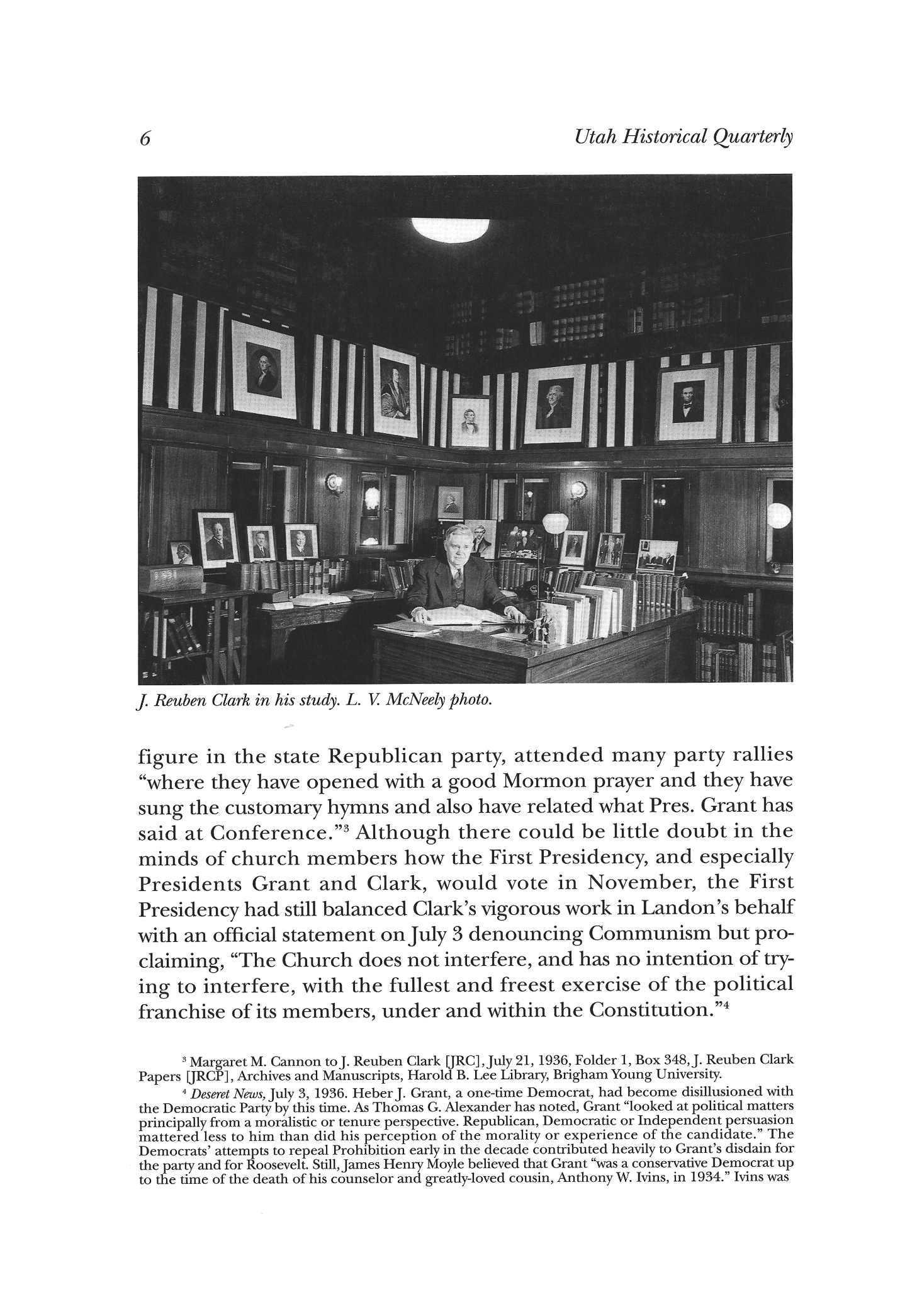
Utah Historical Quarterly
f. Reuben Clark in his study. L. V. McNeely photo.
By fall, with Roosevelt's immense popularity and the First Presidency's commitment to political non-interference, the situation looked bleak for Landon among Utah voters, including the Mormon electorate The first installment of a two-month poll conducted by the Salt Lake Tribune—in which polling cards were to be mailed to every fourth person whose name appeared on voter registration rolls across the state—showed Roosevelt in the lead with 67 percent of the vote, about ten more percentage points than he had garnered in 1932.J. R. Fitzpatrick, the politically conservative publisher of the Salt Lake Tribune and a political friend of Clark's, had commiserated on September 9 in a letter to Clark reporting the results: "Only wish I had some better news to give you."5 Subsequent installments of the Tribune's poll showed a similar pattern of support for Roosevelt. Hoping to boost Landon's morale, Clark wrote to him late in September questioning the accuracy of the polls: "I find it most difficult to believe that the Tribune Poll now being conducted represents the facts." He felt instead that Landon's radio broadcasts were producing "a change of sentiment here in favor of yourself."6
Clark desired to accelerate that supposed change in sentiment but feared that direct efforts might backfire. Late in September the Republican National Committee asked Clark to deliver at least a dozen speeches in Utah supporting Landon, and Clark nearly decided to do so. His brother Ted helped to dissuade him, though. "I am fully convinced that if you go on the stump here among the Saints that much . . . respect and good feeling towards you will change. As it has to all the other leaders who have done it," Ted warned. "Many of your own side will lose confidence if you do." So Clark refused to speak for Landon in Utah "If I were to take the stump in this State, I would solidify opposition rather than gain votes," he explained Clark did agree to speak at rallies elsewhere in the West that month, though.7
For his part, Heber J. Grant—who "deep[ly] regret[ted]" that Roosevelt had defeated Herbert Hoover in 1932, hoped that Roosevelt
a strong Democrat Thereafter, under the influence ofJ Reuben Clark and David O McKay and his own objections as a fiscal conservative to New Deal financing and welfare programs, Grant became "more of a Republican than a Democrat." Thomas G Alexander, Mormonism in Transition: A History of theLatter-day Saints, 1890-1930 (Urbana: University of Illinois Press, 1986), 37, 44-45, 57; Gene A Sessions, Mormon Democrat: The Religious and Political Memoirs ofJames Henry Moyle (Salt Lake City: Signature Books, 1998), 282,286

5 Salt Lake Tribune, September 6, 1936; J R Fitzpatrick toJRC, September 9, 1936, Folder 2, Box 348JRCP
6 JRC to Alfred M Landon, September 28, 1936, Folder 9, Box 347, JRCP
7 Ted [Clark] to JRC, October 1, 1936, Folder 1, Box 337; Fred S Purnell to JRC, September 24, 1936, Folder 5, Box 347; JRC to Purnell, October 7, 1936, Folder 5, Box 347, JRCP; D Michael Quinn,/ Reuben Clark: The Church Years (Provo: Brigham Young University Press, 1983), 75
Election of 1936 7
would be defeated in 1936, distrusted Roosevelt's motives for deficit spending, disdained Roosevelt's liberal interpretation of Constitutional limits on the federal government, and feared that federal welfare programs would debauch the populace—criticized the New Deal in his opening address at the church's October general conference. Although he admitted that some work-relief projects were constructive, he warned that the dole could "ruin" the nation, advised farmers not to participate in New Deal crop reduction schemes, and criticized laborers on a work-relief project near his home who seemed to be wasting government funds by "goingjust about as slowly as they possibly can."8
On October 26, Clark returned to Utah after ten days on the campaign trail for Landon. Just eight days remained before the election, and all of the polls showed Roosevelt leading substantially in Utah "I am afraid that in Utah Roosevelt is sufficiently in the lead to drag along with him the State Ticket," Clark confided The latest installment of the Tribune's poll showed Roosevelt carrying 68 percent of the vote. National opinion polls conducted by Literary Digest and the American Institute of Public Opinion likewise showed Roosevelt leading in the state.9
United in their support for Landon and their opposition to Roosevelt, the First Presidency knew that they could use the Deseret News, the church's "official organ," to disseminate their political views. Indeed, they had used the News and its reporting of conditions in Spain the previous summer to indirectly "vindicate our position on Communism." In cases such as the reporting on Spain, views of church leaders were promulgated in articles and editorials that never mentioned the church or its leaders "At any time you wish to write me anything confidential I think I can carry it [in the paper] without involving you at all," Samuel O. Bennion, the general manager of the paper, had assured Clark.10
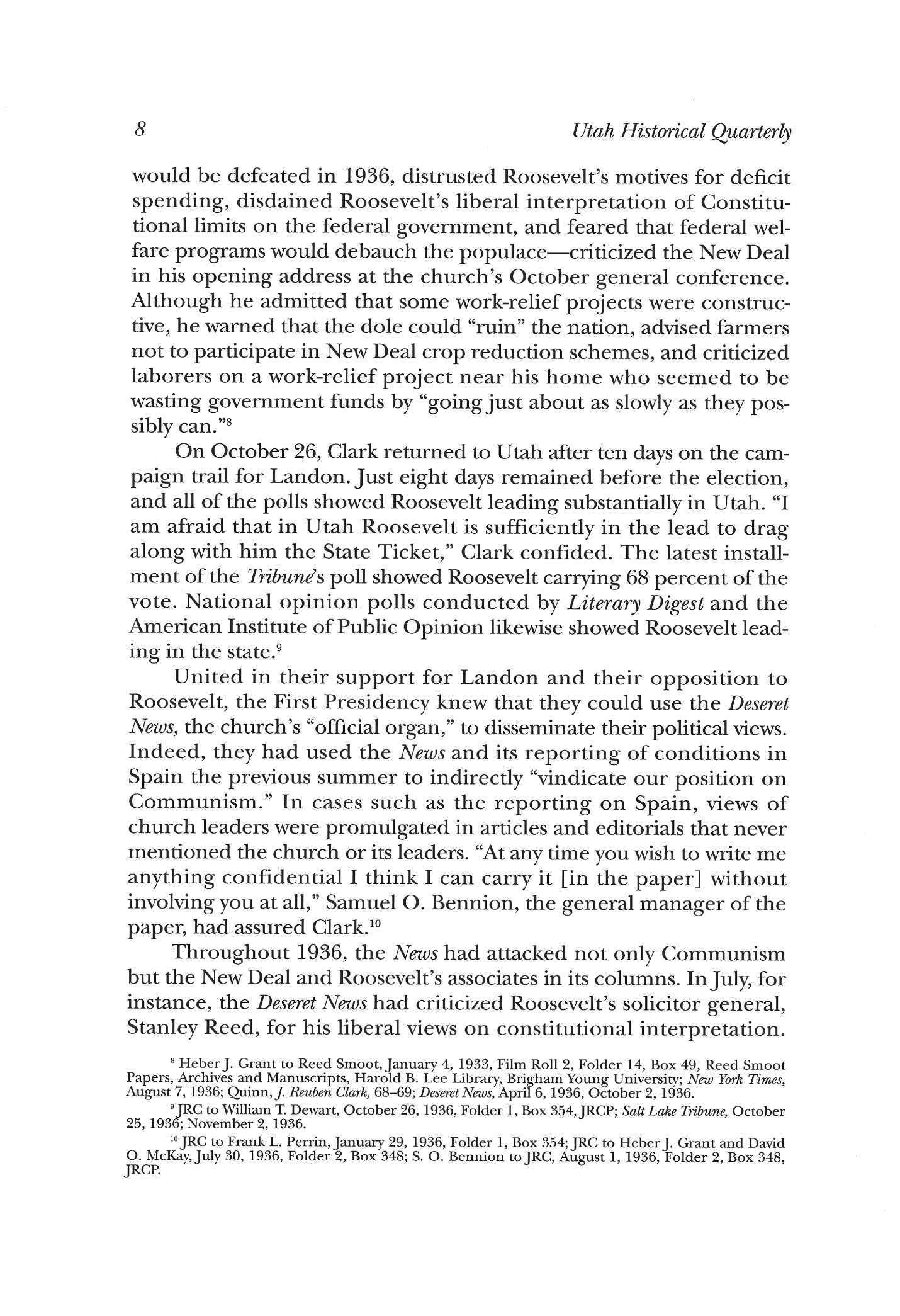
Throughout 1936, the News had attacked not only Communism but
the New Deal and Roosevelt's associates in its columns InJuly, for instance, the Deseret News had criticized Roosevelt's solicitor general, Stanley Reed, for his liberal views on constitutional interpretation.
8 Heber J Grant to Reed Smoot, January 4, 1933, Film Roll 2, Folder 14, Box 49, Reed Smoot Papers, Archives and Manuscripts, Harold B Lee Library, Brigham Young University; New York Times, August 7, 1936; Quinn,/ Reuben Clark, 68-69; Deseret News, April 6, 1936, October 2, 1936
9 JRC to William T Dewart, October 26, 1936, Folder 1, Box 354, JRCP; Salt Lake Tribune, October 25, 1936; November 2, 1936
10 JRC to Frank L. Perrin, January 29, 1936, Folder 1, Box 354; JRC to Heber J. Grant and David O McKay, July 30, 1936, Folder 2, Box 348; S O Bennion to JRC, August 1, 1936, Folder 2, Box 348, JRCP
8 Utah Historical Quarterly
Election of 1936
Indeed, to DemocratJames Henry Moyle it seemed that the paper had become "against almost everything President Roosevelt advocated."11 Some Republicans, though, thought the criticism had been too restrained In September staunch Republican Benjamin L Rich complained to Clark about a pussyfooting editorial policy that "minimizes the effect of criticism of the administration" in Deseret News articles. He observed, "If the administration is not to be criticized for its disregard of Constitutional Government as expressed in the principles underlying NRA and AAA and a lot of other of those things, then it is just too bad for the Constitution in Utah." Clark admitted that his own "feelings were not far away from full brotherhood to yours."12
The First Presidency, however, was sustained by members of a church that in 1936 was predominantly comprised of people who characterized themselves as Democrats and supported the New Deal Moreover, Grant, Clark, and David O. McKay had professed the church's political neutrality in an official statement three months earlier and had just managed to extricate the church from allegations of unfairness and ecclesiastical influence occasioned by Clark's public endorsement of a candidate for the Republican gubernatorial nomination.13 It was also possible that an official church endorsement of Landon would produce the same type of backlash that Clark feared

11 Deseret News,July 17, 1936; Sessions, Mormon Democrat, 284
12 Benjamin L Rich to JRC, September 15, 1936; JRC to Rich, September 23, 1936, Folder 2, Box 354, JRCP. NRA was the National Recovery Administration; AAA was the Agricultural Adjustment Administration
IS Salt Lake Tribune, March 15, 1936; Heber J Grant and David O McKay to JRC, August 13, 1936; JRC to Grant, August 14, 1936; McKay to JRC, August 14, 1936, Folder 2, Box 348, JRCP Clark endorsed D H Christensen, who lost in the primary election to Ray E Dillman
HeberJ. Grant and David 0. McKay, 1937. Salt Lake Tribune photo.
would arise if he stumped the state. So although the Deseret News offered church leaders a means of airing their views, there were reasons to exercise caution about promulgating those views too forcefully. Against this backdrop, the Mining and Contracting Review, a weekly miningjournal edited by Burt B Brewster, on October 27 chastised all three Salt Lake papers but especially the Deseret News, whose "heads . . . know what things are all about," for not having taken "some definite editorial stand on national and state politics." The editorial continued, "Either the owners or the editorial staffs, we know not which, unless lightning strikes while this is being written, have given the greatest exhibition of sniveling, weakkneed, and cowardly, middle of the road editorial policy—on both major sides of national politics— exhibited by any papers supposed to show character in the United States." The editorial's effect upon the First Presidency is unclear, although they did see it; Clark received a copy from his ardent Republican friend Ben Rich along with a letter warning him that "unless we have in Utah some daily newspaper which adopts, maintains, and prosecutes a continuous, vigorous, patriotic American policy, the Republican party might as well fold up."14
Whether or not Rich's letter or the editorial in the Mining and Contracting Review exerted any influence, the Deseret News soon delivered what Rich and other Republicans had hoped for: an unequivocal front-page editorial castigating the incumbent and endorsing his opponent—without naming either one Citing Grant's diary, which is now closed to research, D Michael Quinn concluded that the decision to run the editorial stemmed not from Clark's partisanship but from Grant's own conviction that, because of the serious issues at stake, "the First Presidency would have to take a very strong stand." Marion G. Romney's recollections of a conversation with Heber J. Grant support Quinn's conclusion. Grant, Romney recalled, told him, "I know they charge President Clark with this editorial, but President Clark told me not to publish it. He said they would say, 'You are using the paper for political purposes.' But I put the editorial on the front page of the news over his objections."15
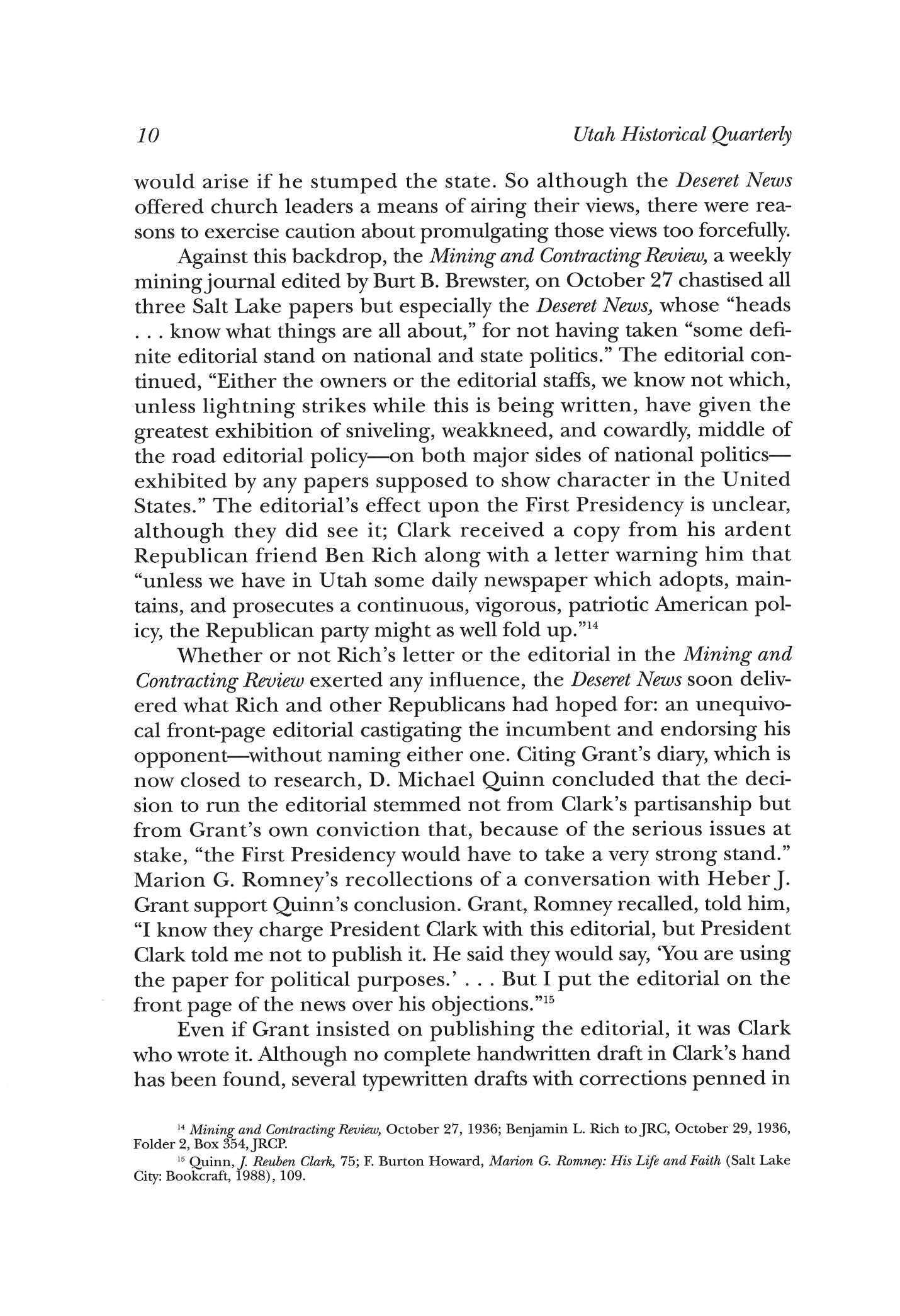
Even if Grant insisted on publishing the editorial, it was Clark who wrote it. Although no complete handwritten draft in Clark's hand has been found, several typewritten drafts with corrections penned in
14 Mining and Contracting Review, October 27, 1936; Benjamin L Rich to JRC, October 29, 1936, Folder 2, Box 354, JRCP.
15 Quinn, J. Reuben Clark, 75; F Burton Howard, Marion G. Romney: His Life and Faith (Salt Lake City: Bookcraft, 1988), 109
10 Utah Historical Quarterly
Election of 1936 H
the margins in Clark's hand do exist, and the arguments and examples advanced closely resemble those found in speeches Clark wrote for Landon.16 The editorial began by quoting Section 101 of the LDS Doctrine and Covenants, with a slight modification in verb tense, to demonstrate that God had established the Constitution and that he had "asserted that this Constitution 'should be maintained for the rights and protection of all flesh, according to just and holy principles.'"17
Having argued for the Constitution's divine origins, the editorial proceeded to outline Roosevelt's attitudes toward the document. The News alleged that the president had "characterized the Constitution as of 'horse and buggy days,'" a reference to a favorite whipping boy of conservatives. Roosevelt had made this spontaneous comment in a press conference on May 31, 1935, four days after the Supreme Court had ruled against the National Recovery Act, a key piece of New Deal legislation. In its decision the Court had narrowly interpreted the interstate commerce clause in the Constitution, ruling that the clause conferred upon the federal government only the right to regulate the actual shipment of goods between states Roosevelt complained, "The country was in the horse-and-buggy age when that clause was written." Now, in an era when the nation's economic and political spheres were far more integrated and when a broad interpretation of that clause was needed in order to permit the federal government to "administer laws that have a bearing on, and general control over, national economic problems and national social problems," Roosevelt had lamented, "we have been relegated to the horse-and-buggy definition of interstate commerce."18
Although Roosevelt had singled out one clause in the Constitution and although the phrase, as Thomas Alexander has observed, correctly characterized modes of travel in the eighteenth century, conservatives like Clark argued that the statement not only revealed Roosevelt's perception of the document as outmoded but also his desire to broaden in "a tyrannical fashion" presidential power at the expense of the states.19
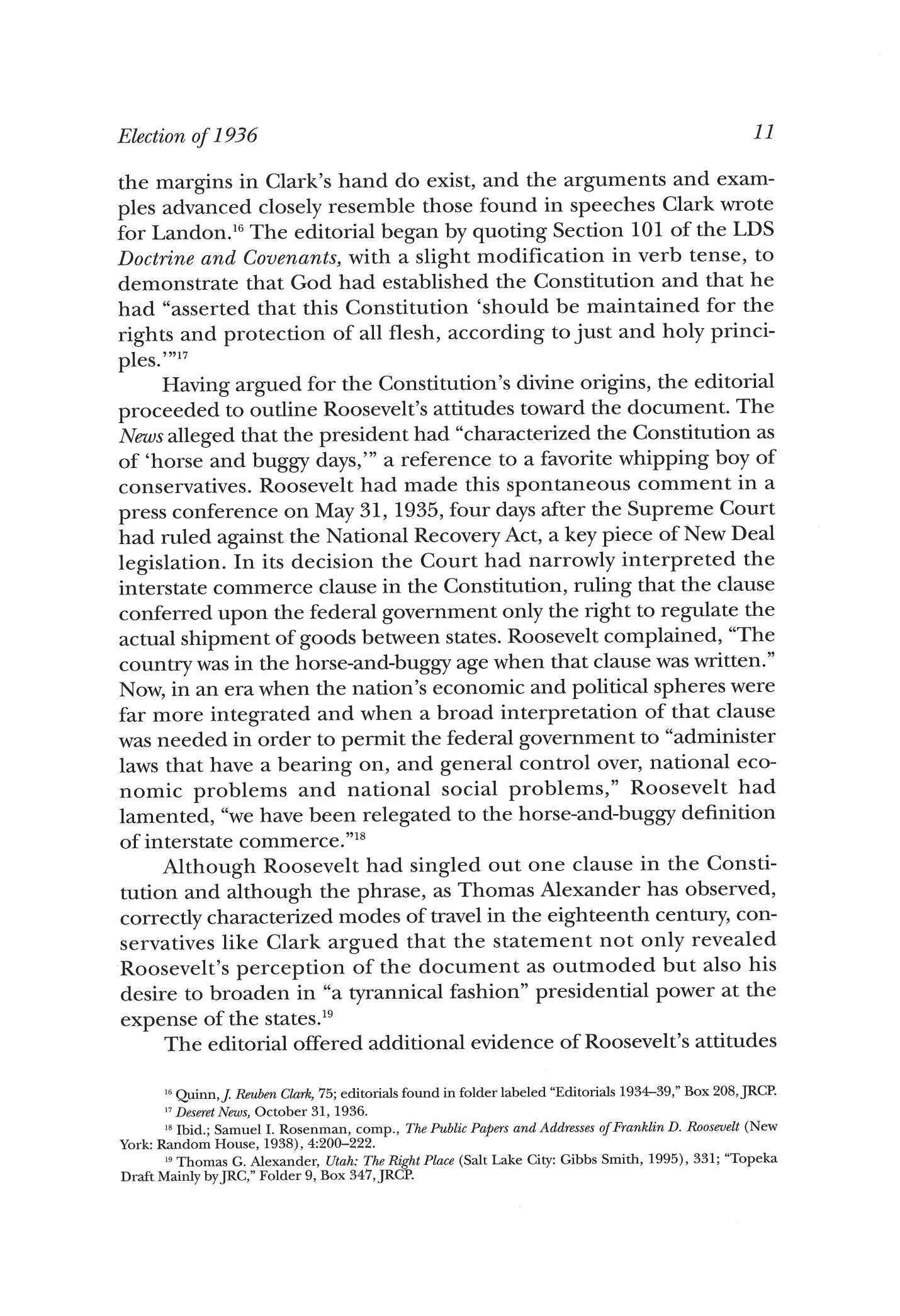
16 Quinn, / Reuben Clark, 75; editorials found in folder labeled "Editorials 1934-39," Box 208, JRCP
17 Deseret News, October 31, 1936
18 Ibid.; Samuel I. Rosenman, comp., The Public Papers and Addresses ofFranklin D. Roosevelt (New York: Random House, 1938), 4:200-222.
19 Thomas G Alexander, Utah: The Right Place (Salt Lake City: Gibbs Smith, 1995), 331; "Topeka Draft Mainly byJRC," Folder 9, Box 347, JRCP
The editorial offered additional evidence of Roosevelt's attitudes
toward the Constitution, mentioning that he had "advised members of Congress to join in enacting laws irrespective of the belief of the Congressmen as to the constitutionality of such laws." Here Clark referred to aJuly 6, 1935, letter Roosevelt wrote to Chairman Hill of the House Committee on Ways and Means. Roosevelt had advised, "I hope your committee will not permit doubts as to constitutionality, however reasonable, to block the suggested legislation [Guffey-Snyder Coal Bill]." The editorial noted that the president who had made these statements was sworn to "preserve, protect, and defend the Constitution." In earlier drafts of the editorial, Clark had also reiterated common charges that Roosevelt was a Communist, noting that even some Democrats had "publicly accuse [d] him of sympathy or affiliation with Communism," but this allegation was removed before the editorial was printed.20

Having castigated the incumbent without mentioning his name, the editorial praised Landon as "the other candidate" because he had "declared he stands for the Constitution and for the American system of government which it sets up." Noting the LDS church's affinity for "constitutional government" the editorial concluded, "Church members, who believe the revelations and the words of the Prophet, must stand for the Constitution Every patriot, loving his country and its institutions, should feel in duty bound to vote to protect it."21
20 Deseret News, October 31, 1936; typewritten draft of editorial entitled "The Constitution," folder entitled "Editorials 1934-39," Box 208, JRCP; James P Warburg, "Hell-Bent for Election," Washington Post, September 17, 1935, copy in Folder 3, Box 88, Smoot Papers; New York Herald Tribune, March 23, 1935, clipping in folder entitled "Roosevelt," Box 314, JRCP On the passage of the Guffey-Snyder Act of 1935, see William E Leuchtenburg, Franklin D. Roosevelt and the New Deal, 1932-1940 (New York: Harper and Row, 1963), 161-62
21 Deseret News, October 31, 1936 The entire editorial reads: "More than one hundred years ago the Lord declared: 'I establish the Constitution of this land, by the hands of wise men whom I raised up unto this very purpose.' In the same revelation He asserted that this Constitution 'should be maintained for the rights and protection of all flesh, according to just and holy principles.'
"For many weeks The News has carried at the head of its editorial column a statement by the Prophet Joseph giving his view of the origin, purpose, and virtue of the Constitution The Prophet also declared the peculiar relationship which the people of the Church have towards the Constitution and its preservation
"We are nearing the end of a Presidential campaign
"The issues of the campaign touching the Constitution seem clearly and squarely drawn
"One candidate has characterized the Constitution as of 'horse and buggy days,' he has advised members of Congress to join in enacting laws irrespective of the belief of the Congressmen as to the constitutionality of such laws The great bulk of the pivotal legislation passed by Congress at his request, to carry out his views, has been pronounced unconstitutional Even though publicly asked to declare his intention in the matter, he has thus far failed to say that he will not continue to carry out the principles of his earlier legislation which the Supreme Court has declared unconstitutional He keeps his silence in face of the fact that if he be elected he must take an oath—the same which he took when he first became President—that 'I do solemnly swear (or affirm) that I will faithfully execute the office of President of the United States, and will to the best of my ability, preserve, protect, and defend the Constitution of the United States [']
"The other candidate has declared he stands for the Constitution and for the American system of government which it sets up He makes it clear that he will keep inviolate the oath which he must take as President of the United States He has shown himself to be an honest, truthful man, a patriotic efficient public servant
12 Utah Historical Quarterly
Although Clark wrote the editorial, it reflected the position of all three members of the First Presidency and was approved by each of them Writing to David O McKay the following year, Clark referred to the document along with two subsequent editorials as "our Deseret News editorials."22
The editorial, showcased on the front page and opposing not specific policies but the personification of the entire New Deal, was far more strident and controversial than the paper's previous depressionera editorials Although it did not directly link the first presidency to the message, O. N. Malmquist, political columnist for the Tribune in the 1930s, believed that it was "doubtful that the church leadership had ever taken a stronger stand against one candidate and for another, either publicly or within organization ranks, than in the 1936 election."23
Predictably, therefore, the editorial raised a "rumpus." Its tone was less strident than that of an editorial appearing the following morning in the Salt Lake Tribune that criticized Roosevelt even more heavily, accused his administration of sympathizing with Communism, and argued that "the election of Governor Landon . . . is the quickest and surest way back to constitutional government and the American tradition." Nevertheless the News's statement attracted more attention because of its ties to the LDS church. Utah Republicans hailed the editorial, along with the Tribune's endorsement of Landon, as "courageous" and in last-minute campaigning they attempted to capitalize upon the constitutional arguments, billing their candidates as defenders of the Constitution. "After having the issues discussed and after reading the courageous editorials in Utah's two great daily papers . . . are you not convinced that there are more vital issues in this campaign than have confronted the citizens of this great nation since the Civil War?" a Republican advertisement queried. "Only in the Republican party platform can a citizen
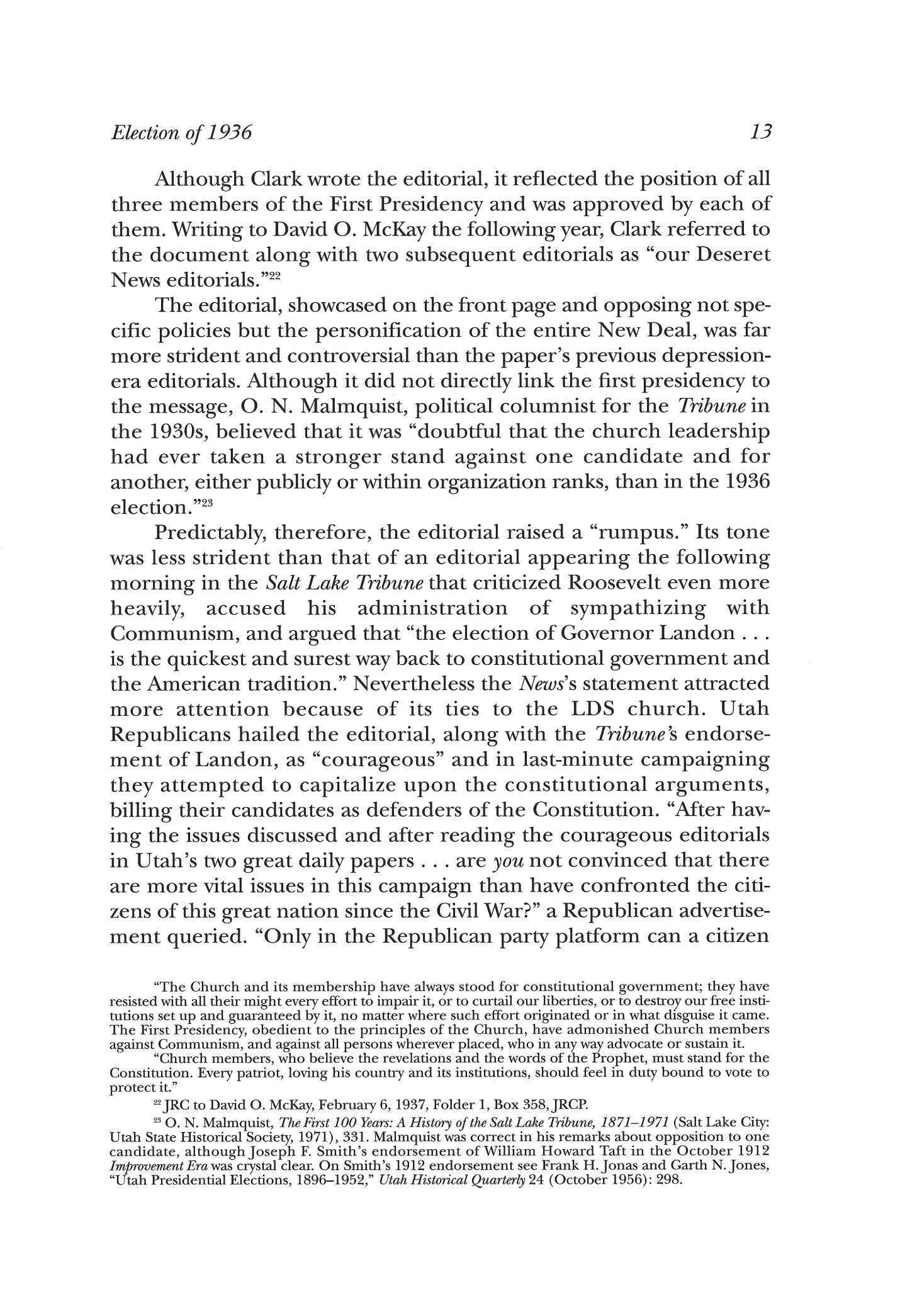
"The Church and its membership have always stood for constitutional government; they have resisted with all their might every effort to impair it, or to curtail our liberties, or to destroy our free institutions set up and guaranteed by it, no matter where such effort originated or in what disguise it came The First Presidency, obedient to the principles of the Church, have admonished Church members against Communism, and against all persons wherever placed, who in any way advocate or sustain it "Church members, who believe the revelations and the words of the Prophet, must stand for the Constitution Every patriot, loving his country and its institutions, should feel in duty bound to vote to protect it."
22 JRC to David O McKay, February 6, 1937, Folder 1, Box 358, JRCP
23 O. N. Malmquist, The First 100 Years: A History of the Salt Lake Tribune, 1871-1971 (Salt Lake City: Utah State Historical Society, 1971), 331 Malmquist was correct in his remarks about opposition to one candidate, although Joseph F Smith's endorsement of William Howard Taft in the October 1912 Improvement Era was crystal clear On Smith's 1912 endorsement see Frank H.Jonas and Garth N.Jones, "Utah Presidential Elections, 1896-1952," Utah Historical Quarterly 24 (October 1956): 298.
Election of 1936 13
feel certain that his constitutional rights will continue to be enjoyed," declared national committeeman George W. Snyder the day before the election Jesse R Smith, a Mormon attorney practicing in the nation's capital, aptly expressed the views of Republican Mormons who supported the editorial "I for one wholeheartedly commend the leaders of the Church for the position they have taken in connection with our duties and responsibilities as American citizens. When a cardinal principle of our faith is placed in jeopardy, albeit through the forces of political campaign, there can be but one position for every thoughtful Latter-day Saint."24
Some Democrats were amused: A S. Brown, National Democratic Committeeman for Utah, reportedly quipped, "If the Deseret News and the Mormon church can carry the state of Utah for Alf Landon, I'll join the church because I'll have seen a miracle." Most Utah Democrats were shocked or embittered rather than amused, though Taking no chances, Democratic politicians disputed the editorial, billing Roosevelt as a defender and savior of the Constitution. At a rally in Bingham the night before the election, state Democratic chairman Calvin W. Rawlings, an active Mormon, labeled the attacks on Roosevelt "false and unwarranted" and claimed that "President Roosevelt saved the Constitution and our democracy against the only threat of their destruction in my lifetime or yours." Pointing out that great presidents likeJefferson, Jackson, and Lincoln had acted beyond the scope of the Constitution in "champion [ing] the cause of the com-

14 Utah Historical Quarterly
E. 0. Howard, president of Walker Bank and Trust, and A. S. Brown, National Democratic Committeemanfor Utah, at chamber of commerce breakfast meeting in 1938. Salt Lake Tribune photo.
24 JRC to David O McKay, February 6, 1937, Folder 1, Box 358; Jesse R Smith to JRC, November 3, 1936, Folder 2, Box 354, JRCP; Salt Lake Tribune, November 1, 1936; Salt Lake Tribune, November 2, 1936; Salt Lake Tribune, November 3, 1936
mon people," Rawlings reminded his audience that Roosevelt's "horse and buggy" remark had been a spontaneous reaction to the Supreme Court's decision Democrats also took indirect aim at the editorial Governor Henry Blood indirectly referred to it and similar statements as a "last minute effort . . . aimed at arousing animosity, hatred and prejudice," while Rawlings labeled such efforts "slanderous."25
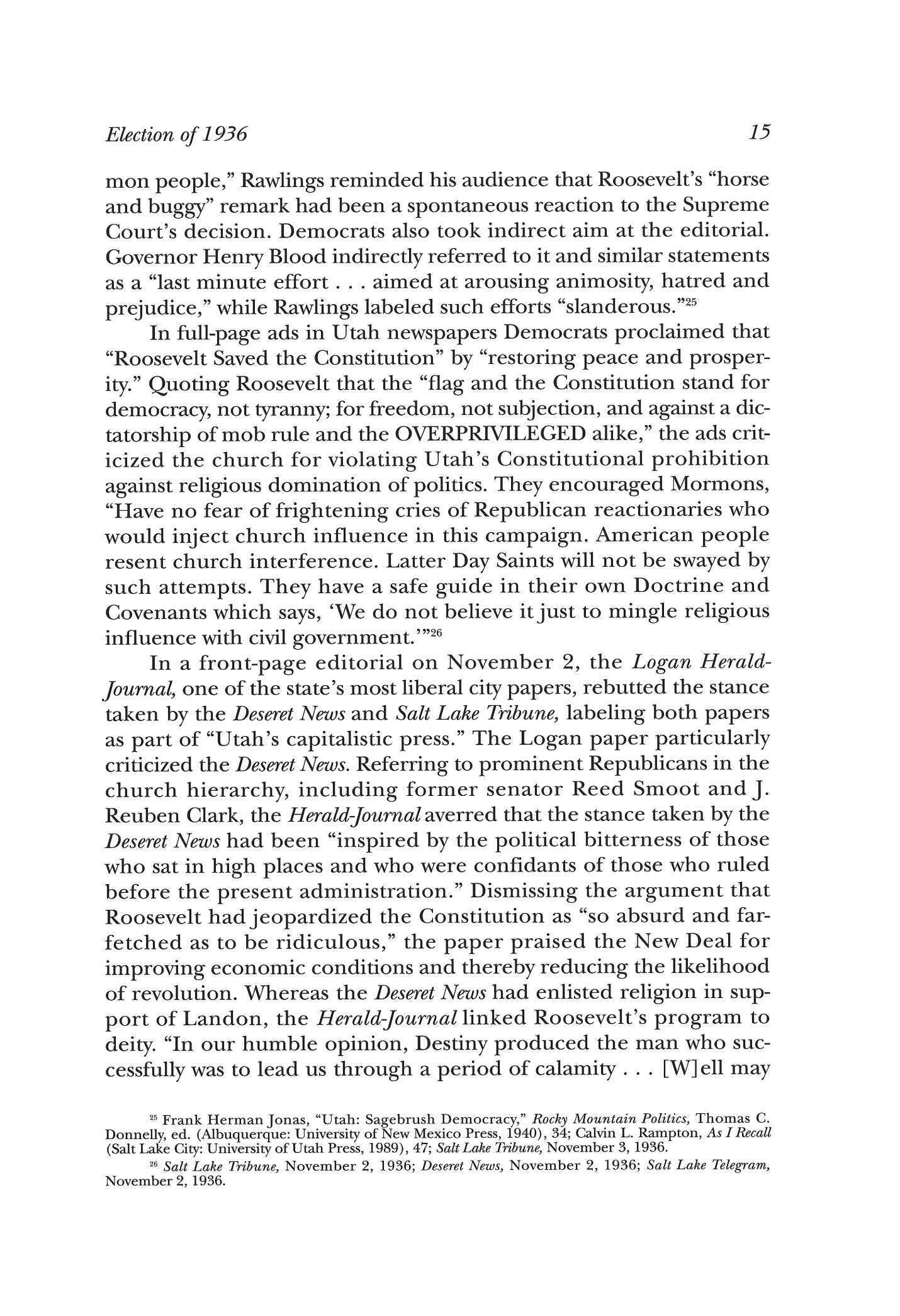
In full-page ads in Utah newspapers Democrats proclaimed that "Roosevelt Saved the Constitution" by "restoring peace and prosperity." Quoting Roosevelt that the "flag and the Constitution stand for democracy, not tyranny; for freedom, not subjection, and against a dictatorship of mob rule and the OVERPRTVILEGED alike," the ads criticized the church for violating Utah's Constitutional prohibition against religious domination of politics They encouraged Mormons, "Have no fear of frightening cries of Republican reactionaries who would inject church influence in this campaign. American people resent church interference. Latter Day Saints will not be swayed by such attempts. They have a safe guide in their own Doctrine and Covenants which says, 'We do not believe itjust to mingle religious influence with civil government.'"26
In a front-page editorial on November 2, the Logan HeraldJournal, one of the state's most liberal city papers, rebutted the stance taken by the Deseret News and Salt Lake Tribune, labeling both papers as part of "Utah's capitalistic press." The Logan paper particularly criticized the Deseret News. Referring to prominent Republicans in the church hierarchy, including former senator Reed Smoot and J. Reuben Clark, the Herald-Journal averred that the stance taken by the Deseret News had been "inspired by the political bitterness of those who sat in high places and who were confidants of those who ruled before the present administration." Dismissing the argument that Roosevelt had jeopardized the Constitution as "so absurd and farfetched as to be ridiculous," the paper praised the New Deal for improving economic conditions and thereby reducing the likelihood of revolution Whereas the Deseret News had enlisted religion in support of Landon, the Herald-Journal linked Roosevelt's program to deity. "In our humble opinion, Destiny produced the man who successfully was to lead us through a period of calamity . . . [W]ell may
25 Frank Herma n Jonas, "Utah: Sagebrush Democracy," Rocky Mountain Politics, Thomas C Donnelly, ed (Albuquerque: University of New Mexico Press, 1940), 34; Calvin L Rampton, As I Recall (Salt Lake City: University of Utah Press, 1989), 47; Salt Lake Tribune, November 3, 1936
26 Salt Lake Tribune, November 2, 1936; Deseret News, November 2, 1936; Salt Lake Telegram, November 2, 1936
Election of 1936 15
the American people thank God for giving us a fearless, daring pilot."27
On the eve of the election, the Deseret News, as a response to criticism that the church had taken a partisan stance after having pledged not to interfere politically, printed a second editorial by Clark. Reiterating the First Presidency statement ofJuly 3, 1936, that "the Church does not interfere, and has no intention of trying to interfere, with the fullest and freest exercise of the political franchise of its members," the News justified its October 31 volley on the grounds that "great moral issues are involved" and that "great principles of Church belief or doctrine are in peril." The paper "would be recreant to the public trust... if it did not tell the people of its views on great public questions." Although an earlier draft of this editorial had guaranteed only that the church would not "discipline" members for supporting Roosevelt, the final version went further and pledged that the church would not "look with disfavor upon any member for the free exercise of his franchise."28

On election day, in a state where nearly seven in ten residents were LDS, 69.3 percent of Utah's voters endorsed Franklin D Roosevelt at the polls. Only Kane County registered more votes for Landon than for Roosevelt. "Obviously the people have not learned their lesson. The largesse of the Emperor still speaks with the multitude," Clark ruefully remarked. If anything, support for Roosevelt had solidified following the editorial. Only 66.6 percent of the respondents polled by the Tribune in the last two weeks of October indicated that they would vote for Roosevelt at the polls, but 69.3 percent of Utah's voters did so—a higher percentage than in any of the installments of
27 Logan Herald Journal, November 2, 1936 In particular, Apostle Reed Smoot, who in 1932 had been defeated in his bid for reelection after having represented Utah in the U.S. Senate for nearly thirty years, had been a strong supporter of the Hoover Administration Hoover campaigned for Smoot in Utah just before that election, praising his work in the Senate For information on the 1932 Smoot campaign and Herbert Hoover's role in it, see Milton R Merrill, Reed Smoot: Apostle in Politics (Logan: Utah State University Press, 1990), 135-37, 230, 232-33.
28 Deseret News, November 2, 1936; typescript draft of editorial entitled "A Principle of Church Rule," folder labeled "Editorials 1934-39," Box 208, JRCP The final version in its entirety reads, "In their Signed statement ofJuly 3, 1936, regarding Communism, the First Presidency said: "'The Church does not interfere, and has no intention of trying to interfere, with the fullest and freest exercise of the political franchise of its members, under and within the Constitution, which the Lord declared: "I established .. . by the hands of wise men whom I raised up unto this very purpose," and which as to the principles thereof, the Prophet, dedicating the Kirtland Temple, prayed should be "established forever.'"
"The NEWS understands this to be the rule of the Church It would regard as UnAmerican any suggestion that the Church would look with disfavor upon any member for the free exercise of his franchise.
"But where great moral issues are involved or where great principles of Church belief or doctrine are in peril, the NEWS as a responsible newspaper reaching thousands of readers feels it would be recreant to the public trust which its character necessarily vests in it, if it did not tell the people of its views on great public questions."
16 Utah Historical Quarterly
the Tribunes two-month poll. Roosevelt in 1936 received a higher percentage of the vote than had any previous presidential candidate in Utah, aside from William Jennings Bryan in 1896 Not until Richard Nixon's landslide reelection in 1972 would a candidate for president again receive as high a percentage of the votes as Roosevelt received that year. 29
Roosevelt's stunning success notwithstanding, the editorial had led to much soul-searching among some loyal Democrats and did persuade some of them to vote for Landon Marion G Romney, a Mormon bishop and Democratic state legislator working on a campaign committee in Salt Lake County, resigned from the committee and publicly broke with the Democrats after reading the editorial and praying about it for three hours. In the Salt Lake Seventeenth LDS Ward testimony meeting on the day after the editorial appeared, three of the first four speakers announced their intention to vote for Landon as a result of the editorial. Even more statements might have been forthcoming if the bishop had not asked the congregation to desist from further political commentary in the meeting.
Although she almost certainly voted for Roosevelt, one member of the Seventeenth Ward congregation, Edna Thomas, whose husband, Senator Elbert Thomas, was in California at the time campaigning for Roosevelt, felt particularly torn in her loyalties. After the election she and her husband attended a dinner party where the Deseret News and its editorial campaign were roundly condemned. Returning from the party she confided in her diary, "I came home feeling quite guilty because we had made so much fun of Pres. Grant and criticized the writing of the editorial in the News. I really feel quite guilty I receive many, many blessings, that I do not show much appreciation [for] when I make fun of sacred things."30
The day after the election, the News printed a third editorial by Clark, acknowledging that Roosevelt had been re-elected by constitutional means and that any attempt to "modify or change that decision" must be "by constitutional means and not by force." The editorial concluded by reiterating the paper's right and obligation to speak out on "great public questions."31
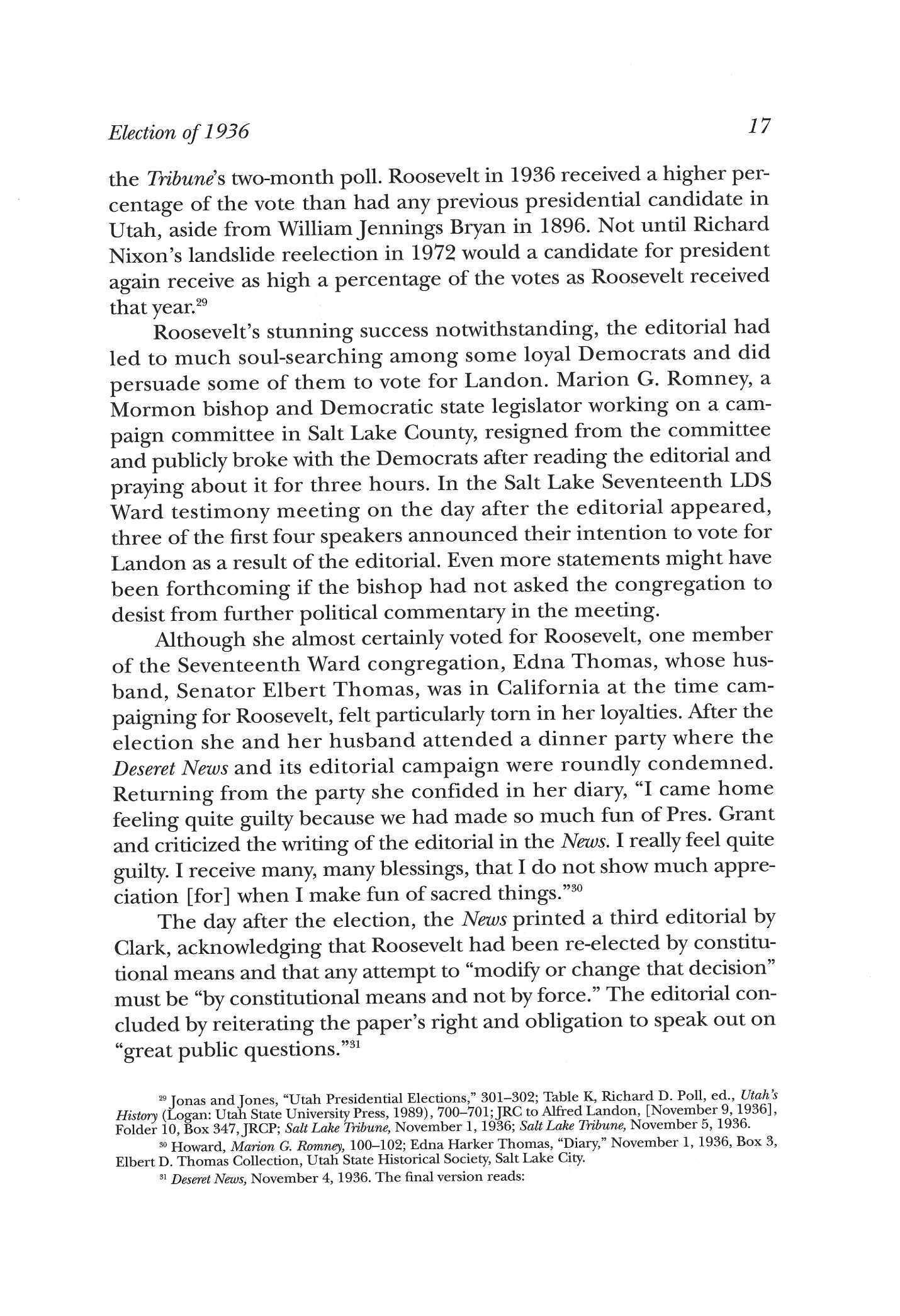
29 Tonas and Tones, "Utah Presidential Elections," 301-302; Table K, Richard D. Poll, ed., Utah's History (Logan: Utah State University Press, 1989), 700-701; JRC to Alfred Landon, [November 9 1936], Folder 10, Box 347, JRCP; Salt Lake Tribune, November 1, 1936; Salt Lake Tribune, November 5, 1936.
30 Howard, Marion G. Romney, 100-102; Edna Harker Thomas, "Diary," November 1, 1936, Box 3, Elbert D Thomas Collection, Utah State Historical Society, Salt Lake City
31 Deseret News, November 4, 1936 The final version reads:
Election
•*•'
of 1936
An earlier draft of the editorial contained statements that were removed before the editorial was published. Reminding the readers that the paper had editorialized against repeal of Prohibition and that the public had disregarded that appeal, the draft noted, "Few who think and know will deny that conditions are far worse today than under Prohibition." Now the readers had rejected the News's advice regarding the election, but that did not make the advice wrong Linking the editorial with the cause of righteousness, the draft concluded, "If it [Deseret News] shall fail to carry the people with it, it will not be the first time in the history of the race, the Church, or the cause of the Master that a voice crying in the wilderness has gone unheeded."32
Unwelcome might have been a better word than unheeded, for the editorial triggered considerable correspondence and discussion For every three letters received by the First Presidency that applauded the editorial, seven opposed it. Even many supporters referred to widespread disdain and contempt for the stance taken by the Church. Writing to Clark,Joel Ricks believed that members of "the better class" agreed with Clark but estimated that at least twice as many people opposed it. "I would not be surprised to see a move to 'oust' you from office, all three of you," he observed Roosevelt's overwhelming victory at the polls demonstrated the strength of "what you have to meet and overcome."
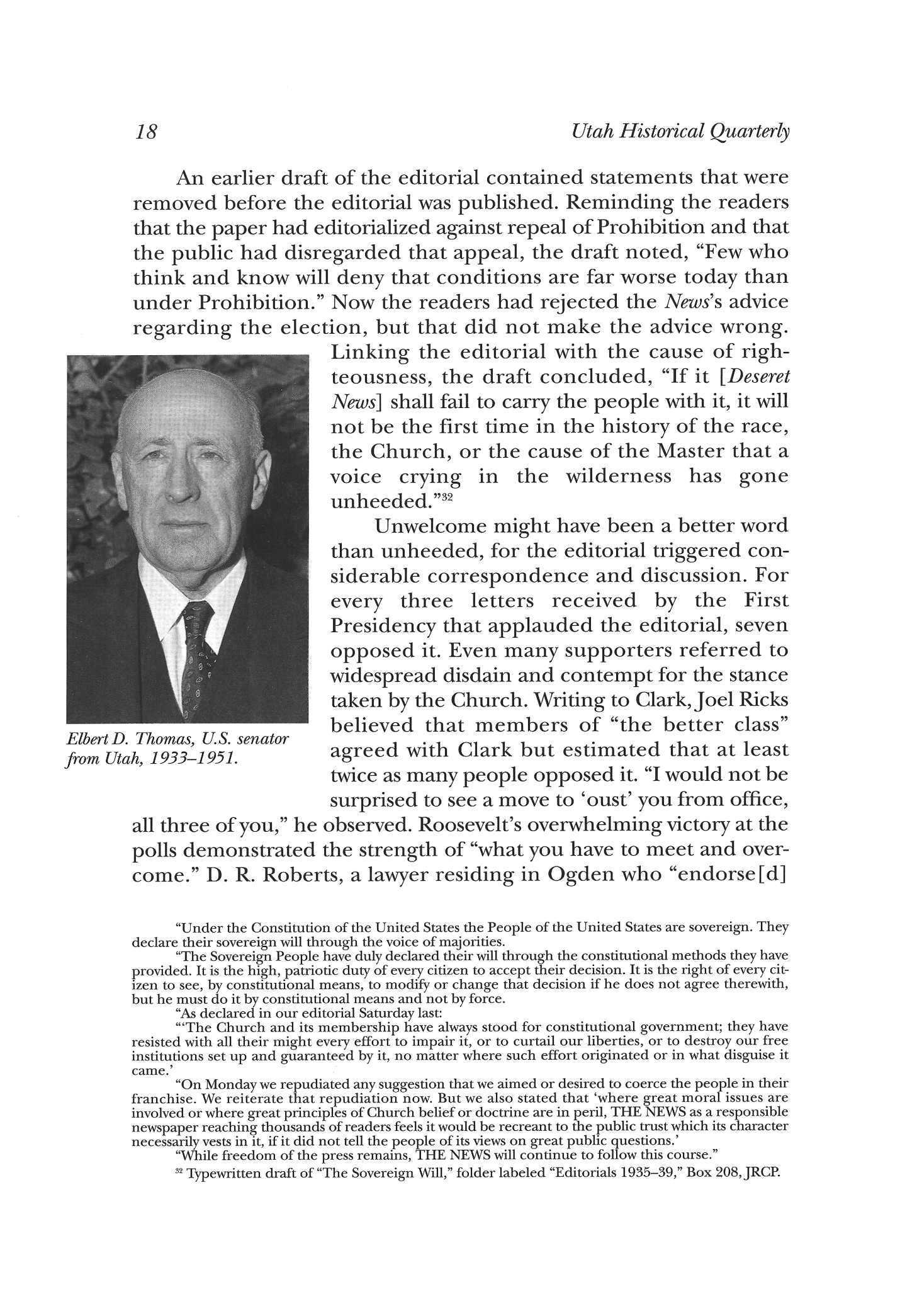 D R Roberts, a lawyer residing in Ogden who "endorse
D R Roberts, a lawyer residing in Ogden who "endorse
[d]
"Under the Constitution of the United States the People of the United States are sovereign They declare their sovereign will through the voice of majorities
"The Sovereign People have duly declared their will through the constitutional methods they have provided. It is the high, patriotic duty of every citizen to accept their decision. It is the right of every citizen to see, by constitutional means, to modify or change that decision if he does not agree therewith, but he must do it by constitutional means and not by force
"As declared in our editorial Saturday last:
"'The Church and its membership have always stood for constitutional government; they have resisted with all their might every effort to impair it, or to curtail our liberties, or to destroy our free institutions set up and guaranteed by it, no matter where such effort originated or in what disguise it came.'
"On Monday we repudiated any suggestion that we aimed or desired to coerce the people in their franchise We reiterate that repudiation now But we also stated that 'where great moral issues are involved or where great principles of Church belief or doctrine are in peril, THE NEWS as a responsible newspaper reaching thousands of readers feels it would be recreant to the public trust which its character necessarily vests in it, if it did not tell the people of its views on great public questions.'
"While freedom of the press remains, THE NEWS will continue to follow this course."
32 Typewritten draft of "The Sovereign Will," folder labeled "Editorials 1935-39," Box 208, JRCP.
18 Utah Historical Quarterly
ElbertD. Thomas, U.S. senator from Utah, 1933-1951.
with my whole soul the News (Front page) editorials of Oct 31st and Nov 2d" as "a very timely warning," found "most painful . . . the action and attitude of many of our people" in their "criticism" of the First Presidency.33
Few letters from readers that were published by the Deseret News referred directly to the editorial. Sylvester Earl, a resident of Virgin, Utah, did decry "all the aspersions and malign and false accusations against the character of Franklin D Roosevelt by his political and financial enemies." The clearest rebuttal to the editorial that appeared in the paper was written by W. A. Adams of Garland. Adams observed, "I have been taught from my youth by my parents and Church leaders that not only the framers of the Constitution were inspired, but our presidents from Washington down were entitled to inspiration, so long as they worked for the interests of all the people." This had not been the case in the 1920s, when those in power had "chosen to protect the strong at the expense of the weak until all became weak." To rescue the nation from this plight, Adams believed, "the Lord raised up Franklin D. Roosevelt." Roosevelt on inauguration day in 1933 had prayed to God "to help and inspire him to fight humanity's cause." Decrying the "coercion of the press, the cry of 'Constitution Violator,' 'Communist' and 'dictator,'" Adams exulted that Roosevelt had trounced his opponents.34
In the ensuing weeks, other supporters of Roosevelt attempted to identify him with God and righteousness, indirectly rebutting the First Presidency's stance. Lloyd O. Ivie, in a letter to the editor printed nearly a month after the election, refuted the argument that Roosevelt was "an enemy of democracy and constitutional government" by referring to Roosevelt's endorsement in a recent speech of "the Democratic form of constitutional representative government," religious freedom, and trust in God He reasoned that Mormons "should more than any other people in the world, rejoice in and sustain a president who

Election of 1936 19
Edna Harker Thomas.
33 Quinn,/ Reuben Clark, 75; Joel Ricks to JRC, November 19, 1936, Folder 2, Box 354; D R Roberts to JRC, December 5, 1936, Folder 2, Box 354, JRCP
34 Deseret News, November 13, 1936; Deseret News, November 14, 1936.
stands for such ideals." Ivie was convinced that "the voice of the divine is speaking through that inspired leader."35
The Deseret News's foray into political editorializing was disastrous from a business standpoint Already operating in the red, with subscriptions dwindling because of the depression, the News lost more than 1,200 subscribers after printing the editorial, according to Frank Jonas All told, the News had 11 percent fewer readers in 1940 than it had commanded a decade earlier, and although there were many reasons for the decline, the paper's political commentary did not help. By the 1940s, Democrat James Moyle could name "a number of good saints [who] have cancelled their subscriptions" because they objected to the paper's "nearly seditious editorial policy." Seeking for ways to overcome the paper's "difficulties" and to bolster subscriptions in 1937, the First Presidency considered bringing a non-Mormon editor aboard but refused to relinquish their influence over editorials. "We should always control the editorial policy of the paper," Clark insisted.36 Incensed by the fact that the state's major newspapers had openly opposed Roosevelt's re-election, Utah Democrats approached several newspapermen, includingJ. David Stern of the Philadelphia Record, trying to interest someone in establishing a Democratic paper in Salt Lake City "in order to save our party the embarrassment in the future, of having a practically united press against it." With three papers already operating in the city, though, they realized that obtaining "a real news service for the paper" would be difficult.37

The editorial did little to improve rapport between the Democratic leadership in Utah and the church, and it helped to associate the church
35 Deseret News, December 2, 1936
36 Sessions, Mormon Democrat, 285; Jonas, "Utah: Sagebrush Democracy," 34; Peggy Peterson Barton, MarkE. Peterson: A Biography (Salt Lake City: Deseret Book, 1985), 79; Wendell J Ashton, Voice in the West: Biography of a Pioneer Newspaper (New York: Duell, Sloan & Pearce, 1950), 399; JRC, untitled typewritten memorandum regarding Deseret News, filed in untitled brown binder containing memoranda prepared byJRC and sent October 21, 1937, to Heber J Grant and David O McKay, Folder 1, Box 358, JRCP Salt Lake Tribune's opposition to Roosevelt's bid for re-election also alienated many readers Ernest L Nelson reported, "So many people refused to subscribe to one paper in the State because of its stand on the election that it lost nearly one-third of its subscribers and the remainder read the large morning daily grudgingly." Ernest L Nelson to J David Stern, December 8, 1937, Box 21, Elbert D Thomas Papers, Utah State Historical Society
37 A. S. Brown to Elbert D. Thomas, January 19, 1937; Thomas to Brown, January 25, 1937; Ernest L. Nelson to J. David Stern, December 8, 1937; Nelson to Thomas, December 21, 1937, Box 21, Elbert D. Thomas Papers, Utah State Historical Society.
20 Utah Historical Quarterly
foelE. Ricks.
Election of 1936 21
with the Republican party in the minds of many residents of the state. "The oligarchy of the Democratic party, now in power, is made up chiefly of non-Mormons and impious members of the Church. . . . Democratic leaders like nothing better than to have the Mormon Church endorse a rival candidate, for official Church approval makes it easier, they say, to 'knock him over.' They do not seek Church endorsement for their own candidates," political analyst FrankJonas wrote in 1940 Although it was still possible for active Mormons to rise to prominence in the state Democratic Party after the First Presidency's campaign to defeat Roosevelt in 1936, the 1936 election certainly encouraged resentment toward the church, its newspaper, and its leaders, a resentment that would not easily be forgotten.38
Although the 1936 editorial campaign divided
church members, alienated some subscribers, offended Democrats, and did not materially change election results, the debacle did not convince the First Presidency to avoid interfering in national politics, although it may have made them more cautious The following spring, Grant visited with a church member in Nevada who suggested that the First Presidency directly repudiate the New Deal. Grant wrote to McKay, "I have sometimes thought the same thing, but we don't seem to be a unit, and until we are I guess it is wise to let things alone."
When Roosevelt proposed "packing" the Supreme Court in 1937, Clark and McKay opposed a milquetoast editorial written by a Deseret News employee; but Clark recommended that it would be best for the
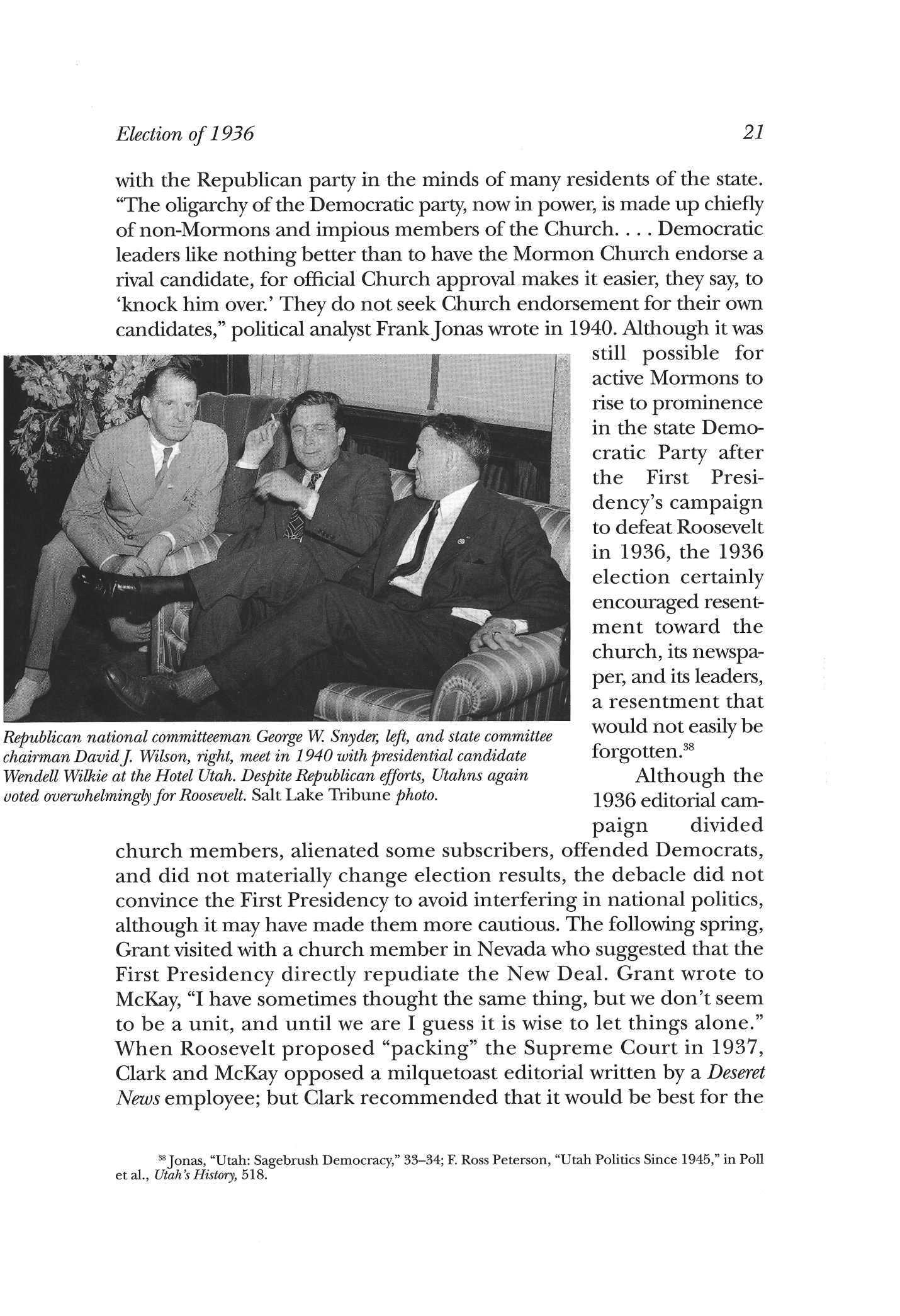 Republican national committeeman George W. Snyder, left, and state committee chairman David f. Wilson, right, meet in 1940 with presidential candidate Wendell Wilkie at the Hotel Utah. Despite Republican efforts, Utahns again voted overwhelmingly for Roosevelt. Salt Lake Tribune photo.
38 Jonas, "Utah: Sagebrush Democracy," 33-34; F Ross Peterson, "Utah Politics Since 1945," in Poll etal., Utah's History, 518
Republican national committeeman George W. Snyder, left, and state committee chairman David f. Wilson, right, meet in 1940 with presidential candidate Wendell Wilkie at the Hotel Utah. Despite Republican efforts, Utahns again voted overwhelmingly for Roosevelt. Salt Lake Tribune photo.
38 Jonas, "Utah: Sagebrush Democracy," 33-34; F Ross Peterson, "Utah Politics Since 1945," in Poll etal., Utah's History, 518
News to print editorials from several New York papers opposing the scheme rather than stirring up controversy with an editorial of its own. In 1938 Clark, who was in New York at the time, drafted an editorial for the front page of the Deseret News criticizing Utahns for their heavy reliance upon New Deal assistance to the elderly. When McKay and Grant met to review it, Grant was reluctant to publish it and wondered whether "a milder treatment should be applied first."39
The 1936 editorial fiasco, along with Utah's rejection of Heber J. Grant's plea for Prohibition in 1933, marked the nadir of the LDS church's political influence in Utah. It demonstrated how Utah's strongly worded decree separating church and State, a prerequisite for admission to the Union that few Mormons in 1896 would have supported if Congress had not required it, had become for many Utah Mormons a fiercely guarded guarantee of agency. Most Utah Mormons in the 1930s did not believe their prophet's realm extended to politics. Voter response to the editorial contrasted sharply with Utahns' respect for President Joseph F. Smith's 1912 endorsement of William Howard Taft. Church leaders such as Grant who could remember the tremendous political power wielded by prophets and apostles in an earlier era believed that they spoke with inspiration not only in matters of doctrine or morality but also in matters of politics and economics; by the 1930s, however, they found that most members disregarded their counsel in those realms. It was almost as if politicians had supplanted prophets in politics, with some Utah Mormons claiming that Roosevelt had been raised up by God and that the "voice of God [was] heard in Pres. Roosevelt's words." "About half the Latterday Saints almost worship him," Grant complained.40
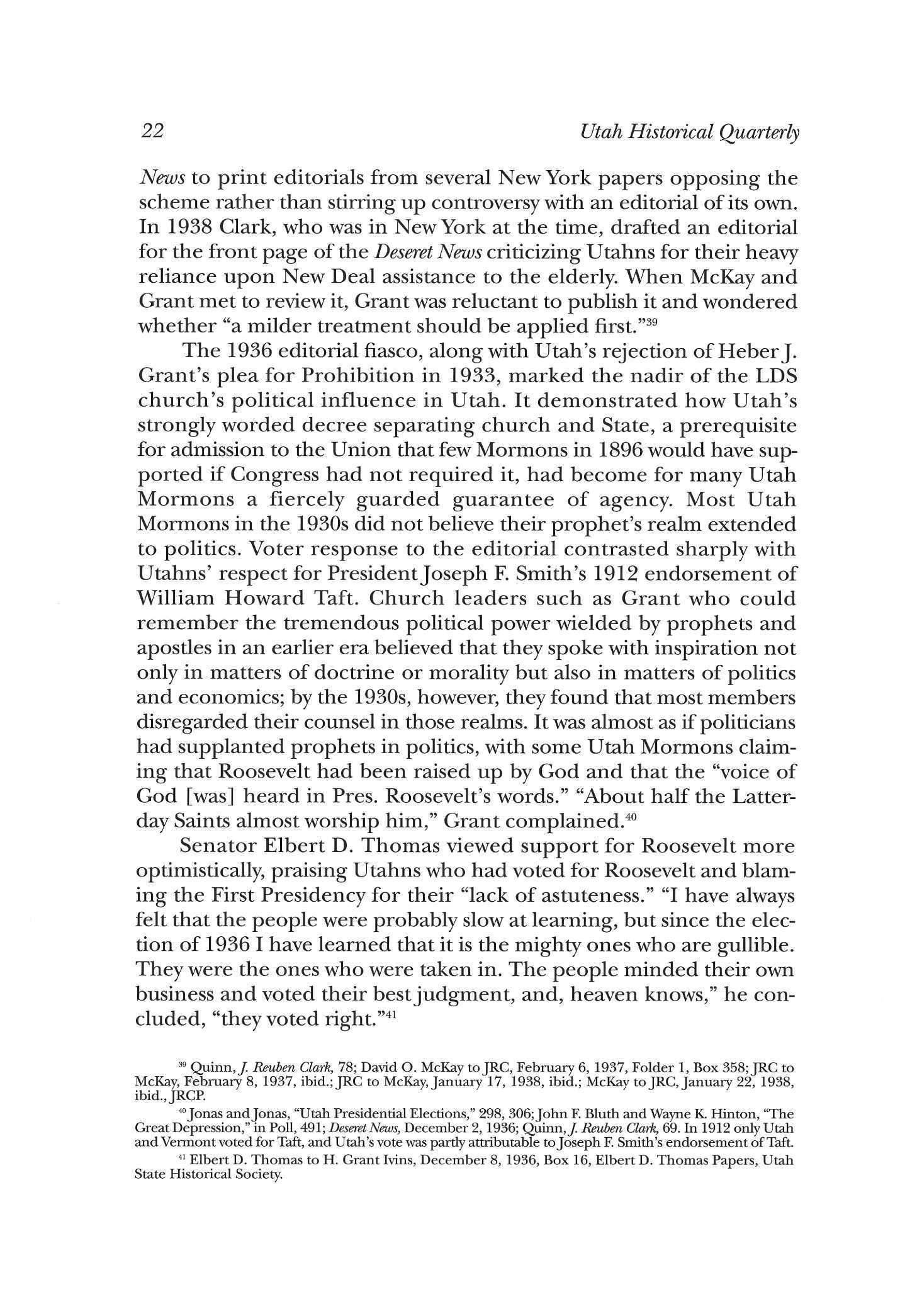
Senator Elbert D. Thomas viewed support for Roosevelt more optimistically, praising Utahns who had voted for Roosevelt and blaming the First Presidency for their "lack of astuteness." "I have always felt that the people were probably slow at learning, but since the election of 1936 I have learned that it is the mighty ones who are gullible They were the ones who were taken in. The people minded their own business and voted their bestjudgment, and, heaven knows," he concluded, "they voted right."41
40
22 Utah Historical Quarterly
39 Quinn,/. Reuben Clark, 78; David O. McKay to JRC, February 6, 1937, Folder 1, Box 358; JRC to McKay, February 8, 1937, ibid.; JRC to McKay, January 17, 1938, ibid.; McKay to JRC, January 22, 1938, ibid., JRCP
Jonas and Jonas, "Utah Presidential Elections," 298, 306;John F Bluth and Wayne K Hinton, "The Great Depression," in Poll, 491; DeseretNews, December 2,1936; Quinn, / Reuben Clark, 69. In 1912 only Utah and Vermont voted for Taft, and Utah's vote was partly attributable toJoseph F Smith's endorsement of Taft
41 Elbert D Thomas to H Grant Ivins, December 8, 1936, Box 16, Elbert D Thomas Papers, Utah State Historical Society
A 200-ton boulder deposited by floods near Davis Creek, Davis County. Probably taken in 1930 by U.S. Forest Service. All photos from USHS collections.
"Been Grazed Almost to Extinction": The Environment, Human Action, and Utah Flooding, 1900-1940
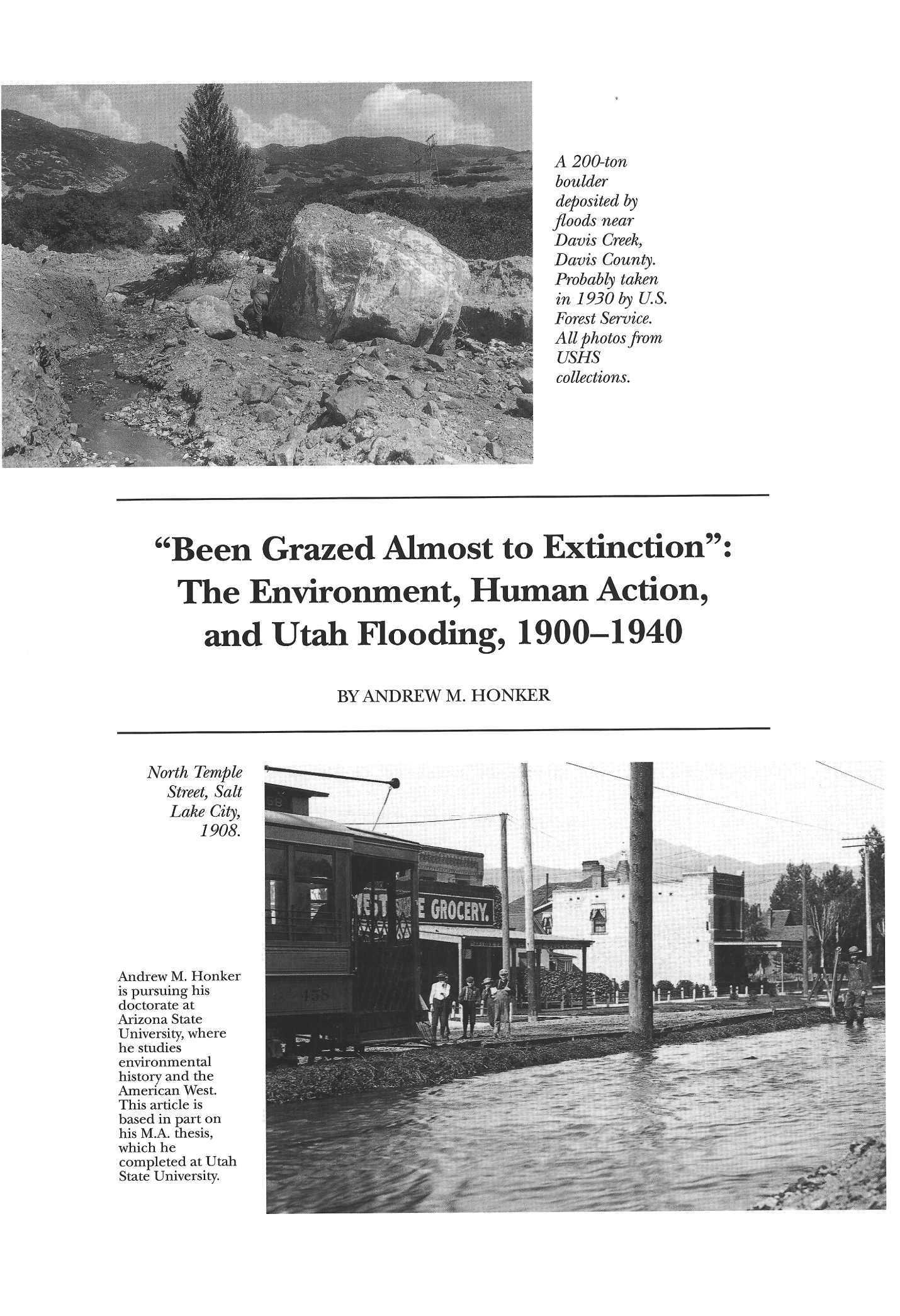 BYANDREW M HONKER
BYANDREW M HONKER
North Temple Street, Salt Lake City, 1908.
Andrew M Honker is pursuing his doctorate at Arizona State University, where he studies environmental history and the American West This article is based in part on his M.A thesis, which he completed at Utah State University
O N JULY 10, 1930, ELLA M DALE—who lived with her husband in Weber Canyon, southeast of Ogden, Utah—heard a roar outside her home that sounded like "an approaching freight train." After her husband assured her that the train was not due, Dale opened her door and watched as "a flash of lightning struck the high tension wires on the north side of the canyon and flashed along them, lighting up the entire gorge. Then the rain came down in sheets and the rocks and dirt followed it." Some 250,000 tons of debris washed down Weber Canyon that day, "with boulders piled 35 feet high and extending over a distance of 400 feet."1
Utah is the nation's second most arid state—only Nevada receives less moisture annually than Utah's average of thirteen inches—but flooding as a natural process has occurred in the area for thousands of years. 2 The combination of Utah's topography and erratic climate creates an ideal situation for periodic flooding Due to seasonal disparities in precipitation, many of Utah's smaller streams remain completely dry during part of the year. Such dry water courses, along with other desert surfaces, canyons, and gullies, provide an outlet for flash flooding during periods of unusually heavy precipitation. Heavy winter snows and low spring temperatures create a snowpack susceptible to rapid melting in late spring when temperatures jump, unleashing water from an entire winter onto the valleys below Finally, cloudburst storms can dump huge quantities of water onto already-saturated or otherwise impaired mountain watersheds, sending a wall of water and debris down canyon streambeds.3
The physical setting to which Brigham Young brought the initial Mormon settlers in the summer of 1847 had a long history. Natural forces, primarily wind and water, had shaped and eroded the landscape, and flooding had long been a naturally occurring phenomenon. Various cultures and peoples had lived in, explored, and used the area to which the Mormon pioneers came. These earlier peoples had exploited the natural flora and fauna, and some had developed irrigation.4 Utah was not a virgin uninhabited wilderness in the summer of 1847, but the arrival of Brigham Young's band and the thou-
1 Salt Lake Tribune, July 11, 1930
2 Bill Weir, Utah Handbook (Chico, CA: Moon Publications, 1989), 5
3 Robert L Layton, "Utah: The Physical Setting," in Richard D Poll et at, ed., Utah's History (1978; reprint ed., Logan: Utah State University Press, 1989), 18; Weir, Utah Handbook, 7.
4 Native
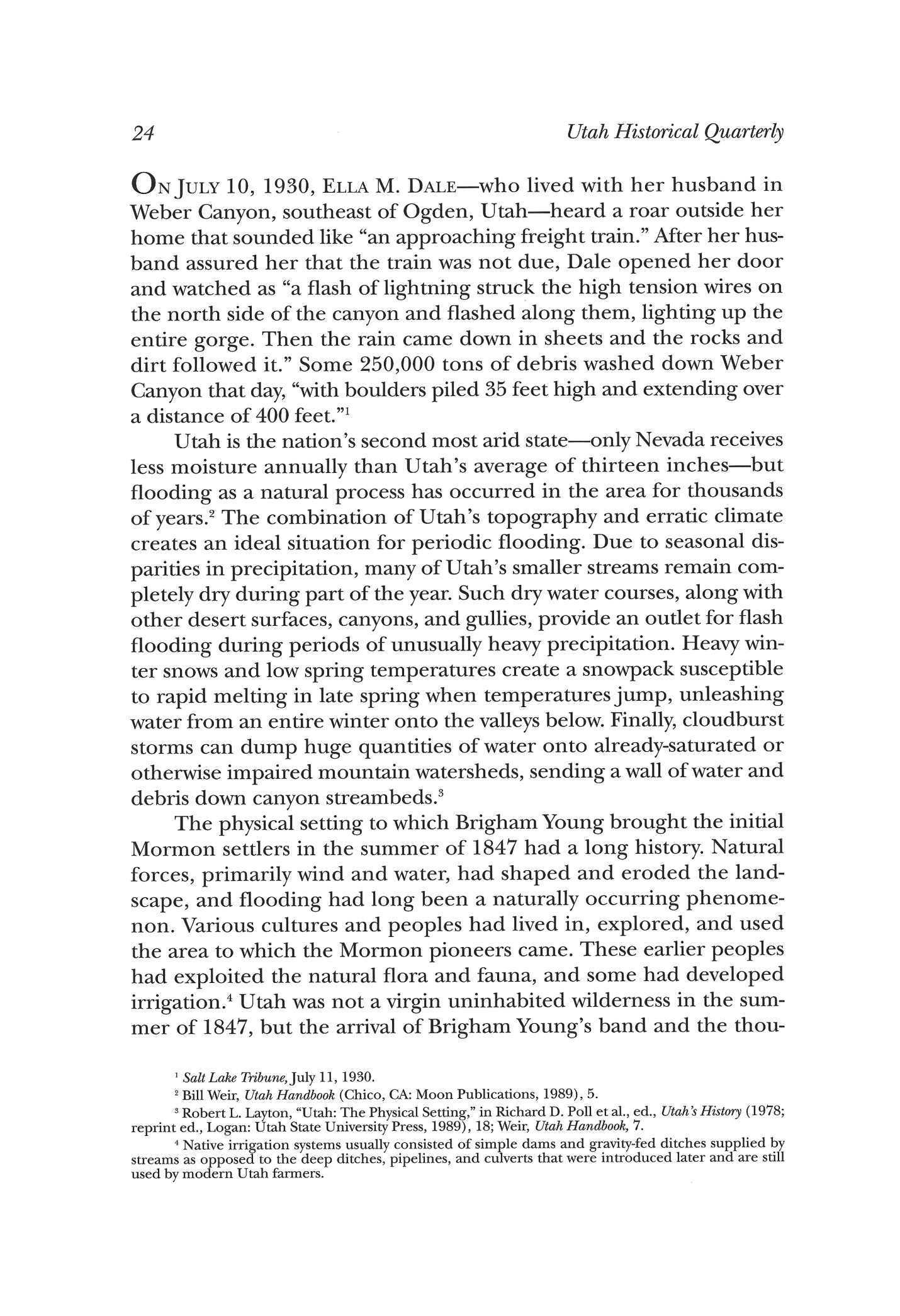
24 Utah Historical Quarterly
irrigation systems usually consisted of simple dams and gravity-fed ditches supplied by streams as opposed to the deep ditches, pipelines, and culverts that were introduced later and are still used by modern Utah farmers
Utah Floods 25
sands that followed did mark a new era for the region. Less than five years after their entrance into the Salt Lake Valley, Mormons had to cope with flooding, and in 1862 flood waters plagued much of Utah from February to June, sweeping away almost every bridge in the region and demolishing roads, fields, and homes. A continuing war against rising and rushing waters, with the damage they may bring, had begun
From the beginning of statehood in 1896 to the beginning of World War II, Utahns greatly increased the number and means of flood control projects in their ongoing battle against inundation During this period, they built barrier dams, catchment basins, spillways, and channel control structures, all in an attempt to establish some human control over flood waters. This period also saw the introduction of the federal bureaucracy into the local flood control effort through Civilian Conservation Corps camps and workers and the increased federal control of public lands. Unfortunately, the expansion of engineering projects and the influx of federal workers and funds failed to protect Utahns from flood waters. In many areas, Utahns had to battle the results of their own use of the land: severely impaired watersheds that increased the frequency and devastation of floods

On July 1, 1902, Albert F. Potter, chief grazing officer of the U. S. Department of the Interior's Division of Forestry, stepped off the train in Logan, Utah Gifford Pinchot, head of the Division of Forestry, had assigned Potter the task of surveying the mountainous forest land of eastern Utah for inclusion in federal forest reserves. Potter spent five months crisscrossing the Wasatch Mountains and Colorado Plateau from the Idaho border to Escalante. During his journey, he kept a diary noting the effects of a half century of grazing and lumbering on the condition of the region's watersheds and timberlands.5
Potter's diary describes countless areas that logging enterprises or local citizens had completely cut over, sometimes more than once. Descriptions such as "only trees too small for telephone poles are now left," "timber cut very clean in the places which were easily reached," and "every tree (and seedling) has been cut" are common in the diary. In the vicinity of Alta, east of Salt Lake City, Potter noted that the area "has been worked until both the ore and timber were pretty well
5 Albert F Potter, "Diary of Albert F Potter, July 1, to November 22, 1902," photocopy, Special Collections, Merrill Library, Utah State University, Logan, Utah; Charles S Peterson, "Albert F Potter's Wasatch Survey, 1902: A Beginning for Public Management of Natural Resources in Utah," UtahHistorical Quarterly 39 (Summer 1971): 238-53
 Top: Debrisfrom Manti flood of 1902, showing creek flume near center of town.
Bottom: Main Street, Manti, afterflood. Theflume was actually raisedfour feet by debris that was pushed under it.
Top: Debrisfrom Manti flood of 1902, showing creek flume near center of town.
Bottom: Main Street, Manti, afterflood. Theflume was actually raisedfour feet by debris that was pushed under it.
exhausted. ... It would be hard to find a seedling big enough to make a club and kill a snake."6
Potter also saw firsthand how overgrazing by sheep and cattle had damaged the vegetative cover of Utah's mountain watersheds. In the mountains surrounding Logan and the Cache Valley, he found areas "badly tramped out by sheep . . . [and] creek banks trampled down and barren of vegetation." Estimating that 150,000 sheep had grazed the area the previous year, Potter suggested that "the number allowed within the proposed forest reserve should not exceed 50,000." He encountered a similar scene in almost every area he visited, with the notable exception of the Uintah Indian Reservation. At the border of the reservation, Potter noted a marked change in the vegetative cover and general condition of the land He saw good grass and plenty of trees on the reservation, which demonstrated "the difference restriction of grazing makes in range conditions."7
He also recorded the opinions of a number of Utahns about the possibility of establishing forest reserves. At the time of Potter's survey, forestry officials pointed to the role of trees in protecting watersheds, arguing that preserving the forests would ensure a water supply for local communities. This argument did not convince everybody, however. Potter found that support for forest reserves varied according to geographic location; people in those areas that had not historically experienced a shortage of water or timber did not feel conservation practices necessary. Not surprisingly, he also discovered a great difference in support between those who held an economic interest in sheep or cattle and those who did not.8
While recording these general opinions toward conservation, Potter found that Utahns generally failed to correlate deteriorated watersheds with increased flooding and erosion. Citizens in Logan told him that they supported conservation because the large number of sheep and cattle posed a local health problem: "They think the health of the town is endangered by stock dying near the stream and by the pollution of the water by the manure and the urine

Denudation of the slope by timber cutting diminishing the water supply does not seem to alarm them."9
Several individuals, however, did grasp the relationship of over-
6 Potter, "Diary," 1, 5, 10
'Ibid., 3-5, 8-9, 13
8 Ibid.; Peterson, "Albert F Potter's Wasatch Survey," 249-53
9 Potter, "Diary," 2.
Utah Roods 27
grazing to increased flooding. Tom Smart of Logan informed Potter that "the most serious damage done by livestock has been packing the soil so that the water runs off in floods more than it did in former years." Professor G. L. Swendsen of the Utah State Agricultural College provided Potter with statistics on the Logan River showing that, since local deforestation and livestock damage to the range, "floods have come down earlier in the spring." Although Peter Thompson of Ephraim thought that tramping of the soil helped to increase the local water supply, he correctly admitted that denuded watersheds caused "the water to run down the canyons in place of soaking into the ground."10
Finally, the citizens of the town of Manti appeared to have learned a lesson from previous flooding Potter found that after the damaging floods in 1890 local citizens had excluded all stock from Manti Canyon in hope of restoring the vegetation. Manti citizens had elected L. R. Anderson mayor of the town in 1900 after he ran oh a "no more floods" platform; Anderson had then immediately petitioned President Theodore Roosevelt to set aside the Manti watershed as a forest reserve. This petition, along with the observations made during Potter's survey, led to the establishment of the Manti Forest Preserve on May 29, 1903. Complete prohibition of grazing in the Manti Creek watershed continued until 1909, and after that year federal grazing management continued the protection of the watershed.11
Potter's trip through Utah led directly to the establishment of most of the state's other national forests as well. Between 1903 and 1910 the Dixie, Wasatch, Ashley, and Cache forests all joined the Uinta and Fish Lake reserves, which had been established at the end of the nineteenth century. Forest officials immediately moved to restrict grazing on these new reserves; by 1910, they had reduced the number of sheep using Utah lands by almost one million, and numbers continued to fall over the next decade.12 This success in controlling grazing did help relieve some of the pressure on overgrazed watersheds, but forest officials failed to restore ground cover and to reduce erosion. It would take several decades and several devastating floods—floods created by poor watershed conditions—before officials
10 Ibid., 1, 9, 47
11 Ibid., 34; Salt Lake Tribune, June 8, 1953; Walter P Cottam, Is Utah Sahara Bound? Bulletin of the University of Utah, Vol 37, No 11 (Salt Lake City: University of Utah Press, 1947), 7-9
12 Sheep far outnumbered cattle in Utah at the turn of the century. In 1900, there were almost four million sheep in the state, while the number of cattle remained around 350,000 Cattle actually experienced a slight rise in numbers in the first few decades of the twentieth century, peaking at a little over 500,000 in 1920 and then declining in the following years Cottam, Is Utah Sahara Bound?, 4

28 Utah Historical Quarterly
treated most of the state's watersheds with the same care exhibited by the citizens of Manti.13
Floods were common in the first two decades of the twentieth century, although they were rather minor and isolated compared to the floods of 1862 On June 12, 1908, water overflowed on west North Temple Street in Salt Lake City, flooding the street and several homes. The following day, the Deseret News wrote that local citizens insisted "that the city is responsible for the conditions and must be forced to recognize their rights and prevent further flooding of the vicinity."14 People held the city responsible even though the News noted that railroad construction had caused the problem by cutting off a sewer connection that also served as a safety outlet for excess runoff. The city fixed the problem and public outcry dissipated, but as the size and

13 Charles S. Peterson, "Natural Resource Utilization," in Poll et at, Utah's History, 660-61.
14 Deseret News, June 13, 1908 In an interesting sidenote, the Salt Lake Tribune ran a story the same day that called the News coverage of this incident a "big canard." The Tribune noted that water had overflowed for only a distance of fifty feet and had caused "no trouble whatever." In response, the News called the Tribune an "organ of crooks." It seems that no topic was free from dispute in the frequent bickering between these two papers
29
Utah Floods
North Temple Street, 1907.
complexity of the city's sewer system increased, so would its problems and limitations in dealing with excess runoff.
During the first ten days of June 1909, high water from melting snow flooded areas along City Creek, the Jordan River, and around Utah Lake The heavy runoff turned City Creek into a "raging, frothy, yellow stream, full of debris from stumps of trees to boulders one foot in diameter The roaring of the stream can be heard from a distance of 150 feet from its banks."15 The creek roared down North Temple Street, and city workers built five-foot-high embankments along the street to contain the flow. South of the city, Parleys Creek flooded large tracts of farmland. The high runoff washed out bridges, damaged roads, drove people out of their homes, and drowned sixyear-old Matthew Desmond after he fell off a temporary bridge into the swirling waters of Mill Creek.16
Throughout Salt Lake City, channels, canals, and conduits exacerbated the flood problem. Residents had originally built these structures for irrigation, and the city had later expanded and maintained them in order to improve the water supply throughout the city These artificial water courses also served an additional function, helping channel excess water from the steep canyons east of the city to the Jordan River. However, when the water level rose above the capacity of such structures, they only served to complicate the problem.17
During the floods of 1909, a number of these artificial water
15 Salt Lake Tribune, June 5, 1909.
16 Deseret News,June 5 and 9, 1909; Salt Lake Tribune, June 6, 9, and 10, 1909
17
For more information on the construction of canals and conduits for water supply, see Fisher Stanford Harris, 100 Years of Water Development, Report Submitted to the Board of Directors of the Metropolitan Water District of Salt Lake City, April 1942, Special Collections, Merrill Library

30 Utah Historical Quarterly
Utah Floods 31
courses filled with silt and debris and failed to function properly. The canal on 900 South filled so fast that it flooded the entire neighborhood in its vicinity On 1000 South, the canal on the north side of the street was able to channel excess water to theJordan River, but blockage in the canal on the south side was so bad that it caused the water to flow back on itself. This reverse flow, unable to travel very far uphill, soon cut a new channel straight through a number of backyards, giving homeowners riverfront property they were unaware that they had.18
This 1909 flooding brought renewed criticism of public officials. Writers and editors at the Deseret News sharply criticized public officials for their lack of foresight After a few members of the city council viewed the damage on June 5, a writer in the paper commented sardonically: "Of course they are all full of plans for the prevention of any similar trouble in the future—one such plan being the deepening and enlarging of the surplus canal. The flooded inhabitants are thus invited to forget this year's distress in the contemplation of next year's promise."19 The staff of the News also suggested that the authorities should "blow up" several dams that Salt Lake and Davis County officials had allowed gun clubs to build at the mouth of theJordan. These obstructions "set the water back, obstruct the flow, and materially aid in clogging up the channel of the river."20 The reactive nature of the city councilmen's promises—acting after the fact—and the lack of

18 Deseret News,June 5 and 9, 1909
19 Deseret News, June 5, 1909
20 Deseret News, June 9, 1909
The surplus canal referred to carried water from the Jordan River south and west of Salt Lake City directly to the Great Salt Lake, thus, designers hoped, helping to alleviate high water running through the heavily populated parts of the city
North Temple Street, Salt Lake City, 1907.
foresight on the part of county officials in allowing such development typify the relationship between humans and the flood problem in Utah.
In contrast to city and county officials of the time, the editors of the Deseret News showed rare insight in examining and understanding the larger picture They argued that the chief lesson of the 1909 flood "is the necessity for reforestation of the canyons and of all the mountain slopes," so that "each year the danger will become more remote and improbable." Here—during a time when attempts to combat floods focused almost entirely on physical alterations and artificial controls of streams and rivers—was a novel idea. Why not repair the forested watersheds where most of the flood waters originated in order to reduce debris and flow? Unfortunately, as the editorial went on to note, the time wasjust not right for such a change: "Legislators manifest an unexplained lack of interest in this grave and vital problem, while the apathy of the people in relation to it is scarcely less remarkable."21
The severity of the News's criticisms should be tempered by the fact that no one had yet established a firm connection between watershed conditions and flooding. In addition, legislative and public concern for flooding as a hazard, along with support for flood control, fluctuated with the unpredictable nature of flooding in Utah. The apathy referred to by the News most likely stemmed from the fact that most Utahns failed to perceive the possibility of future flooding. The fact that the Salt Lake Tribune called theJune 1909 floods "Worst Flood
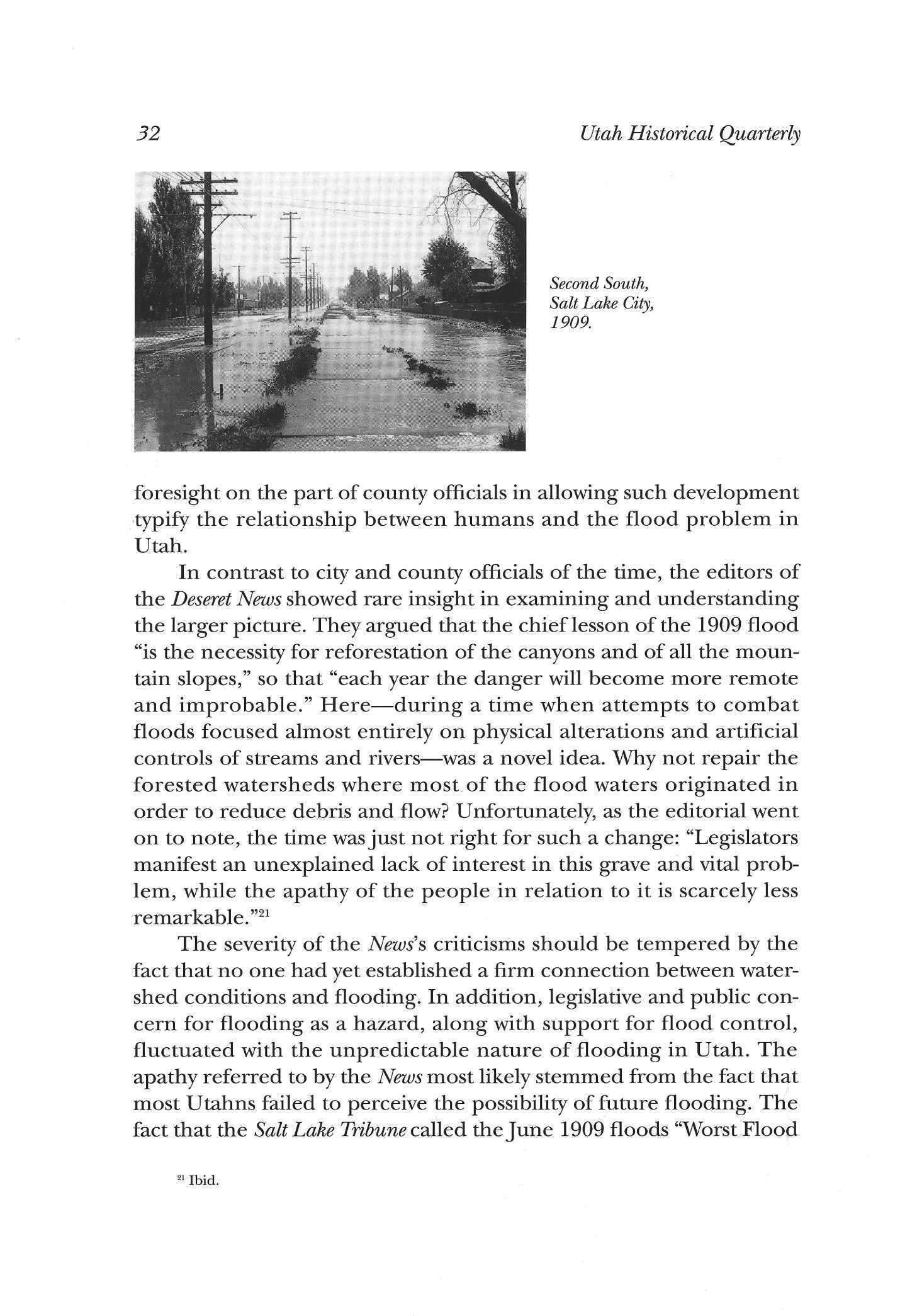
32 Utah Historical Quarterly
Second South, Salt Lake City, 1909.
21 Ibid.
in History of Zion" implied a forgetfulness—or ignorance—regarding the floods of 1862.22

Flooding two months later in the vicinity of Manti seemed to prove the News editorial's points regarding reforestation In August 1909, heavy rains caused flooding "in adjacent canyons to both the north and south of Manti Canyon, while the latter was not perceptibly affected."23 Local citizens, of course, had protected Manti Canyon from all grazing since the 1890 flood, and the inclusion of the area in the Manti-LaSal forest reserve in the first decade of the twentieth century helped continue the program of protection. Although it appeared that restriction of grazing had paid off in this localized case, a widespread effort to restore Utah's watersheds remained more than twenty years away
In 1917, Salt Lake City officials decided to end their flood problems once and for all. They diverted City Creek, which had long been a flood hazard, into an underground conduit designed to carry flows from the mouth of City Creek Canyon to the Jordan River at North Temple Street. The diversion of City Creek followed other projects completed earlier: Red Butte Creek, which entered an underground conduit at the junction of 1100 South and 1200 East; Emigration Creek, which entered a conduit near Westminster College; and Parleys Creek, which entered an underground conduit that extended northwesterly to intersect the combined Red Butte-Emigration conduit near State Street on 1300 South. From there, a conduit along 1300 South carried the combined flow into the Jordan River. Officials designed all of these underground diversions to carry runoff and excess flows directly to the Jordan River without traveling—at least above ground—through the heart of the city All of these diversions opened new land for development and functioned adequately during years of normal high water.
However, flooding during the same year that officials diverted City Creek into an underground channel illuminated the inherent problems of these conduit systems.24 On April 25 and 26, 1917, heavy rainstorms
22 Salt Lake Tribune, June 5, 1909 For more on perception and flooding see Robert William Kates, Hazard and Choice Perception in Hood Plain Management (Chicago: University of Chicago, Department of Geography, 1964), 104-34, and Gilbert F White, Choice of Adjustment to Floods (Chicago: University of Chicago, Department of Geography, 1964), 1-41 For a discussion of perception and hazards in general, see Charles Perrow, Normal Accidents: Living with High-Risk Technologies (New York: Basic Books, 1984)
23 C L Forsling, A Study of the Influence ofHerbaceous Plant Cover on Surface Runoff and SoilErosion in Relation to Grazing on the Wasatch Plateau in Utah, United States Department of Agriculture Technical Bulletin No 220 (Washington, D.C.: Government Printing Office, 1931), 8
24 Rood Plain Information:Jordan River Complex, Salt Lake City, Utah (Sacramento: U.S Department of the Army, Sacramento District, Corps of Engineers, 1969), 9 I realize that "normal" is a somewhat loaded term here, but what I mean is the levels of high water common each spring along the Wasatch Front when the snowpack melts and mountain streams reach their peak flows. Any number of conditions—a wet spring, a record snowpack, a late melt, etc.—can bring on higher than normal conditions, and it is under such conditions that the limits of this system become apparent
33
Utah Floods
combined with a melting snowpack to send flood waters pouring out of the canyons east of Salt Lake City. The volume of water was so high that a number of culverts, canals, and conduits filled to capacity or became clogged with debris, and the overflow ruined lawns, spoiled gardens, and filled basements throughout the city One city resident, George W Hoggan, expressed anger at city authorities who claimed that the flooding "can't be helped." Hoggan responded: "If the city does not make an outlet for the waters, I shall call my own men and do so."25
City water officials did what they could to alleviate the flooding; city workers tried to divert water from Red Butte Creek into the canal along 1300 South, but that too had filled to capacity. W. P. Gillespie, assistant supervisor of streets and irrigation for the city, summed up one part of the situation by observing that the "major part of the trouble is caused by the conduit through which the Emigration canyon stream runs being too small for the volume of water it is being called upon to carry." Indeed, according to the Salt Lake Tribune: "One thing has been learned by the street department flood fighters during the present high water. It is that the conduits of the various streams are too small for flood season."26
This incident illuminates the major flaws of this type of flood control. When high water or obstructions cause artificial waterways to exceed their capacity, the water will continue to flow downstream. But it will overflow onto streets and farms and into houses and businesses—the very structures built on the land made available because of the streams' diversion underground Unfortunately, for Salt Lake City and County officials (as well as officials in other urban Utah areas) the solution was not to examine other alternatives but to expand and improve their conduit and sewer system. The inherent limits of such a system would remain a problem.27
Luther M. Winsor, a firm believer in flood control works, once noted that "flood control in Utah as a definitive project began in 1922."28 Winsor, a Utah native, graduated from the Utah State Agricultural College in 1911 with a degree as an irrigation engineer, the
25 Salt Lake Tribune, April 26, 1917
26 Deseret News, April 26, 1917; Salt Lake Tribune, April 28, 1917.
27 It is important to bear in mind that most of the diversion canals and conduits were originally constructed before much flood data existed and also prior to the evolution of flood predicting Therefore, these engineers must have relied heavily on guesswork in deciding a conduit's needed capacity. However, even the reliance on flood prediction and the accumulation of years of flood data have not solved the problem of limited capacity
28 L M Winsor, "Flood Situation in Utah," in Slack W Winburn, comp., WaterResources, Report to the Utah State Planning Board, 1934, TMs, Special Collections, Marriott Library, University of Utah, Salt Lake City, Utah, 1

34 Utah Historical Quarterly
first such degree conferred in the state and, quite possibly, the country From 1913 until 1934, the state of Utah employed Winsor as an irrigation specialist, and although Winsor primarily concerned himself with irrigation, his expertise and experience involved him in the development of flood control programs throughout the state in the 1920s and 1930s.29
Winsor believed 1922 to be a pivotal year because in that year federal and state agencies came together to build a diversion dam across Salt Creek, near Nephi. The U.S. Bureau of Agricultural Engineering, cooperating with the Utah Experiment Station and the Utah Extension Service, built a 1,500-foot-long dike across the creek on the east side of Mount Nebo to check the flow of sand, gravel, rocks, and floating flood debris The local irrigation company financed the venture, which proved successful, leading to similar structures the following year at Chalk Creek near Fillmore, at Corn Creek near Kanosh, and at Shoal Creek near Enterprise.30
In 1923 devastating floods struck Willard, Farmington, and other canyons along the Wasatch Front north of Salt Lake City. On August
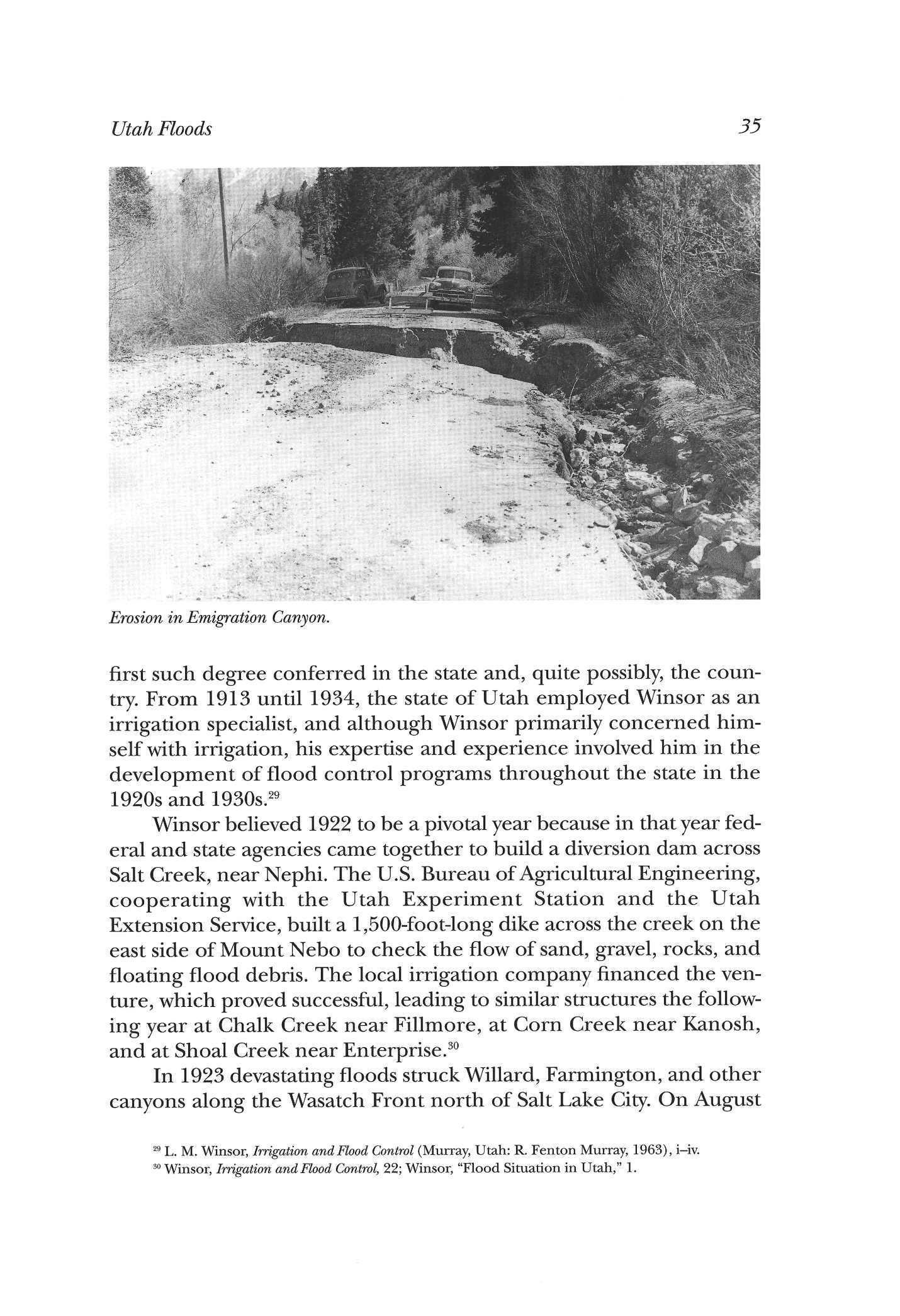
Utah Floods 35 m
Erosion in Emigration Canyon.
L M Winsor, Irrigation and Flood Control (Murray, Utah: R Fenton Murray, 1963), i-iv ' Winsor, Irrigation and Flood Control, 22; Winsor, "Flood Situation in Utah," 1
13 a thunderstorm of exceptional violence hit northern Utah, dumping more than one inch of rain on the cities and mountains east of the Great Salt Lake. The resulting flows of water and debris killed nine people and caused extensive damage.31
Willard, a few miles south of Brigham City, was hit hardest, as a one- to three-foot layer of mud and boulders covered 155 acres, including several town blocks. A roiling mass of water, mud, boulders, and other debris had emerged from Willard Canyon: "The old creekbed was filled with mud and gravel. . . the state highway . . . covered with about seven feet of earth, boulders, and mud [and] the city of Willard was almost wiped off the map." When this mass of water and rubble hit the apex of an old alluvial fan on which the town was built, it split in two. One portion moved south and spread over a wide area, and the other followed an old stream course through the north part of town The flow laid waste to prime farm land, tore apart the power house at the mouth of Willard Canyon, and demolished the home of Mrs. Mary Ellen Ward, killing two of the occupants.32
A similar mass of water and wreckage rolling out of Farmington Canyon struck the town of Farmington, leaving "devastated homes, seven deaths, debris covered fields, and a gloom stricken county" in its wake Mr and Mrs W.J Wright of Ogden were camping in the canyon with four boy scouts when the deluge swept them all to their deaths. It took three days of constant searching to find the bodies amidst all of the rubble. The other casualty in Farmington occurred when Arnold Christensen overexerted himself rescuing his family from the flood. The flood at Farmington lacked the intensity of that at Willard but still crested at ten feet and spread one hundred feet across as it emerged from the canyon mouth
A third mud and debris flow emerged from the canyon of Rex Creek in north Centerville, south of Farmington Hyrum Ford, whose farm lay directly in the torrent's path, "heard the roaring waters, but before he could get out of the barn, he together with the cows and barn were swept down the stream." The water swept the barn away, but Ford managed to extricate himself from the flow. His home was not so fortunate, as the flood "filled his home nearly to the second floor with silt and gravel and left a ridge over the county road to a depth of over five feet and more than one hundred yards long Boulders of
31 Deseret News, August 14, 15, and 16, 1923; Joshua Hughes Paul and F S Baker, "The Floods of 1923 in Northern Utah," Bulletin of the University of Utah 15 (March 1925): 3-7
32 Box Elder News, August 14 and 17, 1923; Paul and Baker, "Floods of 1923," 11-15
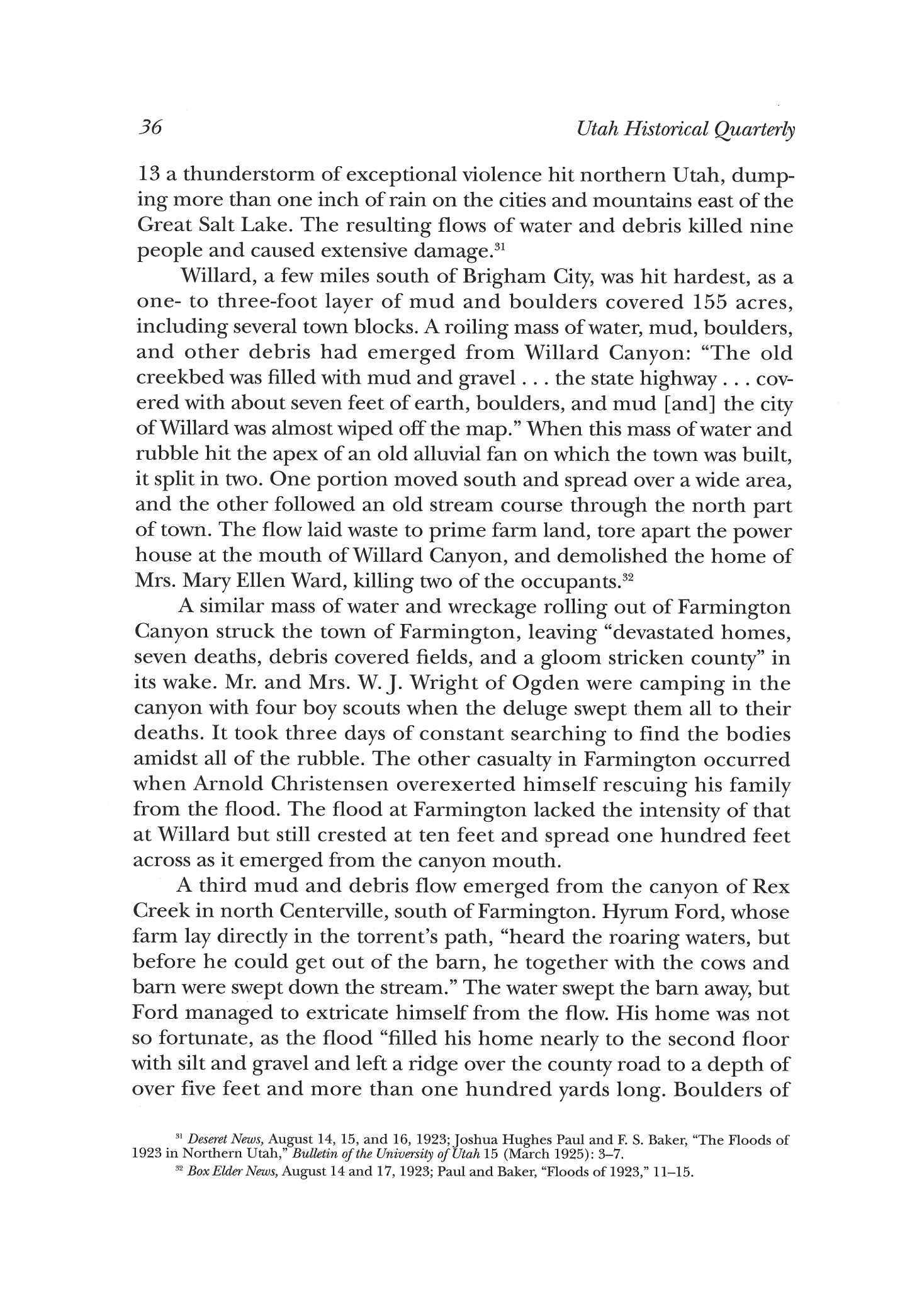
36 Utah Historical Quarterly
unbelievable size and large trees were hurled down by the flood waters."33
In response to this destruction, citizens of Willard and Farmington, under the direction of Luther M. Winsor, set about the next year to build flood control works along the mountain streams above each town. In each community, local water usersjoined with the Utah Highway Commission, the county commissioners, and local railroad lines to pay for the ventures. These cooperative groups built diversion dams to direct flood waters into shallow catchment basins where the water could slow and drop the heavier part of its load of debris Over the next several years, this type of flood control expanded throughout the state.34 Unfortunately, the citizens of Farmington, Willard, and other communities throughout the state failed to recognize the underlying factors that had intensified the flooding of 1923. Even the diversion dams and catchment basins so recently completed could not hold back debris-laden flood waters intensified by deteriorated watersheds.35
Two concerned individuals did argue that impaired watersheds had played a role in the flooding at Willard and Farmington. J. H. Paul, a professor of natural science at the University of Utah, and F. S. Baker, an employee of the U.S. Forest Service, spent a year and a half studying the condition of the land in the canyons above each town. In March 1925 the two men published a report that concluded "any reduction, from either overgrazing or fire, in the density of the natural cover of vegetation, rapidly increases the likelihood of serious erosion."
Paul and Baker studied several different factors involved in the 1923 floods. First, they dismissed the argument that the amount of rainfall had been unusually high. Although the storm that caused the flooding had been violent, the two men concluded that similar storms were "not rare in the mountains." Paul and Baker then turned to an extensive study of the vegetative cover and general conditions of Willard and Farmington canyons.

In Willard Canyon the two men found that little erosion had taken place along the east-west portion of the canyon. They found this section covered with brush—oak, serviceberry, and maple—and con-
84
Utah
37
Floods
33 Davis County Clipper, August 17, 1923; Paul and Baker, "Floods of 1923," 11-15
Winsor, Irrigation and FloodControl, pp 22-25; Winsor, "Flood Situation in Utah," 1-2
35 Of course, this is even assuming that such structures worked at their optimum level After all, flooding can be so unpredictable as to flow right by diversion dams, and catchment basins can only hold so much debris before they are full
siderable stands of timber But further up the canyon, after it turns to the south, Paul and Baker discovered wide, deep gullies where water had carved channels on its way down the canyon walls. Rocky ridges marked two areas at the canyon head; the other, more gentle slopes were covered by only "scanty stands of alpine fir, which in the past have been more dense; heavy logging is evident, and reproduction has been subnormal." The men noted that the channels the water had cut seemed to follow locally overgrazed and overforested places on the slopes
In Farmington Canyon, Paul and Baker found similar conditions. Near the ridgetop on the north side of the canyon "over-grazing is locally severe," with "vegetative cover . . . far below normal." As in Willard Canyon, the two men also found places heavily covered with brush and trees that had experienced little erosion during the flooding
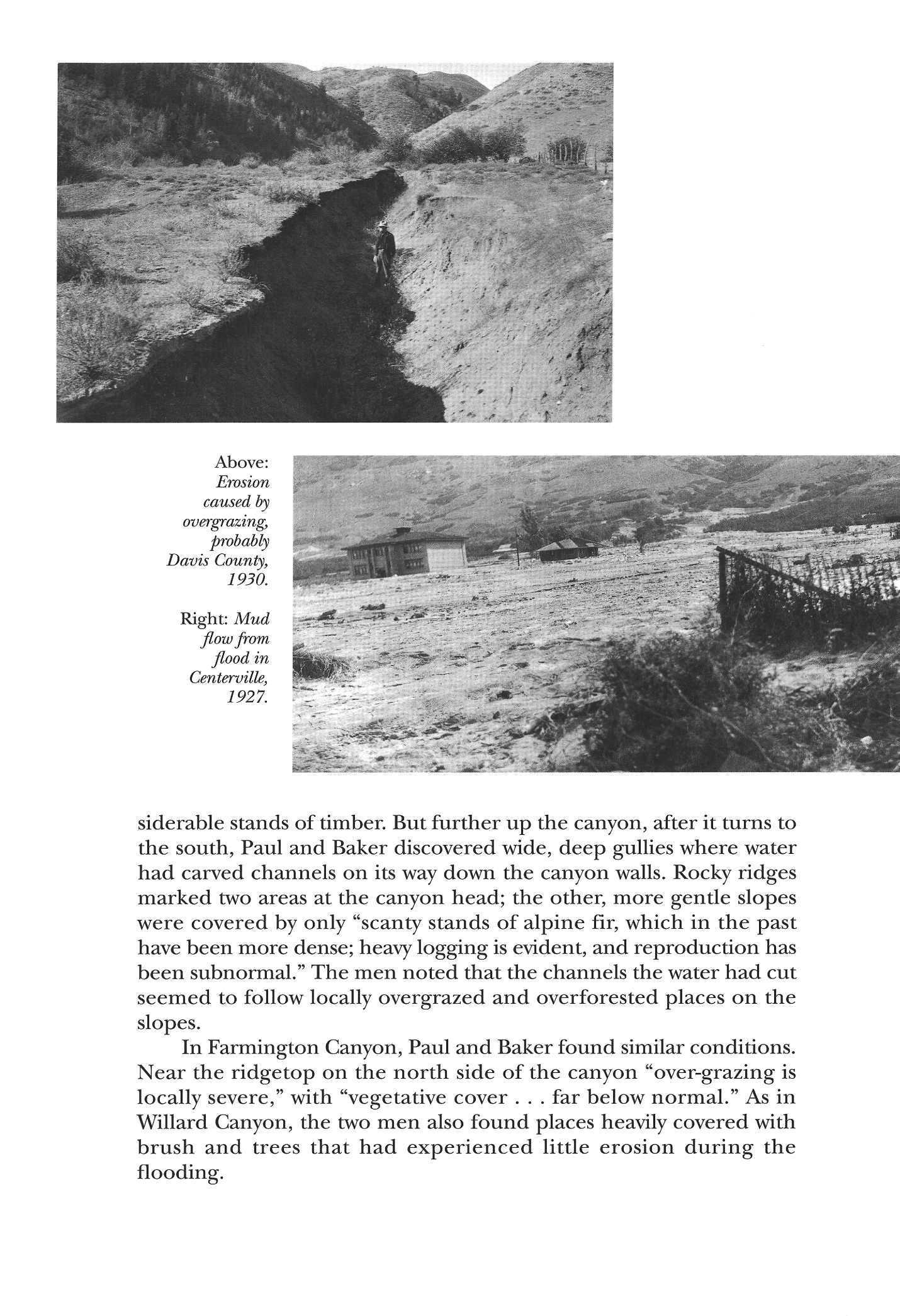
..,.;_;,. :-••
Above: Erosion caused by overgrazing, probably Davis County, 1930.
Right: Mud flow from flood in Centerville, 1927.
From the evidence in the two canyons, Paul and Baker concluded that "fires and over-grazing bring about disastrous floods," and they noted that even small patches of bare ground near ridgetops could funnel torrents of water onto the land below. Even if the lower part of a canyon—as was the case in Willard Canyon—retains a heavy brush and timber cover, this only serves to add debris to a flow that begins on depleted upper slopes The two men also recognized the contribution of excessive logging to flooding According to their research, even small stands of timber can help prevent serious erosion, and even "large, firm weeds and grasses (mountain sunflower, lupine, horse mint, and similar plants), suffice to prevent the initiation of erosion on all but the steepest slopes." To combat future flooding, Paul and Baker recommended two basic steps: protection and revegetation of critical areas in the local watersheds, and county government ownership and regulation of the most critical land But it would take another series of destructive floods just five years after the publication of their study for these ideas to gain widespread acceptance and for public officials to do something.36

Overgrazing and timber cutting were not the only ways that people in Utah altered the environment and increased flooding. By 1904, three large copper smelters were in operation in the Salt Lake Valley, all located between Murray and Midvale, south of Salt Lake City. One by-product of the smelting process was a toxic sulfur dioxide gas that the smokestacks emitted into the air. When weather conditions were just right, southerly winds and rains brought the poison all the way to the Salt Lake City limits. Local farmers complained of dead animals and extensive crop damage, and a particularly steady series of winds in June 1904 devastated a wide swath of country, even "burning trees." The farmers did not take this lying down They held a series of meetings in the fall of 1904 and brought a large suit against the copper companies in the winter of 1905. Almost two years later, in November 1906, the farmers won their case, and the resulting decision effectively slowed copper smelting in the Salt Lake Valley until plants cleaned up their emissions.37
Although there exists no direct evidence that sulfur dioxide gas poisoned the forests along the Wasatch Mountains, the Garfield Smelter across the valley, which was not affected by the 1906 decision,
36 Paul and Baker, "Floods of 1923," 4-20
Utah Floods 39
37 Deseret News, February 8, 1905, November 5, 1906; Leonard J Arrington and Gary B Hansen, "The Richest Hole onEarth": A History of the Bingham CopperMine (Logan: Utah State University Press, 1963), 18-19
provides evidence of how a copper smelter can destroy the environment surrounding it. At the turn of the century, the Kennecott Company built the $10 million Garfield Smelter at the north end of the Oquirrh (ironically, an Indian word meaning "wooded mountain") Range, twenty-two miles west of Salt Lake City. The smelter sat at the mouth of Coon Canyon, once an important source of timber for Salt Lake City Poisonous gases emanating from the plant soon purportedly killed "almost every vestige of spruce, maple, and oak, and the canyon stream began to flow black with the accumulated top soil of ages," resulting in serious flooding from the canyon. 38
In 1927, officials at the Garfield Smelter called on none other than Luther M Winsor to help them solve the problem of flooding in Coon Canyon. With Winsor's assistance, the company built a huge flood control barrier with a crest eighty-three feet above the streambed. A year later, accumulated debris behind the barrier forced the company to raise the height of the structure to one hundred feet and make provisions for raising it higher as needed Certainly, the Kennecott Company had incurred an unexpected expense by situating its smelter at the mouth of Coon Canyon.39
OnJuly 10, 1930, heavy thunderstorms hit Weber, Davis, and Salt Lake counties. The cloudburst storms left ruin over a 150-mile stretch along the Wasatch Front, from Spanish Fork Canyon north to the Idaho border. All along the Front, streams of muddy water and debris emerged from mountain canyons, and high water out of Emigration, Red Butte, and Parleys canyons plagued Salt Lake City.40
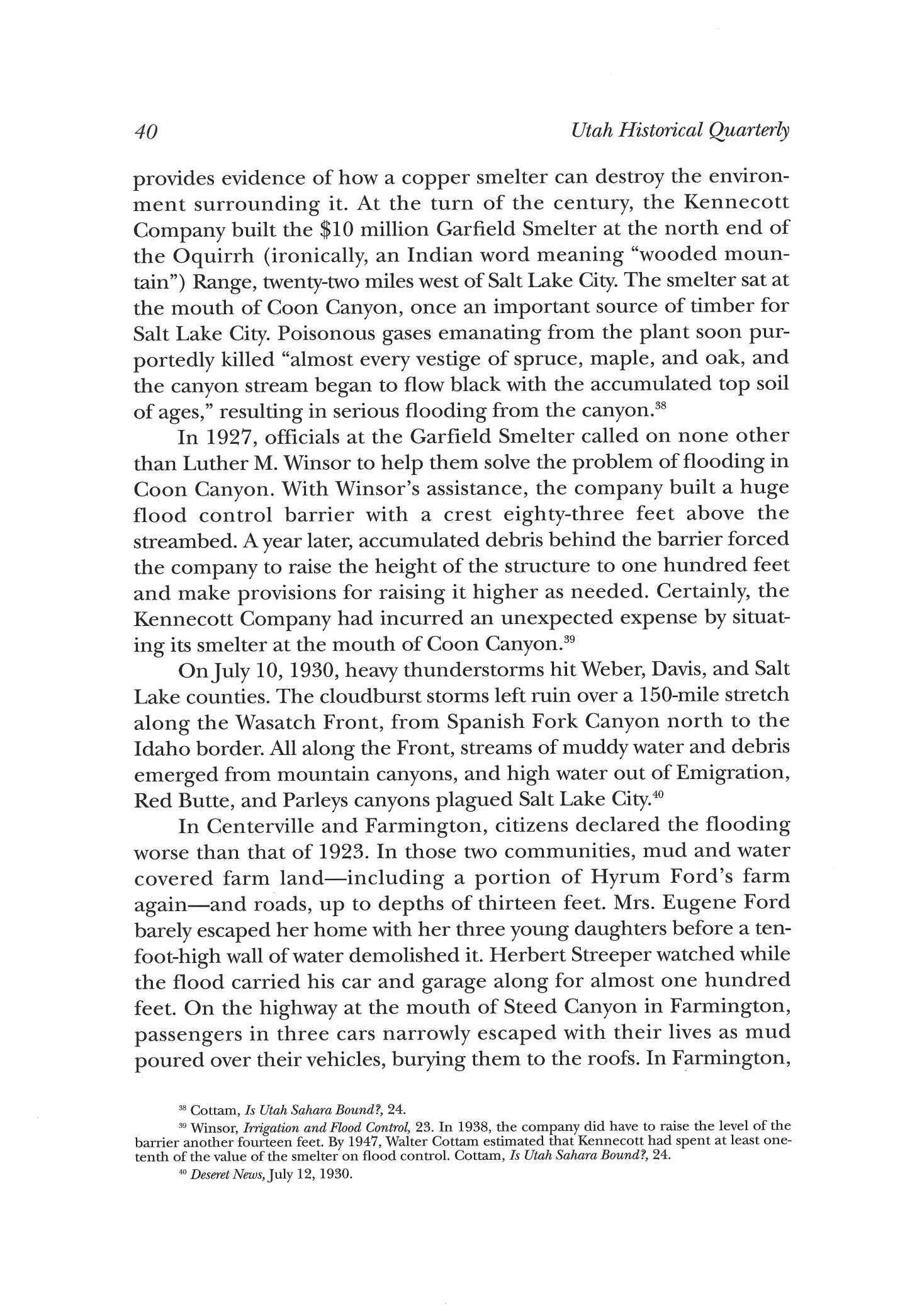
In Centerville and Farmington, citizens declared the flooding worse than that of 1923. In those two communities, mud and water covered farm land—including a portion of Hyrum Ford's farm again—and roads, up to depths of thirteen feet. Mrs. Eugene Ford barely escaped her home with her three young daughters before a tenfoot-high wall of water demolished it Herbert Streeper watched while the flood carried his car and garage along for almost one hundred feet. On the highway at the mouth of Steed Canyon in Farmington, passengers in three cars narrowly escaped with their lives as mud poured over their vehicles, burying them to the roofs. In Farmington,
40
40 Utah Historical Quarterly
38 Cottam, Is Utah Sahara Bound?, 24
39 Winsor, Irrigation and Flood Control, 23 In 1938, the company did have to raise the level of the barrier another fourteen feet. By 1947, Walter Cottam estimated that Kennecott had spent at least onetenth of the value of the smelter on flood control Cottam, Is Utah Sahara Bound?, 24
Deseret News, July 12, 1930
mud, rocks, and gravel buried Mr. and Mrs. Ronald Olsen to their necks. Mr. Olsen described what had happened:

It happened so quickly we didn't know what it was all about We heard a terrific clap of thunder and my wife and I rushed to the porch on the south side of the house The next thing we knew we were flipped 20 feet We heard the roar of water Our home seemed to leap right at us The porch fell right on us, pinning us to the earth. Then came a wall of water and mud and sand. We couldn't breathe. It seemed to stop as suddenly as it started I can't figure out yet why we were not killed.41
A month later, from August 10 to 14, heavy rainstorms again battered the Wasatch Front, and the flooding resumed Debris-laden water demolished twenty homes in Bingham, leaving an eight-foot layer of mud through much of the town. Walls of water and debris once again washed out roads and damaged crops in Farmington and Centerville.42 State Senator George H. Ryan was traveling to Ogden when a storm hit Centerville on August 11 Ryan described the scene:
Fertile acres were covered by a mass of chocolate-colored waters, about the consistency of a heavy paint Acres of orchard trees passed over the road on the muddy flood. One moment you would see a corn patch, or an onion field Then the flood would sweep across it and lay it low, burying it under a sea of mud The flood seemed to come in surges of red mud—waves perhaps a couple feet high would sweep across the deposits that had been left by preceding waves, leaving still more debris.43
These new storms and mudslides had hit as soon as cleanup crews had removed the debris from the previous storm. Mudslides and flooding also struck Ogden and Provo; one mudslide dammed the Provo River, creating a temporary artificial lake. On August 12, the floods claimed their only victim when a car overturned on a mud-slick road south of Mona, crushing fifteen-year-old Dean Johnson of Salt Lake City, who was riding on the running board. Over the next few days, floods struck new areas in Magna, Mona, and Pleasant Grove Finally, on September 4, the last of the flooding hit Davis County, again burying roads and fields in Centerville and Farmington under water, mud, and debris.44 The repeated heavy thunderstorms that summer created the most extensive and damaging flooding statewide since 1862. Estimates placed damages at well over $1 million, including the ruin of some of the state's best farmland. Governor George H. Dern pleaded with
Utah Floods 41
41 Salt Lake Tribune, July 11, 1930. 42 Deseret News, August 11, 1930; Salt Lake Tribune, August 10 and 12, 1930 43 Salt Lake Tribune, August 12, 1930 44 Deseret News, August 13, September 5, 1930; Salt Lake Tribune, August 13 and 14, 1930
Utah citizens to donate money for flood relief in Davis County and throughout the state.45
The destructive and recurrent nature of the floods also prompted Governor Dern to appoint a special commission to study Utah's flood problem. Dern placed eighteen men on the commission—engineers, geologists, forestry and range management specialists, ranchers, orchardists, farmers, businessmen, and lawyers, "with an efficient church leader and engineer [Sylvester Q. Cannon] as chairman."46 Dern instructed the commission to study "the recurring floods in Davis County and other parts of the State to ascertain whether any flood prevention measures are feasible Such a study must necessarily include the cause of the floods as well as the remedies."47 It took less than four months for the commission to finish its investigation and publish its findings. The resulting study, Torrential Floods in Northern Utah, 1930, discussed in detail the causes behind the flooding and proposed a number of possible solutions.

The commission outlined three main causes behind many of the 1930 floods: uncommonly heavy rainfall, topography and geological conditions favorable to runoff, and scant vegetation—due to overgrazing, overlogging, and fire—on portions of the watersheds. The commissioners concluded that heavy rainfall "may be expected in any year and at rather short intervals." After all, "such storms occurred only seven years apart, in 1923 and 1930, and four times during the summer of 1930." In their examinations of the state's topography, the men noted the numerous short, steep canyons along the Wasatch Front—some canyons drop 4,500 feet in less than four miles—that "greatly encourage sudden rapid surface run-off from rapid downpours of rain." The commissioners explained that humans had no way to control or change the weather or topography of the region This left depleted plant cover as "the only one of the three factors contributing to the floods over which man can hope to exercise any control of consequence."
In studying scant vegetation and its role in flooding, the commission focused its attention on the canyons of Davis County, north of Salt Lake City. They found in these canyons great variation in the vegetative
45 Deseret News, August 16, 1930; Salt Lake Tribune, August 12, 1930
46 Luther M Winsor, "Control of Floods in Mountain Streams," circa 1934, 1-2, L M Winsor Papers, MS 98, Box 1, Folder 6, Special Collections, Merrill Library; TorrentialFloods in Northern Utah, 1930, Report of the Special Flood Commission Appointed by Governor George H Dern, Agricultural Experiment Station Circular No 92 (Logan: Agricultural Experiment Station, Utah State Agricultural College, 1931), 5-6
47 TorrentialRoods in Northern Utah, 1930, 5, 7, 31-34
42 Utah Historical Quarterly
cover. Dense brush, chiefly scrub oak, covered the slopes of the main parts of the canyons At the heads of the canyons, the commissioners noted "dense stands of aspen, sagebrush and brush patches of chokecherry, snowberry, and other shrubs, but with little or no undercover." The men found the high ridges at the canyon heads in the worst condition: "almost barren or .. .only scrubby stands of sagebrush . .. also considerable areas of practically barren watershed having only a scattered stand of shrubs, or of niggerhead [now called western coneflower], lupine, and other weeds." From the character of the canyons and the remnants of certain species, the commissioners concluded that the depleted areas "formerly had a much heavier stand of grasses, weeds, snowberry, and other shrubs." They blamed the depletion on overgrazing, fire, and the overcutting of timber, each of which had contributed to the overall destruction of the watersheds. Overgrazing had removed the grass and shrub cover from the soil that helped anchor the ground in place; excess logging and uncontrolled fires had removed the trees and undergrowth that served as important breaks and checks to erosion. The commissioners concluded that if the original plant cover in the Davis County canyons had been in place, "the flooding in that section from the rains of 1930 would have been far less serious, if not prevented."
The commissioners went on to provide an agenda for floodplagued communities to follow and to recommend four major policies for Davis County and the rest of the state.48 First, the commission recommended that either the state or federal government acquire control of all critical watershed lands. This would allow for the proper implementation of a program to restore plant cover, the subject of the final three proposals. To allow for and aid in watershed rehabilitation, the commissioners recommended the exclusion of domestic grazing animals from critical lands, combined with the seeding and planting of suitable grasses, weeds, shrubs, and trees. Finally, the commissioners recommended the establishment of effective fire prevention and suppression measures to help reduce future denudation of the land.49
The importance of these suggestions should not be overlooked. Finally, a statewide investigative commission had argued for significant
48 At the same time that Dern's commission was involved in studying the floods, William Peterson, director of the USAC Extension Service, was involved in the debate over whether to turn federal land in the West over to the various states Peterson used the rampant flooding of 1930 as an argument for continued federal control Congress passed the Taylor Grazing Act four years later, withdrawing federally owned western lands from public entry For more on Peterson's role in developing this policy, see Kevin Dean Hatfield, The Tail Wags theDog: State Versus Federal Control in the PublicDomain Debate, 1929-1934 (M.A thesis, Utah State University, 1994)
49 TorrentialFloodsin Northern Utah, 1930, 19-22
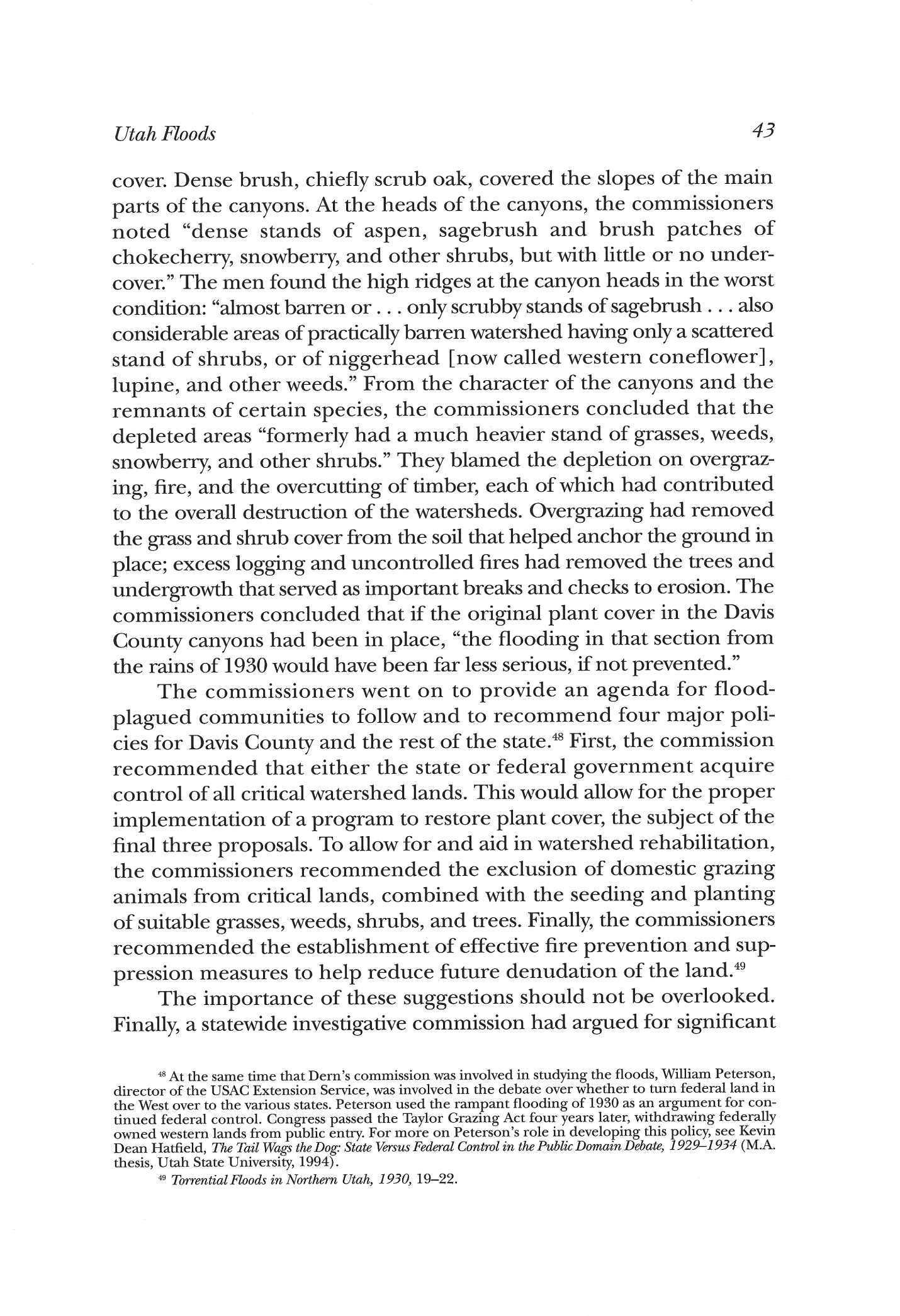
Utah Floods 43
changes in land-management practices. Of course, recommendations in a report and actual acceptance and execution of such recommendations are two different matters, and Utahns could not restore the local watersheds overnight Yet the findings and recommendations of Governor Dern's commission marked a change in the approach toward Utah's flood problem and also provided a model that would prove beneficial in the years to come.
One immediate result of the commission's report was a bill passed by the 1931 state legislature that provided for the reorganization of the State Land Board. This bill charged the new board with the "responsibility of studying the problem of flood prevention and control in Utah and taking initial steps toward putting a constructive program into operation."50 The board immediately engaged the director of the Intermountain Forest and Range Experiment Station, C L Forsling, to supplement the work of Governor Dern's commission and make an extensive survey of Utah flooding.
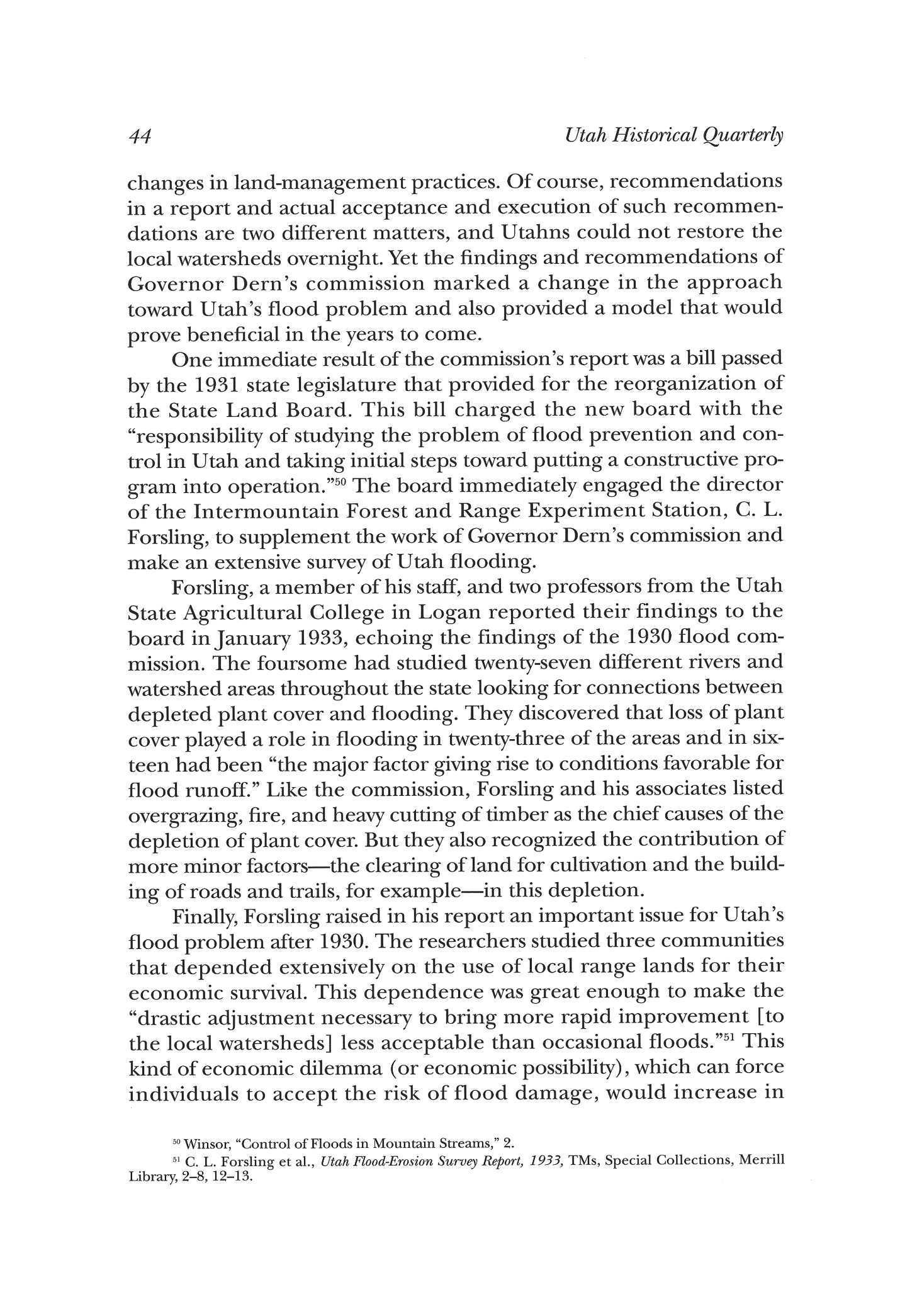
Forsling, a member of his staff, and two professors from the Utah State Agricultural College in Logan reported their findings to the board in January 1933, echoing the findings of the 1930 flood commission The foursome had studied twenty-seven different rivers and watershed areas throughout the state looking for connections between depleted plant cover and flooding. They discovered that loss of plant cover played a role in flooding in twenty-three of the areas and in sixteen had been "the major factor giving rise to conditions favorable for flood runoff." Like the commission, Forsling and his associates listed overgrazing, fire, and heavy cutting of timber as the chief causes of the depletion of plant cover. But they also recognized the contribution of more minor factors—the clearing of land for cultivation and the building of roads and trails, for example—in this depletion.
Finally, Forsling raised in his report an important issue for Utah's flood problem after 1930. The researchers studied three communities that depended extensively on the use of local range lands for their economic survival. This dependence was great enough to make the "drastic adjustment necessary to bring more rapid improvement [to the local watersheds] less acceptable than occasional floods."
51 This kind of economic dilemma (or economic possibility), which can force individuals to accept the risk of flood damage, would increase in
50 Winsor, "Control of Floods in Mountain Streams," 2.
51 C L Forsling et al., Utah Flood-Erosion Survey Report, 1933, TMs, Special Collections, Merrill Library, 2-8, 12-13
44 Utah Historical Quarterly
importance as urban areas expanded and the factor of human choice began to play a more prominent role in flood damage.
The year after Forsling made his report to the State Land Board, he and two associates published a brief study titled Floods and Accelerated Erosion in Northern Utah. In the study, the three men examined in depth the same 1923 and 1930 Davis County floods that had captured the attention of the flood commission. Their conclusion differed from that of the commission in that they placed sole blame for the excessive flooding on watershed conditions, discounting the contribution of topographical factors and uncommonly heavy rains

The three focused on the vegetation in Davis County's Ford Canyon, beginning with the former dominant plant cover By examining similar nearby canyons, as well as undamaged parts of Ford Canyon, they determined that dense stands of bunchgrasses interspersed with sagebrush had once dominated the Ford Canyon landscape. In the summer of 1930, however, only scattered, stubby remains of small shrubs predominated. All other plants had "been grazed almost to extinction by midsummer of that year." Even worse than this scattered vegetation was the fact that fully one-fourth of the area at the canyon's head lay practically bare The researchers compared Ford Canyon with nearby Centerville Canyon. In 1930, Centerville Canyon had retained a thick cover of vegetation, especially at the canyon's head, and had not been a source of flooding. Since Centerville Canyon closely resembled Ford Canyon topographically and had received similar amounts of rainfall, Bailey, Forsling, and Becraft concluded that overgrazing—leading to the depletion of plant cover— had been the causative factor in the flooding.52
Following the studies of the 1930 floods, two developments marked an increase in concern for Utah's watersheds. In 1933, public officials in Davis County established the Davis County Experimental Watershed as an experiment in flood control through the improvement of vegetative cover. Over the next fifteen years, this project, located in the Wasatch National Forest, would prove a model for watershed rehabilitation.53
52 Reed W Bailey, C.L Forsling, and R.J Becraft, Floods and Accelerated Erosion in Northern Utah, U S Department of Agriculture Miscellaneous Publication No 196 (Washington, D.C.: Government Printing Office, 1934), 13-21 Bailey worked as a professor of geology at Utah State Agricultural College, and Becraft worked as an associate in range management at the Utah State Agricultural Experiment Station It is almost certain that this published study resulted directly from the work Forsling had done for the land board
53 A Russell Croft, "History of the Davis County Experimental Watershed," TMs, Special Collections, Merrill Library
Utah Floods 45
A year later, Congress passed the Taylor Grazing Act, withdrawing some 173 million acres of federal lands in the western states from public entry. The flooding of the 1920s and 1930 had helped to cement the support of Utah's governor and congressional delegation for this reversal of public land policy.54 Under this new act, the Grazing Service began to restrict and supervise grazing on much of Utah's range land. By 1940, officials had reduced the number of sheep grazing on Utah's land by almost one million from the 1930 level of almost three million and had stabilized the cattle population at around 450,000. The Taylor Grazing Act helped to hasten the restoration of Utah's watersheds.55 Also in 1934, Salt Lake City commissioners made it unlawful for individuals to drive animals into the city's watersheds. City commissioners instructed animal control officials to impound any loose cattle or sheep found in those areas. 56
Along with the newfound concern for watershed lands, the 1930s saw the continued expansion of flood control works throughout Utah. As part of the program to combat the depression, federal officials had established twenty-six Civilian Conservation Corps (CCC) camps in Utah by 1933, and camp members devoted the majority of their time to building flood control works.57 CCC labor built and improved spillways and structural controls in Box Elder and Davis counties; built a series of rubble masonry spillways and barriers on Salina Creek, Escalante Creek, La Verkin Creek, Ash Creek, Hurricane Creek, and the Virgin River; and built a series of channel control structures on the Santa Clara River.58
At the foundation of this expansion of flood control works lay notions of human domination of the environment. The words of Luther M. Winsor, who outlined and supervised the flood control works programs for all CCC camps, best illustrate this attitude. When discussing the extensive work of the 1930s, he noted that both Salina Creek and the Virgin River had "been placed under control" by the construction of flood control works. In addition, Winsor stated that
54 For a complete treatment of this, see Stanford J Layton, To No Privileged Class: The Rationalization of Homesteading and Rural Life in the Early Twentieth-Century American West, Charles Redd Monographs in Western History, No 17 (Provo: Brigham Young University, 1988) Layton includes the flooding along the Wasatch Front as one of four factors that came together in the 1930s to change federal land policy

55 Peterson, "Natural Resource Utilization," 662; Cottam, Is Utah Sahara Bound?, 4
56 Revised Ordinances of Salt Lake City, Utah, 1934, sees 1500, 1550
57 Winsor, Irrigation and Flood Control, p ii; Peterson, "Natural Resource Utilization," 662; Kenneth W Baldridge, "Reclamation Work of the CCC," Utah Historical Quarterly 39 (Summer 1971): 265-85
58 Winsor, "Flood Situation in Utah," 1-3
46 Utah Historical Quarterly
"at Washington, the town has been protected from floods which formerly swept and menaced the entire town."59
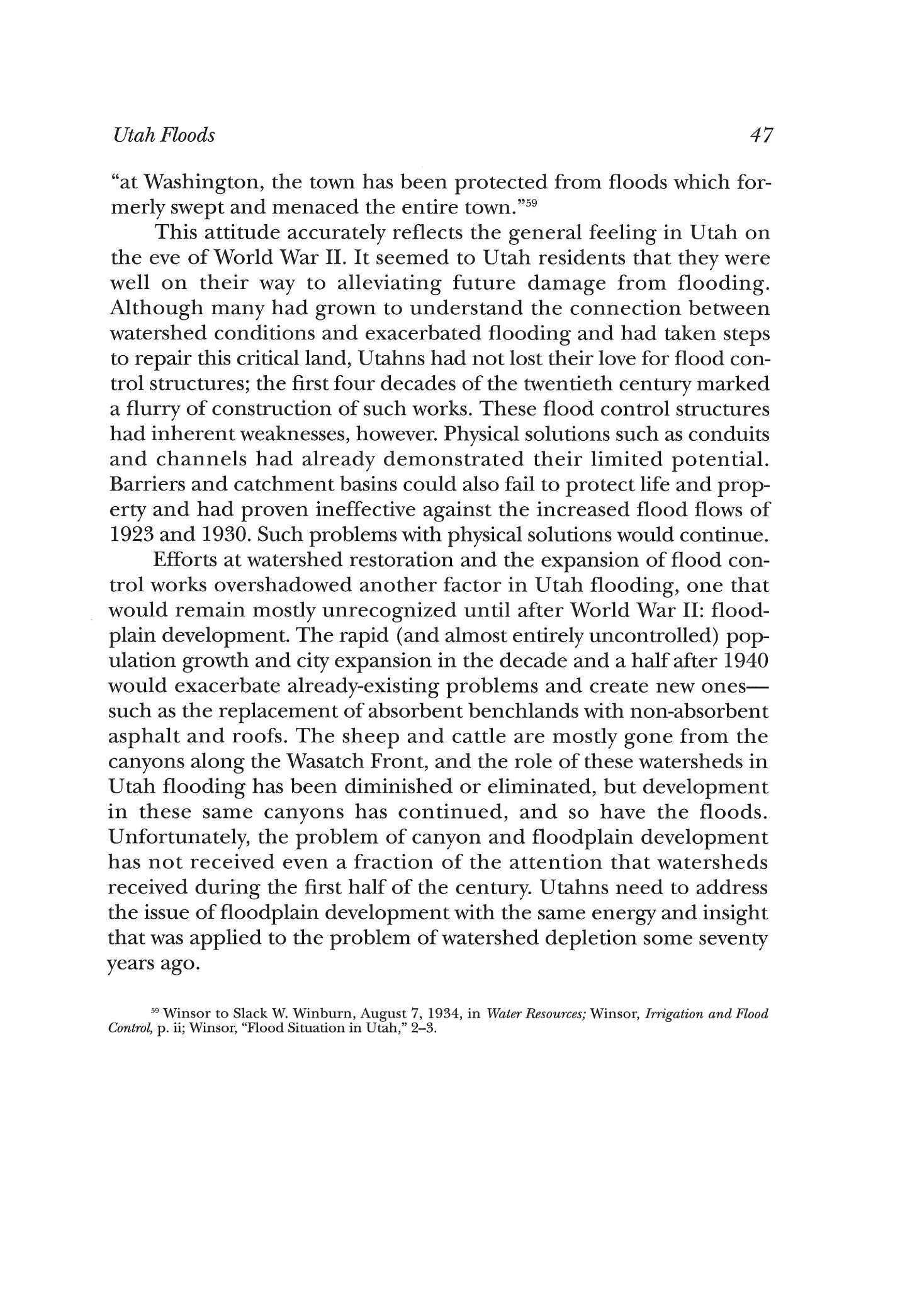
This attitude accurately reflects the general feeling in Utah on the eve of World War II. It seemed to Utah residents that they were well on their way to alleviating future damage from flooding. Although many had grown to understand the connection between watershed conditions and exacerbated flooding and had taken steps to repair this critical land, Utahns had not lost their love for flood control structures; the first four decades of the twentieth century marked a flurry of construction of such works. These flood control structures had inherent weaknesses, however. Physical solutions such as conduits and channels had already demonstrated their limited potential. Barriers and catchment basins could also fail to protect life and property and had proven ineffective against the increased flood flows of 1923 and 1930 Such problems with physical solutions would continue
Efforts at watershed restoration and the expansion of flood control works overshadowed another factor in Utah flooding, one that would remain mostly unrecognized until after World War II: floodplain development. The rapid (and almost entirely uncontrolled) population growth and city expansion in the decade and a half after 1940 would exacerbate already-existing problems and create new ones— such as the replacement of absorbent benchlands with non-absorbent asphalt and roofs The sheep and cattle are mostly gone from the canyons along the Wasatch Front, and the role of these watersheds in Utah flooding has been diminished or eliminated, but development in these same canyons has continued, and so have the floods. Unfortunately, the problem of canyon and floodplain development has not received even a fraction of the attention that watersheds received during the first half of the century Utahns need to address the issue of floodplain development with the same energy and insight that was applied to the problem of watershed depletion some seventy years ago.
Utah Floods 47
59 Winsor to Slack W Winburn, August 7, 1934, in Water Resources; Winsor, Irrigation and Flood Control, p. ii; Winsor, "Flood Situation in Utah," 2-3.
"The Murderous Pain of Living": Thoughts on the Death of Everett Ruess
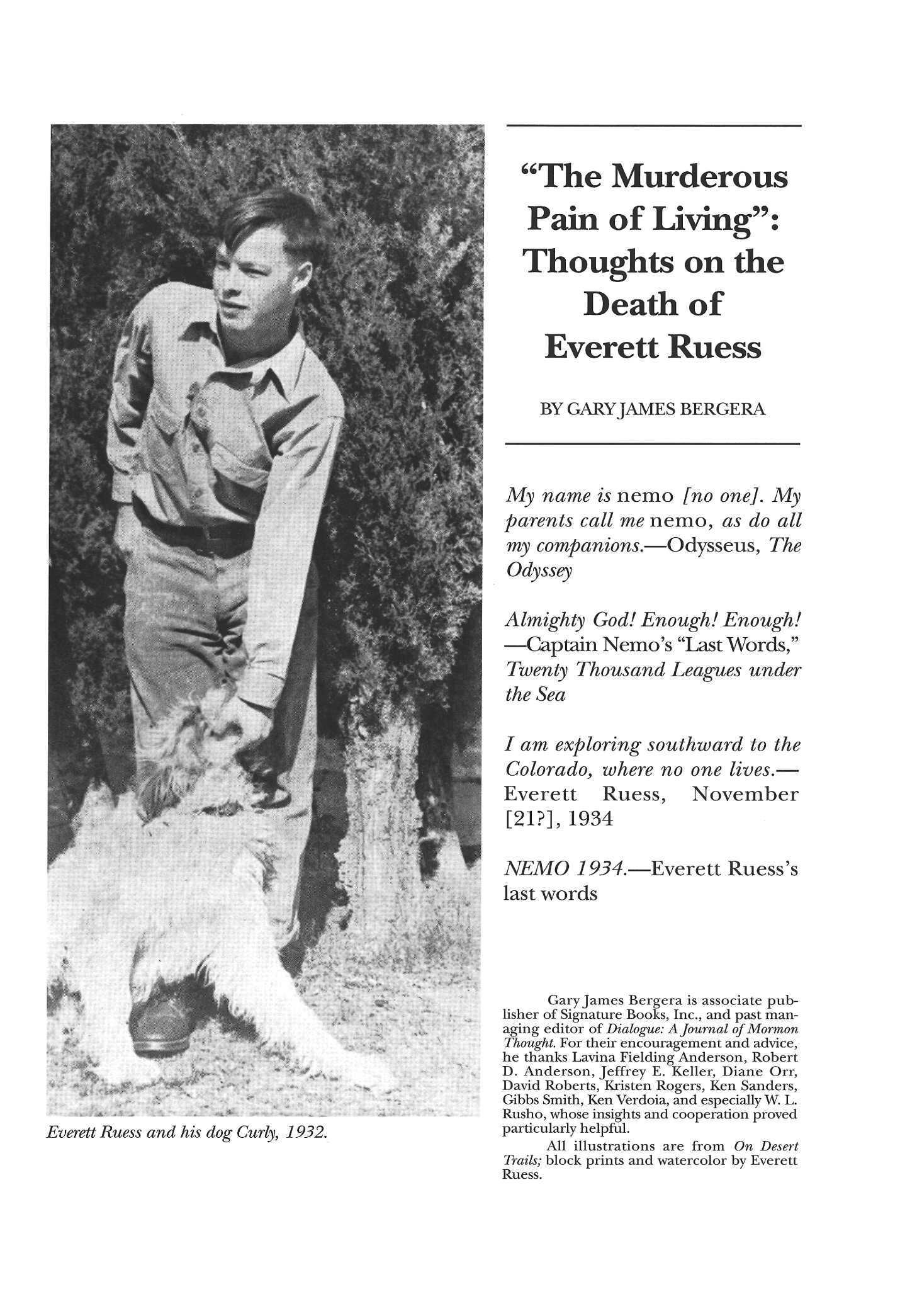 BYGARYJAMES BERGERA
BYGARYJAMES BERGERA
My name is nemo [no one]. My parents call me nemo, as do all my companions.—Odysseus, The Odyssey
Almighty God! Enough! Enough! —Captain Nemo's "Last Words," Twenty Thousand Leagues under the Sea
I am exploring southward to the Colorado, where no one lives.— Everett Ruess, November [21?], 1934
NEMO 1934.—Everett Ruess's last words
Gary James Bergera is associate publisher of Signature Books, Inc., and past managing editor of Dialogue: A Journal of Mormon Thought. For their encouragement and advice, he thanks Lavina Fielding Anderson, Robert D. Anderson, Jeffrey E. Keller, Diane Orr, David Roberts, Kristen Rogers, Ken Sanders, Gibbs Smith, Ken Verdoia, and especially W L Rusho, whose insights and cooperation proved particularly helpful.
All illustrations are from On Desert Trails; block prints and watercolor by Everett Ruess.
Everett Ruess and his dog Curly, 1932.
FO R MANY READERS OF EVERETT RUESS'S remarkable letters home, a terrible melancholy permeates almost every line. Born on March 28, 1914, the 5T0," 150-pound dreamer wasjust four months shy of his twenty-first birthday when he disappeared, virtually without a trace, southeast of Escalante, Utah, in November 1934. He had spent the better part of the previous four years tramping, starry-eyed and often alone, through the mountains and deserts of the American Southwest, hoping to satisfy a hungry aestheticism During the weeks and months away from his Los Angeles home, he chronicled his worship of nature in more than a hundred letters to his parents Christopher and Stella, his older brother Waldo, and a handful of friends. Some were no more than pencil scratches on a postcard; others filled pages. Most were evocative, heartfelt celebrations of a life lived on its own harrowing terms. Published in part in 1939 and 1940 and more fully in 1983, the letters have moved hundreds of thousands of readers with their haunting meditations on the universal quest for solitude, freedom, and understanding. 1 Because of them we easily forgive Everett's "callow romantic [ism]"2 and remember him not as hopelessly incompetent or self-indulgent but as the embodiment of our own youthful idealism.3
From Everett's revealing correspondence, it is tempting to speculate that the young poet knew even before he first left home as a precocious sixteen-year-old bound for intense adventure that he would one day succumb to what he called "the murderous pain of living."4 To date, the three most likely explanations for Everett's disappearance are (1) he died falling from a cliff, drowning in a river, or becoming lost in a canyon maze; (2) he was murdered by white cattle rustlers or local renegade Native Americans; or (3) he trekked south into Arizona
1 After Everett's disappearance, his parents assembled excerpts from his writings and artwork Their manuscript, "Youth Is for Adventure," served as the basis for the handful of Everett's letters published throughout 1939 in Desert Magazine. A fuller selection appeared the next year in On Desert Trails with EverettRuess (El Centro, CA: Desert Magazine Press, 1940), which was reprinted ten years later A new edition of On DesertTrails, prepared by GaryJames Bergera and featuring a new epilogue by W L Rusho, is scheduled for publication by Gibbs Smith Publisher To date, the most complete compilation of Everett's correspondence is Rusho's engaging Everett Ruess:A Vagabondfor Beauty (Salt Lake City: Peregrine Smith Books, 1983). In preparing A Vagabondfor Beauty, Rusho had to rely on typescripts prepared by the Ruess family; there are occasional differences between the holographs and the published transcriptions Where the difference is significant, and the original document available, I cite the original
2 Wallace Stegner, Mormon Country (New York: Duell, Sloan and Pearce, 1942), 321
3 Everett's story has been recounted in a variety of publications In fact, Gary Topping prefaces his own recent treatment of Everett with: "So much paper and ink have been expended on Ruess, especially on speculations regarding his mysterious disappearance from an Escalante side canyon in 1934, that it almost seems an environmental crime to add to the expenditure " (Glen Canyon and the San Juan Country [Moscow: University of Idaho Press, 1997], 317)
4 Portion of an untitled essay, quoted in a letter to Edward Gardner, May 1934; see Rusho, Vagabond, 148

Everett Ruess 49
or Mexico and lived beyond 1934.5 In what follows I would like to explore another possibility and suggest that Everett, depressed, battling health problems, and perhaps wrestling with his own sexuality, may have committed suicide. I realize that such psychologically oriented discussions are difficult enough for the living, let alone the dead, and that even at their most cautious they are highly speculative. I am also aware of the danger that, because such analyses tend to focus on dysfunction, they may achieve little more than to reduce their subjects to one-dimensional caricatures This is certainly not my intention WThile I focus on particular aspects of Everett's character at the exclusion of others, I personally find him a charming, albeit troubled, young writer of considerable promise whose death is a tragedy we will never fully explain. Finally, I appreciate that such studies may actually reveal as much—if not more—about their writers, or the times during which they write, as about their subjects. With these important caveats firmly in mind, I believe that what emerges from a careful review of Everett's writings is a portrait of a gifted yet depressive young artist whose tortured engagement with life both powered his creative expression and propelled him toward his own self-destruction.6
I went to the woods because I wished to live deliberately, to front only the essential facts of life, and see if I could not learn what it had to teach, and not, when I came to die, discover that I had not lived
—Henry David Thoreau
Everett Ruess is most accessible to us today through his letters, journals, poems, essays, and stories—some 175,000 words—as well as his blockprints and watercolors. His letters, articulate and insightful, became his "principal vehicle of expression" during his wilderness wanderings. While the letters "offered [him] an assured, sympathetic audience," they also gave voice to his overwhelming feelings of awe and allowed him to create a persona that better reflected the image he had—or wanted to have—of himself Finally, their careful "draft-
5 His father, Christopher (Rusho, Vagabond, 206), and newspaper reporter John Terrell (Salt Lake Tribune, August 24-27, 1935) believed that Everett had been murdered In 1952, however, his parents reportedly said they thought he died while trying to cross the Colorado River (see Norris Leap, "Utah Canyons Veil Fate of L.A Poet," Los Angeles Times,June 15, 1952)
6 This approach differs from that which sees Everett as having "cleansed himself of society's expectations and, in a way, transformed himself into a deeper, more complete, and more fulfilled person" (Mark Taylor, Sandstone Sunsets: In Search ofEverett Ruess [Salt Lake City: Gibbs Smith Publisher, 1997], 37, 55).

50 Utah Historical Quarterly
ing and polishing"7 suggest that Everett may, in fact, have sanctioned a more probing analysis of their possible meaning.
Even before his first extended solo foray into the California mountains, Everett was drawn to the romance of the "deserted field."8 In 1930, at age sixteen and with his parents' blessing, he headed alone up the California coast, then on toYosemite and the Sierra Nevada.9 His chatty letters home only hint at the "blue moods" his later writings would disclose.10 "Whenever I consider trails," Everett wrote after this trip, "a strange, deep longing fills me to be rambling on a curving pathway."11
Upon graduating from high school in January 1931, Everett, increasingly convinced that he could find true happiness only in the wilderness, left for Monument Valley on the Utah-Arizona border. In view of his age and inexperience, this act appears "genuinely foolhardy,"12 yet it is also in keeping with his reckless approach to danger. Off and on for the next three and a half years, Everett, blissfully oblivious to his own shortcomings, traveled the deserts, canyons, and mountains of northern Arizona, eastern Colorado, western California, and southern Utah virtually penniless and frequently alone except for a pack burro or two and a stray dog he adopted.
After Monument Valley, Everett wandered to Canyon de Chelly, the San Francisco Peaks, the Grand Canyon, Zion National Park, and Arizona's Salt River Valley. In December he returned to Los Angeles, but the next year, 1932, he was back in Arizona. He visited the Salt River Valley, Roosevelt, Ganado, and Canyon de Chelly before heading northeast to Mesa Verde, then to the Grand Canyon.
That September he enrolled in the University of California at Los
7 Rusho, Vagabond, 9
8 Everett had visited the Sierra Nevada and Yosemite several times before the summer of 1930 Some early adolescent poems—"The Relic," "Two Arrowheads," "The Indian Council Cave," and "Pledge to the Wind"—demonstrate his fascination with wilderness See On Desert Trails and Vagabond.

9 "The thing for you to do," his father had counseled several years earlier, "is to stick to your hobbies, whether art, or naturalist's interest, or chemistry, and so knowjust what you are going to college for
If you find yourself now you have a head start on all who wait till they are grown up to begin to start to prepare Think this over" (Christopher to Everett, October 26, 1927, previously unpublished) Photocopies of previously unpublished Ruess materials cited throughout this essay are in the possession of Gibbs Smith Publisher, Layton, Utah
10 See letter to Father, Mother, and Waldo, August 22, 1930; also in Rusho, Vagabond, 23 Everett's salesman father had hoped that the experience away from home, which he thought was "fully equal to any course at High School," would help Everett learn how to "meet people and desire topleasethem, which is the act of personal charm If you don't learn instinctively to desire to pleaseyou will not develop charm After all, charm and personality and most of these fine things are just forms of unselfishness, thoughtfulness for others" (Christopher to Everett, July 30, 1930, emphasis in original, previously unpublished)
11 "Trails," Hollywood High School theme, 1930, in 'Youth Is for Adventure." Ruess also composed four new poems at this time: "Colors I've Failed to Catch," "Life Is a Song," "My Life Shall Be a Little Curling Wave," and "My Soul Set Free." The latter two are notable for containing the earliest known allusions to his own death See On Desert Trails.
12 Rusho, Vagabond, 26; see also Topping, Glen Canyon, 317-18
Everett Ruess 51
Angeles, but he dropped out early in 1933. From June to October he hiked the Sierra Nevada, then he relocated to San Francisco, a city that he hoped would be more conducive to his creative temperament. By the next March, however, he had decided to return to the desert. From Monument Valley, he ventured to Navajo Mountain and Rainbow Bridge, then southeast to Gallup, New Mexico, continuing to the Grand Canyon, Flagstaff, Oak Creek Canyon, and the Grand Canyon again In October he moved north into Utah, where he visited Bryce Canyon National Park, passed through Tropic, and came, finally, to Escalante.
Everett's passion for nature and his blossoming skill as a writer are perhaps most evident in a letter he wrote in May 1934, six months before his disappearance. "[T]he other night at twilight, unwilling to drown my consciousness in slumber, and dissatisfied with life, I packed and saddled my burros, and left my camp by a rushing stream at the edge of the desert," he began

The half moon had an orange glow as I rode on the trail up the mountains Behind us, thunder boomed on the open desert, and black clouds spread Moaning winds swept down the canyon, bending the tops of the tall pines and firs, and clouds hid the moon Silently old Cockleburrs, my saddle burro, carried me upward through the night, and Leopard followed noiselessly with the pack. Grotesque shapes of trees reared themselves against the darkening sky, and disappeared into the blackness as the trail turned
For a while the northerly sky was clear, and stars shone brilliantly through the pine boughs Then darkness closed upon us, only to [be] rent by livid flashes of lightning, and thunder that seemed to shake the earth. The wind blew no longer and we traveled in an ominous, murky calm, occasionally slashed with lightning. Finally the clouds broke and rain spattered down as I put on my slicker We halted under a tall pine, and my sombrero sheltered the glow of a cigarette The burros stood motionless with heads down and water dripping off their ears
52 Utah Historical Quarterly
Ruess and burros in the Sierra Nevada. Photo by Wes Visel.
In half an hour the rain was over and the skies cleared By moonlight we climbed to the rim of the mountain and looked over vast silent stretches of desert Miles away was the dim hulk of Shiprock—a ghostly galleon in a sea of sand
"Oh but the desert is glorious now," he closed, "with marching clouds in the blue sky, and cool winds blowing The smell of the sage is sweet in my nostrils, and the luring trail leads onward."13
After leaving Escalante on Sunday, November 11, 1934, Everett followed the old Hole in the Rock trail southeast toward the Colorado River and Davis Gulch, site of his last known camp. On the 19th he chanced upon two sheepherders and spent the next two nights with them. As they were heading back to town on the 21st, Everett handed them a letter to his brother Waldo and asked if they would mail it. "I think there is much in everyone's life that no one else can ever understand or appreciate without living through the same experiences, and most could not do that," he confided in what would be the last letter he ever wrote That is why "I've become a little too different from most of the rest of the world." "I have not tired of the wilderness," he continued; "rather I enjoy its beauty and the vagrant life I lead, more keenly all the time. . . . Do you blame me then for staying here, where I feel that I belong and am one with the world around me?" Despite attempts at friendship and a "civilized" life, Everett had come to realize he could never "settle down. I have known too much of the deeps of life already, and I would prefer anything to an anticlimax." "Often as I wander," he admitted, "there are dreamlike days times14 when life seems impossibly strange and unreal." It had been "a full, rich year," he reminisced, adding that he had "left no strange or delightful thing undone that I wanted to do." From there, he vowed, he would continue south, "where no one lives."15

II
To die in the open, under the sky, far from the insolent interference of leech and priest, before this desert vastness opening like a window onto eternity—that surely [would be] an overwhelming stroke of rare good luck
—Edward Abbey
Everett Ruess 53
13 Letter to Frances (surname unknown), May 1934, in Rusho, Vagabond, 149-51
14 This is mistranscribed as "tinges" in Rusho, Vagabondfor Beauty, 180
15 Letter to Waldo, "November the ? [21?] 1934 Escalante Rim, Utah," in Rusho, Vagabond, 178-80, 184
Everett's biographer, W L Rusho, is a cautious interpreter He doubts that Everett simply walked away from his last camp, since he "remained too close to his parents and to his brother" to have severed "all communication—forever." Nor does Rusho necessarily favor death by accident or murder.16 As he knows, the two most compelling pieces of evidence against the latter are the presence in Davis Gulch of Everett's two burros and the absence of his personal possessions. Everett's burros were found in a natural corral, healthy and reasonably well-fed. But almost all of his personal belongings were missing—the exceptions being a bridle, halter, and rope. If Everett had been murdered, why did the killer(s) leave his riding outfit and pack animals? If he had died in an accident, what happened to his blankets, clothes, money, camera, painting supplies, pictures, food, diary, etc.? If he had died somehow and someone had later come across his belongings and taken them, why didn't they take his burros and riding gear as well?17 If Everett wanted to cross the Colorado, some ten miles away, and continue south, how did he plan to transport his provisions?
When searchers entered Davis Gulch in early March 1935, they found the word "NEMO"—Latin for "no one"—scratched onto an Indian ruin and on a rock wall.18 At first, Everett's parents wondered if "NEMO" referred to The Odyssey, since they knew Everett had read T. E. Lawrence's 1932 prose translation of Homer's epic adventure.19
16 See Rusho, Vagabond, 182-213 "It is just about as difficult to see how Everett Ruess could have been murdered," Wallace Stegner had opined forty years earlier, "as it is to see how he could have got out of the Escalante Desert" (Stegner, Mormon Country [New York: Duell, Sloan and Pearce, 1942], 329) One of the most inventive recent explanations of Everett's possible murder came from writer Mark Taylor, who suggested in 1997 that Everett may have been killed by Emery Kolb, famous longtime explorer of and guide to the Grand Canyon and environs According to Taylor (Sandstone Sunsets, 89-94), Everett may have spurned Kolb's sexual advances, after which Kolb killed him and hid his body in a small boat he tied to the ceiling of a boathouse Taylor acknowledges, though, that there is no evidence that Kolb was homosexual. Actually, the mystery of the skeleton in the Kolb garage had been solved at least six years before Taylor's book was published William C Suran, while researching a brief history of Emery Kolb (and his brother Ellsworth), discovered from Kolb's diaries and letters that the skeleton was that of a prospector; Kolb had stumbled upon the skeleton and had been in possession of it as early as 1922 See Suran, The Kolb Brothers of Grand Canyon (Grand Canyon, AZ: Grand Canyon Natural History Association, 1991), 30-31. Periodically, "eye-witness accounts" of Everett's murder surface Such folklore is notoriously unreliable. Proof, such as remnants of Everett's personal belongings, would contribute significantly to verifying such reports To date, however, none of Everett's possessions has ever turned up

17 Mark Taylor reports that Gail Bailey, one of the members of the original Ruess search party, boasted of having proof that Everett's belongings had been found at the time. When Taylor pressed him, Bailey agreed to show him what he had; but he never appeared for their meeting (Sandstone Sunsets, 17, 109; remarks at an autographing/reception for Mark Taylor, Sam Weller's Bookstore, Salt Lake City, November 9, 1997)
18 According to Rusho (188), members of the Ruess search party found the word "NEMO" inscribed twice, first on the wall of a cave and then a mile away on the doorstep of an ancient Indian stone house He adds that one of the searchers told Everett's parents they also found the words "Nov 1934" carved in stone not far from the Indian house More recently, Mark A Taylor (Sandstone Sunsets, 10) has asserted, without documentation, that searchers found a longer message, "NEMO was here. Nov. 1934," carved in a "soft sandstone wall." Photographs of two inscriptions show only the words "NEMO 1934" (Rusho, Vagabond, 187, 189)
19 It is unclear how Everett could have known from The Odyssey, a Greek poem translated into English, that nemo is Latin for no one
54 Utah Historical Quarterly
Trapped in the cave of a cyclops, Odysseus refuses to reveal his true name to the one-eyed monster, thereby saving his life when the cyclops can only say that "no one"—"No-man," according to Lawrence—had blinded him. Thus, his parents guessed, Everett may have come to see himself as a romantic adventurer escaping the barbarians of modern civilization, or simply as a "no one" to everyone he had once loved.
Another possibility is that Everett was alluding to Captain Nemo, commander of the submarine Nautilus in Jules Verne's fantastic romance Twenty Thousand Leagues under the Sea.20 According to his parents, Everett had read the book several times, and his own copy was "well worn." "I'm not what you would call a civilized man!" Nemo explains early in the novel. "I've broken with all of society for reasons which I alone can appreciate. I therefore don't obey its rules ... " A little later: "[Ojne must live—live within the ocean! Only there can one be independent! Only there do I have no master! There I am free!" In the sequel, The Mysterious Island, which Everett had read in late 1928, Nemo was filled by the "whole civilized world" "with such disgust and horror" that "he wanted to leave it forever."21

Such statements would have resonated with Everett, and Rusho wonders if he, "like Nemo, felt that he had suffered too many defeats. He could have felt depressed and withdrawn, notwithstanding cheer-
20 Rusho, Vagabond, 210
Map showing where Ruess made his supposed last camp; map drawn by Norton Allen of Desert Magazine
21 Jules Verne, Twenty Thousand Leagues under the Sea, trans Anthony Bonner (New York: Bantam Books, 1962), 69, 74; Everett Ruess Diary, Nov. 11, 1928; Verne, The Mysterious Island, trans, and abr Lowell Bair (New York: Bantam Books, 1970), 198, 196
ful posturing in his letters." "Whatever the cause," Rusho continues, Everett's "withdrawal from organized society, his disdain for worldly pleasures, and his signatures as NEMO in Davis Gulch, all strongly suggest that he closely identified with the Jules Verne character." Everett was, Rusho concludes, "still impressionable, still able to project himself into idealistic, if unrealistic, roles. Could Everett have consciously determined that he would disappear, that he would 'break every tie upon earth,' so as to turn into Nemo himself?"22
"Everett's letters occasionally foreshadow his death or disappearance," Rusho admits, "almost as if he were making plans for one, or perhaps both, of these eventualities." He reports that when Everett left California for the last time for Arizona in 1934, he bade "goodbye to [Alec W.] Anderson [a retired librarian from Covina, California], then added, as an afterthought, 'And I don't think you will ever see me again, for I intend to disappear.'" But Rusho never pursues the possibility that Everett killed himself. True, he wonders if Everett "may have believed that he was failing, as an artist, to live up to his parents' and his own expectations." But for Rusho this probably meant that he had been "harboring, perhaps for years, a growing determination to strike out on his own, by cutting all ties to his parents," not that he was suicidal.23 Others have not been so reticent. Ironically, in his introduction to Rusho's biography, novelistJohn Nichols writes: "I picture [Everett] simply expiring on the edge of a sandstone cliff, in the shadow of some high circling buzzard, convinced that he could never again return to civilization." There "this tormented and eloquent pilgrim was engulfed and erased by the territory whose mysteries had absolutely conquered his entire being."24 Fourteen years later journalist Alex Shoumatoff ventured: "A final possibility is that Ruess climbed way up some cliff, settled into an alcove or down on some ledge out of sight from below, and, having no further interest in living, simply checked out, and his remains haven't been found yet."25
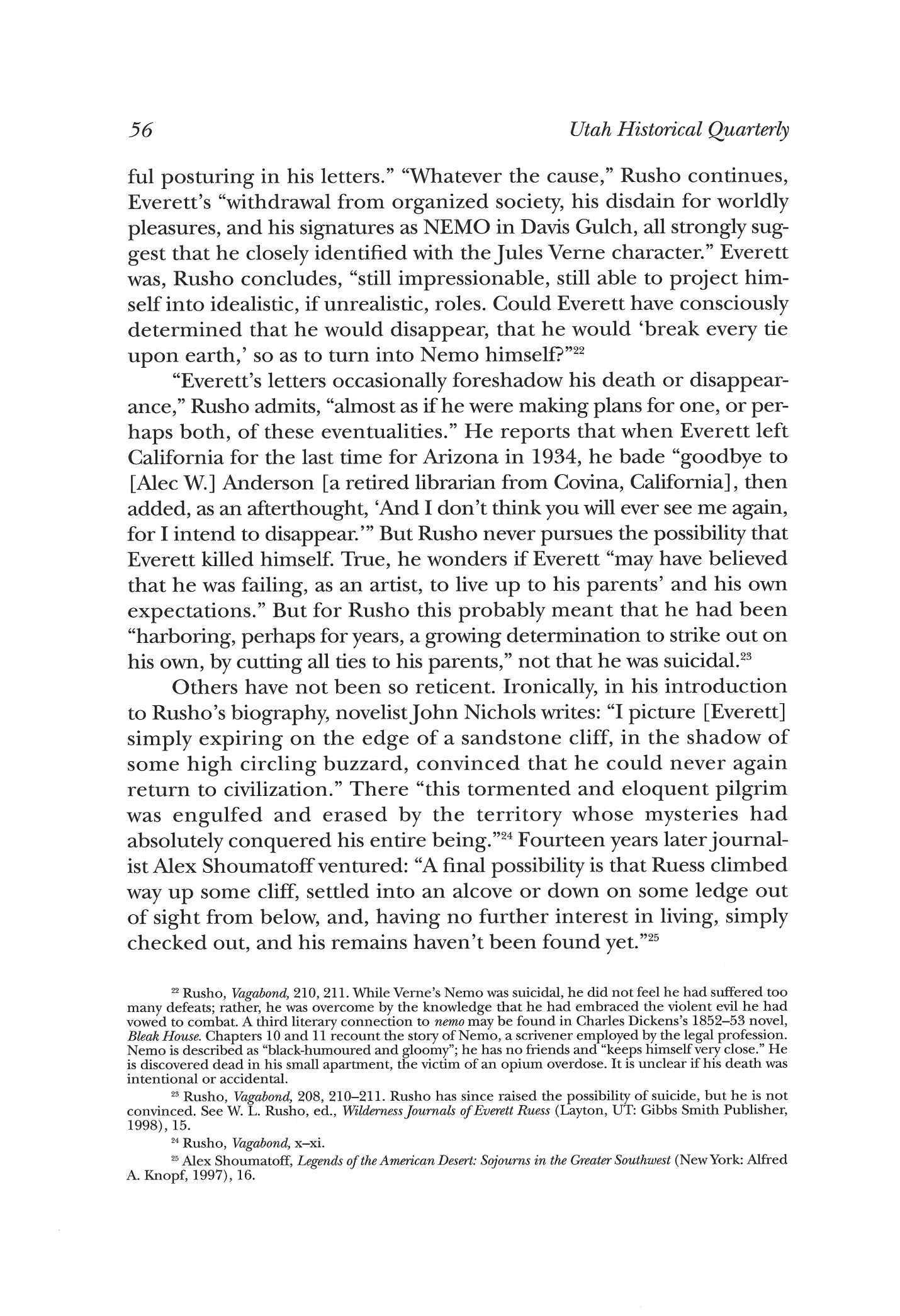
22 Rusho, Vagabond, 210, 211 While Verne's Nemo was suicidal, he did not feel he had suffered too many defeats; rather, he was overcome by the knowledge that he had embraced the violent evil he had vowed to combat A third literary connection to nemo may be found in Charles Dickens's 1852-53 novel, Bleak House. Chapters 10 and 11 recount the story of Nemo, a scrivener employed by the legal profession Nemo is described as "black-humoured and gloomy"; he has no friends and "keeps himself very close." He is discovered dead in his small apartment, the victim of an opium overdose. It is unclear if his death was intentional or accidental
23 Rusho, Vagabond, 208, 210-211 Rusho has since raised the possibility of suicide, but he is not convinced See W L Rusho, ed., WildernessJournals ofEverett Ruess (Layton, UT: Gibbs Smith Publisher, 1998), 15
24 Rusho, Vagabond, x-xi
25 Alex Shoumatoff, Legends of the American Desert: Sojourns in the Greater Southwest (New York: Alfred A Knopf, 1997), 16
56 Utah Historical Quarterly
III
Please don't be distressed because I'm the way I am. Just be grateful that I'm so much happier than most people and trying to go on an up-climbing curve, rather than marking time with those who have come from the regulation mold
—Richard Halliburton
Within the last twenty years, science has finally begun to outline the broad contours of the complex interplay between creativity and mental dysfunction.26 "The fiery aspects of thought and feeling that initially compel the artistic voyage," writes Kay Redfield Jamison, "commonly carry with them the capacity for vastly darker moods, grimmer energies, and, occasionally, bouts of 'madness.'" In fact, adds Arnold M Ludwig, "members of the artistic professions or creative arts as a whole . . . suffer from more types of mental difficulties and do so over longer periods of their lives than members of the other professions." For Everett Ruess, such distress may have manifested itself as alternating episodes of depression and hypomania (a mild form of mania) separated by periods of considerable normalcy—symptoms that today might indicate cyclothymia, often a precursor to manic depression.27 These and other mood disorders afflict as many as 15 million Americans annually, less than a third of whom are diagnosed as such. Tragically, their suicide rate is thirty-five times that of Americans generally.28
In his writings Everett revealed an expansive euphoria that could last days, weeks, and sometimes longer, as well as other symptoms of hypomania, such as irritability, grandiosity, sleeplessness, talkativeness, and racing thoughts.29 "Alone on the open desert," he wrote in 1931, "I have made up songs of wild, poignant rejoicing and transcendent melancholy. The world has seemed more beautiful to me than ever
26 "[T]here is strong scientific and biographical evidence linking manic-depressive illness and its related temperaments to artistic imagination and expression" (Kay Redfield Jamison, Touched with Fire: Manic-Depressive Illness and the Artistic Temperament [New York: The Free Press, 1993], 240). For a more clinical discussion of depression, see Frederick K Goodwin and Kay Redfield Jamison, ManicDepressive Illness (New York: Oxford University Press, 1990) See also Arnold M Ludwig's comprehensive The Price of Greatness: Resolving the Creativity and Madness Controversy (New York: The Guilford Press, 1995).

27 Jamison, Touched WithFire, 2, 14, 47-48, 102, 41; Ludwig, The Price of Greatness, 4
28 See Peter C. Whybrow, A Mood Apart: The Thinker's Guide to Emotion and Its Disorders (New York: Basic Books, 1997), 7, 18, 291.
29 These symptoms as well as those of depression are summarized from James Morrison, DSM-TV Made Easy: The Clinician's Guide to Diagnosis (New York: The Guilford Press, 1995), which in turn relies on Diagnostic and Statistical Manual of Mental Disorders, 4th ed. (Washington, D.C.: American Psychiatric Association, 1994)
Everett Ruess 5 7
before."30 The next year he reported that "[t]he beauty of the wet desert was overpowering."31 Three weeks later he had "[shaken] off my melancholy, gathered flowers under the red cliffs and chanted poetry in the hogan." He "wanted to write"; his thoughts raced; but he admitted that "the words would not come."32
Alone, he could be at his most delirious: "Then up the starlit road between the pillared redwoods," he enthused in 1933. "I munched chocolate and sang at the top of my voice . . . some Dvorak melodies. .. . [I] swung exultantly down the white pathway to adventure." 3 3 "[E]very once in a while I feel quite ecstatic," he told his family the next week. Unfortunately, "I slip out of such moods quite easily."34 Such confessions alarmed his parents. "No, I am in no danger of a nervous breakdown at present," he quipped the year before his death "How about you?"35 By the end of that summer he was so happy and filled to overflowing with the beauty of life that I felt I must tell you. All is a golden dream, with mysterious, high-rushing winds leaning down to caress me, and warm and perfect colors flowing before my eyes A gentle dreaming haze fills my soul, the unreal rustling of the aspens stirs my senses and the surpassing beauty and perfection of everything fills me with quietjoy, and a deep, overflowing love for my world.36
The next year, again in the open desert, he found himself "[o]nee more . . . roaring drunk with the lust of life and adventure and unbearable beauty." "I've been so happy," he gushed, "that I can't think of containing myself." "To live is to be happy," he exulted; "to be carefree, to be overwhelmed by the glory of it all. Not to be happy is a living death."37 "Even when to my senses the world is not incredibly beautiful or fantastic," he added, "I am overwhelmed by the appalling strangeness and intricacy of the curiously tangled knot of life, and at the way the knot unwinds, making everything clear and inevitable, however unfortunate or wonderful."38 "[T]he beauty of this country
30 Letter to Bill Jacobs, April 18, 1931; see Rusho, Vagabond, 39-40. Years earlier Everett's father had written: 'You have a good mind Now you need to observe people as you observe things and learn to make many friends. Try to please people You are a little like your daddy, who gets so interested in ideas at times that he is absentminded about people That is bad Because people have feelings" (Christopher to Everett, September 30, 1926, emphasis in original, previously unpublished).
31 Ruess Diary, July 1, 1932, in Rusho, WildernessJournals, 54
32 Ibid.,July 21, 1932, in Rusho, WildernessJournals, 71
33 Ibid.,June 11, 1933, in Rusho, WildernessJournals, 109; compare Rusho, Vagabond, 99
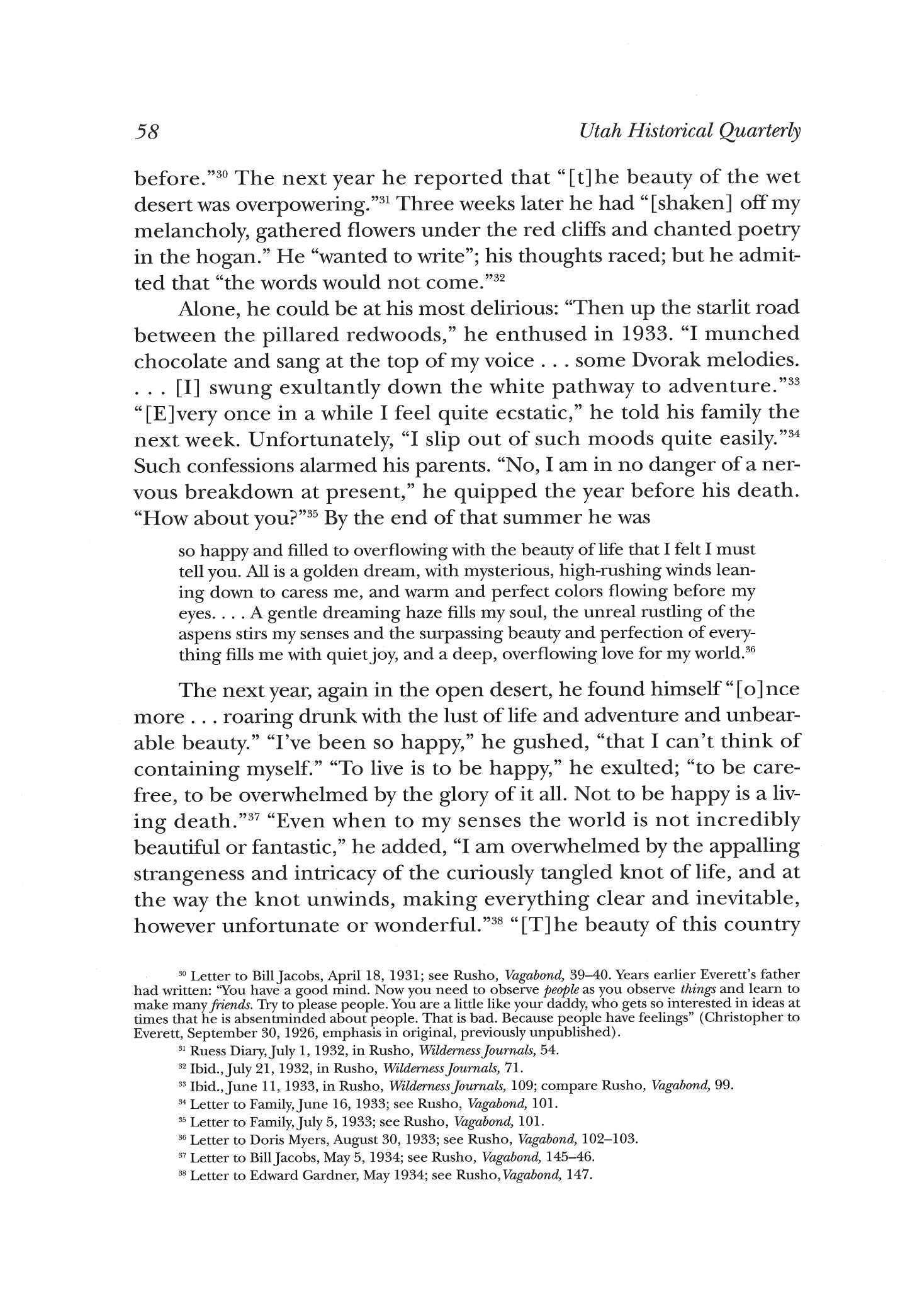
34 Letter to Family, June 16, 1933; see Rusho, Vagabond, 101
35 Letter to Family, July 5, 1933; see Rusho, Vagabond, 101
36 Letter to Doris Myers, August 30, 1933; see Rusho, Vagabond, 102-103
37 Letter to Bill Jacobs, May 5, 1934; see Rusho, Vagabond, 145-46
38 Letter to Edward Gardner, May 1934; see Rusho, Vagabond, 147
58 Utah Historical Quarterly
[is] becoming a part of me," he confessed in lateJune 1934, adding that he felt "detatched [sic] from life and somehow gentler."39
Everett's writings also contain expressions of extreme physical activity, poor judgment, and exaggerated self-confidence, additional features of hypomania.40 "I like adventure and enjoy taking chances when skill and fortitude play a part," he once bragged. "Many times in the search for water holes and cliff dwellings, I trusted my life to crumbling sandstone and angles little short of the perpendicular, startling myself when I came out whole and on top."41 Everett also intensely disliked sleep, which he called "temporary death," and sometimes went seventy hours without sleeping.42
At the same time, Everett manifested the unmistakable signs of depression, including a loss of pleasure and energy, difficulty sleeping, fatigue, lethargic or agitated speech, problems with diet, difficulty concentrating, and repeated thoughts of death and suicide.43 "Somehow I don't feel like writing now, or even talking," he confided in 1931, knowing that he sounded "incoherent and inconsistent," that "thoughts are jangling within me."44 At the onset of an extended trip through Arizona the next year, he worried that the adventure "was foredoomed to failure, that
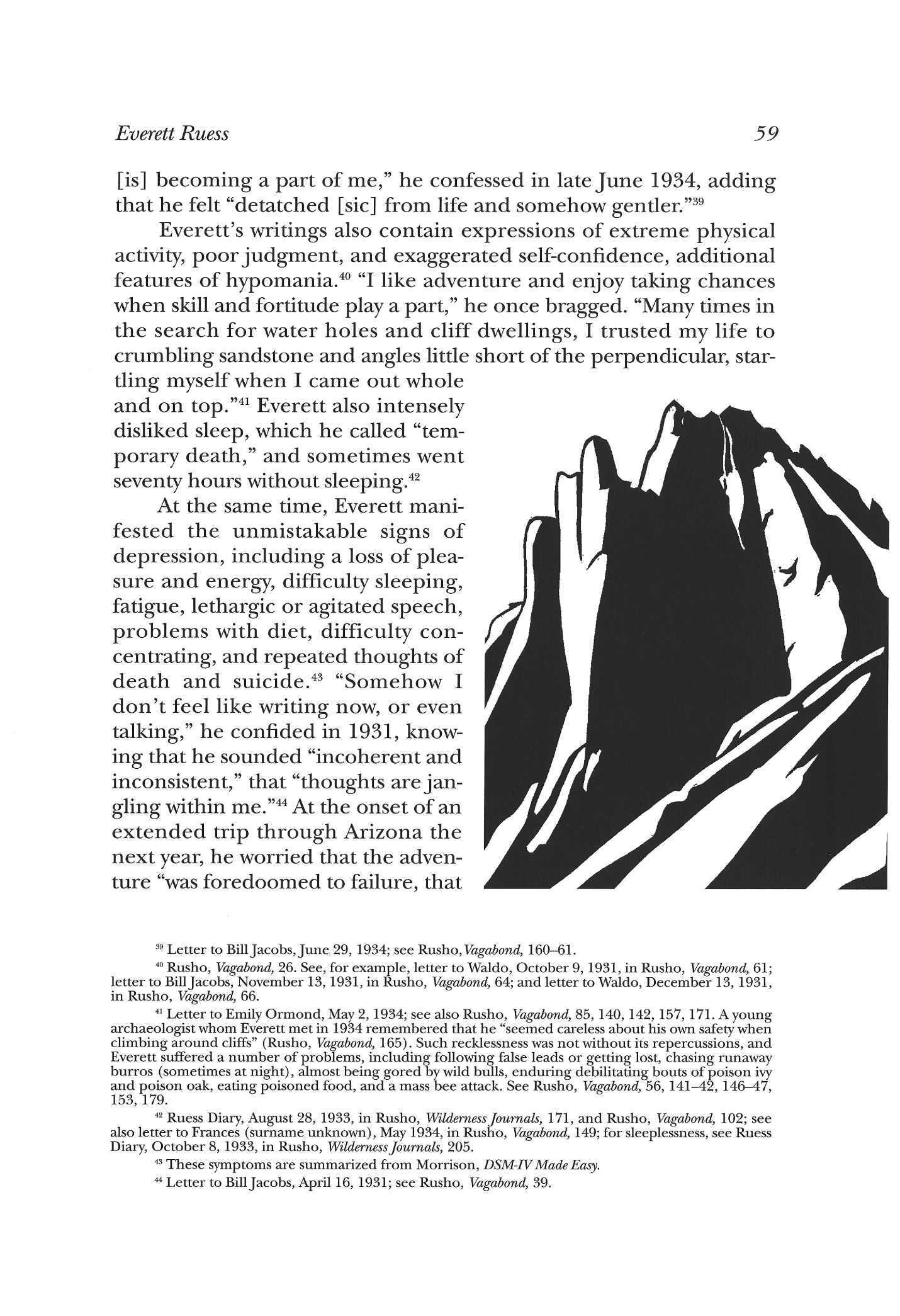
39 Letter to Bill Jacobs, June 29, 1934; see Rusho, Vagabond, 160-61
40 Rusho, Vagabond, 26 See, for example, letter to Waldo, October 9, 1931, in Rusho, Vagabond, 61; letter to Bill Jacobs, November 13, 1931, in Rusho, Vagabond, 64; and letter to Waldo, December 13, 1931, in Rusho, Vagabond, 66.
41 Letter to Emily Ormond, May 2, 1934; see also Rusho, Vagabond, 85, 140, 142, 157, 171 Ayoung archaeologist whom Everett met in 1934 remembered that he "seemed careless about his own safety when climbing around cliffs" (Rusho, Vagabond, 165) Such recklessness was not without its repercussions, and Everett suffered a number of problems, including following false leads or getting lost, chasing runaway burros (sometimes at night), almost being gored by wild bulls, enduring debilitating bouts of poison ivy and poison oak, eating poisoned food, and a mass bee attack See Rusho, Vagabond, 56, 141-42, 146-47, 153, 179
42 Ruess Diary, August 28, 1933, in Rusho, WildernessJournals, 171, and Rusho, Vagabond, 102; see also letter to Frances (surname unknown), May 1934, in Rusho, Vagabond, 149; for sleeplessness, see Ruess Diary, October 8, 1933, in Rusho, WildernessJournals, 205
43 These symptoms are summarized from Morrison, DSM-FVMade Easy.
44 Letter to Bill Jacobs, April 16, 1931; see Rusho, Vagabond, 39
Everett Ruess 59
I'd be overcome with melancholy if I visited the places I've seen before. . . .I've drifted too far away from other people. I want to be different anyhow, I can't help being different, but I get nojoy from it, and all common joys are forbidden me."45 Life on the road "has much more uncertainty than it would have at home," he confessed. "The low spots are fearfully low, but I have learned that they do not last, and a few glorious moments make me forget them completely."46 "I felt futile . . . , " he confided two weeks later. "More and more I feel that I don't belong in the world. I am losing contact with life."47 Such "long thoughts" prevailed over the next several days "I think I have seen too much and known too much," he told himself, "so much that it has put me in a dream from which I cannot waken and be like other people." He thought of a poem by Robinson Jeffers—"Who goes too far to find his grave,/ Mostly alone he goes."48
"I am only too readily led into a melancholy mood," he acknowledged the next year. 49 A week later he recorded thinking that "the value of life is not much. At any given moment, you are only going thru the motions, not living Working blindly at routine, holding pointless conversations, and the like are not living, yet it is such things that make up our existence."50 By the end of that summer he had come to "despise confirmed dudes, tenderfeet, molly coddles, and sloppy campers. There are no words for my feeling.51 Three months later his mood turned even darker: "Often I am tortured to think that what I so deeply feel must always remain, for the most, unshared, uncommunicated. . . . Knowing that the cards are stacked, and realized achievements are mere shadows of the dream, I still try to give some faint but tangible suggestion of what has burned without destroying me." "When events are over," he wrote stoically, "it is often easier to trace the inevitability of their course. Have you not found it so? It is a genius, however, how can find in the past what will serve to plot the future. Most of us must wait until things have happened to see why they happened, and even then, we often do not
45 Ruess Diary, May 31, 1932, in Rusho, WildernessJournals, 35
46 Letter to Waldo, July 12, 1932; see Rusho, Vagabond, 77-78.
47 Ruess Diary, July 18, 1932, in Rusho, WildernessJournals, 67 "Have you never felt futility?" asks a character in a short story Everett wrote "Have you never realized what a purposeless windmill life is?" ("The Bad Habit," no date)
48 Ruess Diary, July 21, 1932, in Rusho, WildernessJournals, 71.
49 Ibid., August 1, 1933, in Rusho, WildernessJournals, 154

50 Letter to Waldo, August 11, 1933, previously unpublished
31 Ruess Diary, August 27, 1933, in Rusho, WildernessJournals, 170
60 Utah Historical Quarterly
"I have been in a very restive, unstable mood, and did not feel like writing," he told his brother in late 1933. "I have been discovering new moods, new lows, new and disturbing variations in myself and my feelings for individuals, and people as a whole. . . . [F]or the most part there has been an undercurrent of resentment or unrest. ... I have not been able to loosen up for some while." He lamented not finding "any proper outlet for my feelings Perhaps there is none and perhaps it is necessary for my feelings to die of weariness and refusal." "I don't expect you to understand them [my emotions] any more than anyone else," he despaired, "nor would it matter much if you did, because it seems to be up to me." He knew his "straying from normalcy" was disturbing but hoped it was simply "part of a somewhat symmetrical scheme which I seem to see dimly."53 Six months later his outlook had not improved: "I fear, or rather, the rest of the world should fear, that I am becoming quite antisocial I have no desire to bend my efforts toward entertaining the bored and blase world." "I hope this gets you down," he complained, "for I feel like puncturing the stupid satisfaction and silly aspirations of the world this morning."54
Like these indications of depression, explicit references to his own death also began emerging by 1931. "[B]efore physical deterioration obtrudes," he told his brother that year, "I shall go on some last wilderness trip, to a place I have known and loved. I shall not return."55 "[W]hen the time comes to die," he repeated in 1932, "I'll find the wildest, loneliest, most desolate spot there is."56 "I set less and less value on human life, as I learn more about it," he confessed the next year. "Life does not grip me very powerfully in the present. ... I

52 Letter to Waldo, November 29, 1933, in 'Youth is for Adventure." The dating of this letter is problematic; earlier portions are reprinted in Rusho, Vagabondfor Beauty, 151, who says that the addressee is unknown and dates it to May 1934
53 Letter to Waldo, December 22, 1933, in Rusho, Vagabond, 126-27
54 Letter to Bill Jacobs, June 17, 1934, in Rusho, Vagabond, 152-53
55 Letter to Waldo, May 2, 1931, in Rusho, Vagabond, 42-44 During this period Everett toyed with reinventing himself and signed this letter "Evert Rulan." "It is not as euphonious or unusual as Lan Rameau, but to those who knew me formerly, the name seemed an affectation. Evert Rulan can be spelled, pronounced, and remembered, and is fairly distinctive." Evert was a contraction of Everett; "Rulan" was probably a play on "Ruess," mispronounced "Roo-ass" (a nod to adolescent teasing), and then Frenchified to "Ru-lan," I'dne meaning ass or burro in French "Lan Rameau," an earlier nom de plume, meant Rameau the ass ("As to the burro," he wrote, "I call him Everett, to remind me of the kind of person I used to be" [see Rusho, Vagabond, 37; see also 219 n4, 25, 29, and 30].) "Rameau" may have come from the LeNeveu de Rameau" (Rameau's Nephew), a satire of eighteenth-century French manners by Enlightenment philosophe Denis Diderot In it, Rameau's nephew, also called Rameau, is described as one who "shakes things up, he creates a stir; he makes people approve or disapprove; he brings out the truth; he makes you see who the decent people are; he unmasks the rogues. It is at such times that the man of good sense keeps his ears open and makes a note of who is who." Later, however, he is called "a loafer, a glutton, a coward, and rotten through and through." See Lester G Crocker, ed., Derek Coltman, trans., Diderot'sSelected Writings (New York: Macmillan Co., 1966), 113-46 Everett's father did not care for his son's various noms deplume and was glad when Everett eventually abandoned them.
56 Letter to Waldo, July 12, 1932, in Rusho, Vagabond, 77-78
Everett Ruess 61
don't like to take a negative attitude, but it seems thrust upon me." "My interest in life is waning," he wrote the next week. "What's the use?" he lamented by the end of the month. "All perishes—why struggle?"57 In fact, Everett soon began to think of death as the artist's true destiny: "[H]e who has looked long on naked beauty may never return to the world. . . . Alone and lost, he must die on the altar of beauty." "[S]ometimes, if his will is powerful, [the "highly sensitive person"] can pretend to himself that he does not know what he knows,"
Everett wrote just six months before his death, "and can act a part as one of the rest. But the pretense cannot endure, and unless he can find another as highly strung as himself with whom to share the murderous pain of living, he will surely go insane."58 He admitted:
Mine seems a task essentially futile. Try as I may, I have never yet, that I know of, succeeded in conveying more than a glimpse of my visions
I am torn by the knowledge that what I have felt cannot be given to another. I cannot bear to contain these rending flames, and I am helpless to let them out So I wonder how I can go on living and being casual as one must.59
Contributing to such anguish was Everett's inability to form lasting friendships. In 1931,a year
57 Ruess Diary, September 6, 15, 29, 1933, in Rusho, WildernessJournals, 179, 184, 200
58 Portion of an untitled essay, quoted in a letter to Edward Gardner, May 1934, in Rusho, Vagabond, 148
59 Letter to "addressee unknown," May 1934, in Rusho, Vagabond, 151 According to "Youth Is for Adventure," however, portions of this letter were sent to Waldo from San Francisco and are dated November 29, 1933

62 Utah Historical Quarterly
out of high school, he complained of not having "a loyal friend to share my delights and miseries."60 He called himself "freakish" because he could not find "people who cared about the things I've cared for."61 "I can't find my ideal anywhere," he lamented the next year. "So I am rather afraid of myself."62 Yet he could be uncompromising of what few acquaintances he did have: "They have been wallowing in the shallows of life this past year," he complained in early 1934, "not growing or having new and enlarging experiences; driven partly or wholly by circumstances into lives that they themselves consider ignoble, stale, and depressing."63 He concluded that true friendship was impossible. "I do not greatly mind endings, for my life is made up of them," he wrote four months later, "but sometimes they come too soon or too late, and sometimes they leave a feeling of regret as of an old mistake or an indirect futility." "[F]or the deepest understanding," he thought, "one must seek those with whom one can be most truly one's self."Yet for Everett, this meant not human intimacy but experiencing "the nearly unbearable beauty of what I see."64
Compounding Everett's psychological battles were health problems. "Physically I feel weak," he wrote in 1932. "I would not be surprised to hear that pernicious anemia had hit again."65 Prior to the 1940s, most cases of anemia were usually grouped in one category. Today they are separated and classified according to the body's failure to absorb vitamin B-12 (also called pernicious anemia), iron, or folic acid. In each case, however, the symptoms are similar: weakness and fatigue, dizziness, and pale skin (including gums, eyes, and nailbeds) as well as, less often, palpitations, shortness of breath, red tongue, loss of appetite, abdominal problems, and depression. Iron deficiency
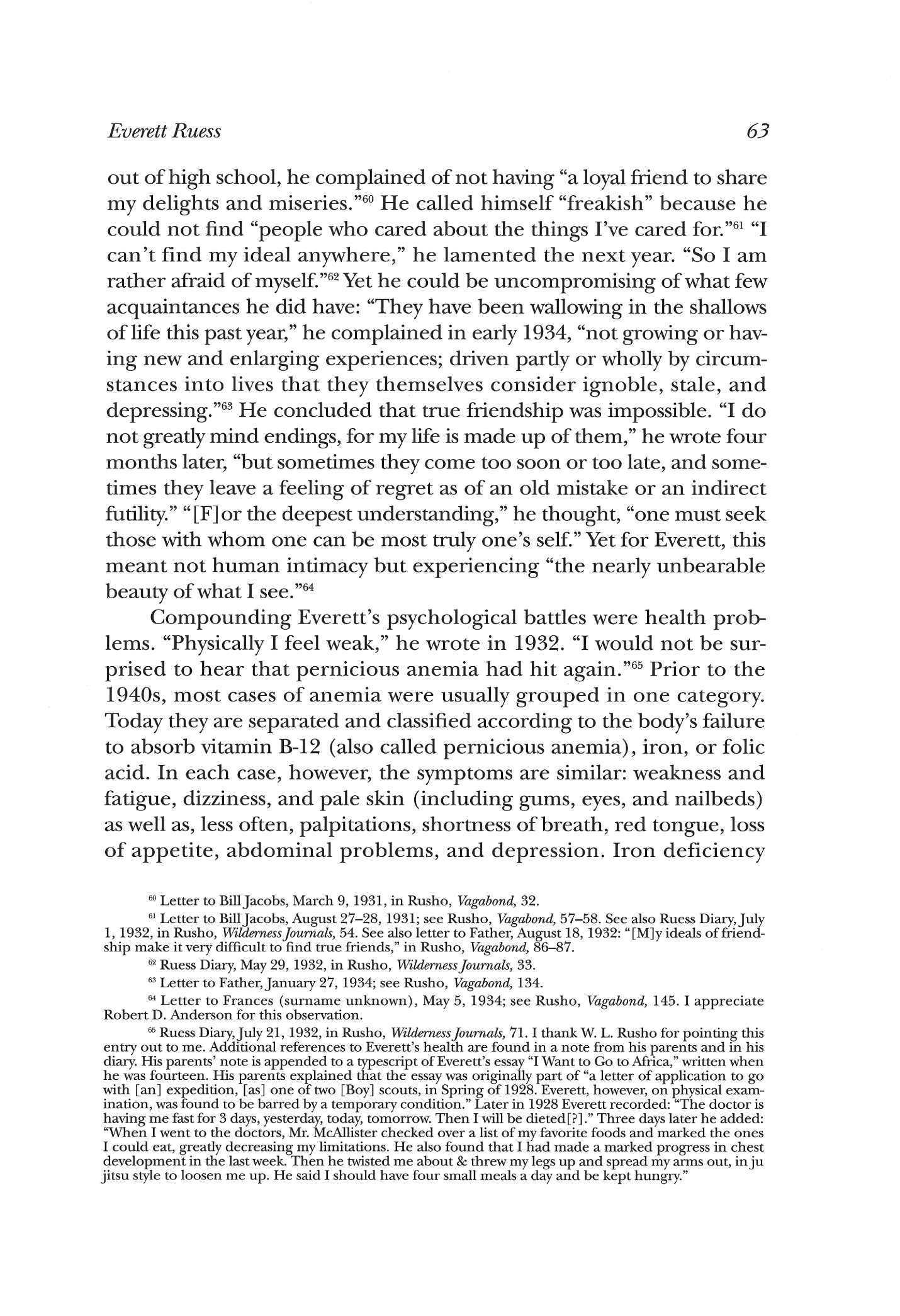
60 Letter to Bill Jacobs, March 9, 1931, in Rusho, Vagabond, 32
61 Letter to Bill Jacobs, August 27-28, 1931; see Rusho, Vagabond, 57-58. See also Ruess Diary, July 1, 1932, in Rusho, WildernessJournals, 54 See also letter to Father, August 18, 1932: "[M]y ideals of friendship make it very difficult to find true friends," in Rusho, Vagabond, 86-87
62 Ruess Diary, May 29, 1932, in Rusho, WildernessJournals, 33
63 Letter to Father, January 27, 1934; see Rusho, Vagabond, 134
64 Letter to Frances (surname unknown), May 5, 1934; see Rusho, Vagabond, 145 I appreciate Robert D Anderson for this observation
65 Ruess Diary, July 21, 1932, in Rusho, WildernessJournals, 71.1 thank W L Rusho for pointing this entry out to me Additional references to Everett's health are found in a note from his parents and in his diary His parents' note is appended to a typescript of Everett's essay "I Want to Go to Africa," written when he was fourteen. His parents explained that the essay was originally part of "a letter of application to go with [an] expedition, [as] one of two [Boy] scouts, in Spring of 1928 Everett, however, on physical examination, was found to be barred by a temporary condition." Later in 1928 Everett recorded: "The doctor is having me fast for 3 days, yesterday, today, tomorrow Then I will be dieted[?]." Three days later he added: "When I went to the doctors, Mr McAllister checked over a list of my favorite foods and marked the ones I could eat, greatly decreasing my limitations He also found that I had made a marked progress in chest development in the last week Then he twisted me about & threw my legs up and spread my arms out, in j u jitsu style to loosen me up He said I should have four small meals a day and be kept hungry."
Everett Ruess 63
anemia may be more common among young men than previously believed. More common still among adolescents is folic acid deficiency, usually the result of a diet lacking raw leafy vegetables. In fact, "anemia due to folic acid deficiency looksjust like pernicious anemia . . . [and] careful diagnostic tests must be performed to distinguish between the two." Still, it is important to remember that "most fatigue is not related to tired blood; most anemia comes on without any noticeable symptoms at all "66
Of Everett's sexual orientation, Mark A. Taylor was the first to wonder if his traveling alone was an attempt "to understand his own sexuality." But Everett's sexuality is difficult to assess. On the one hand, he was clearly interested in a woman from San Francisco with whom he "was intimate" and shared "some moments of beauty." He also referred in his writings to "a very interesting Polish girl," another woman who was "quite attractive to me," a third "who was very interesting to me," and a "Mormon girl" he would have "fallen in love with" had he stayed in town "any longer." He captioned a photograph of a Navajo woman, baby, and himself, "My Navajo Wife."67
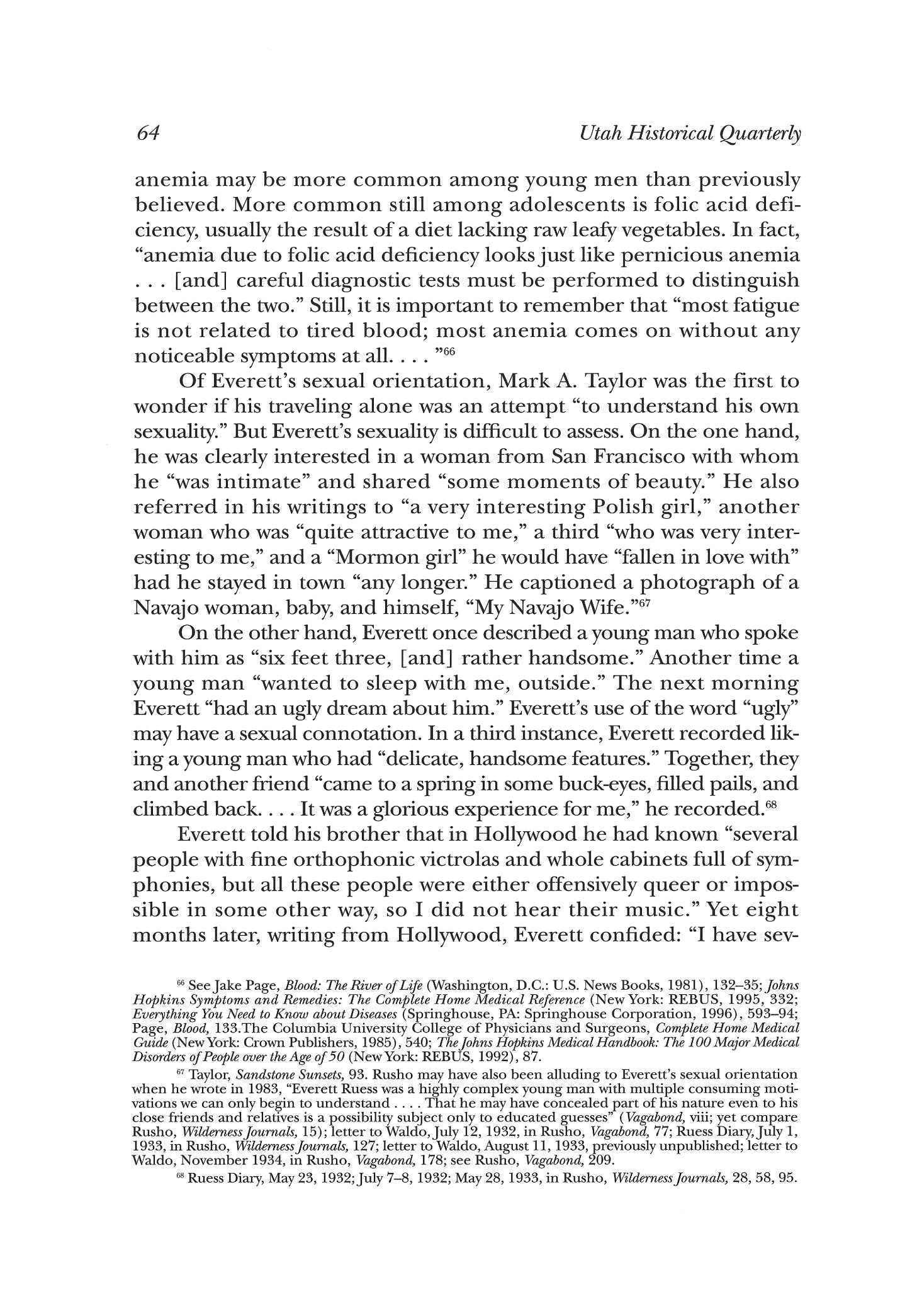
On the other hand, Everett once described a young man who spoke with him as "six feet three, [and] rather handsome." Another time a young man "wanted to sleep with me, outside." The next morning Everett "had an ugly dream about him." Everett's use of the word "ugly" may have a sexual connotation. In a third instance, Everett recorded liking a young man who had "delicate, handsome features." Together, they and another friend "came to a spring in some buck-eyes, filled pails, and climbed back. ... It was a glorious experience for me," he recorded.68
Everett told his brother that in Hollywood he had known "several people with fine orthophonic victrolas and whole cabinets full of symphonies, but all these people were either offensively queer or impossible in some other way, so I did not hear their music." Yet eight months later, writing from Hollywood, Everett confided: "I have sev-
66 See Jake Page, Blood: The River ofLife (Washington, D.C.: U.S News Books, 1981), 132-35; Johns Hopkins Symptoms and Remedies: The Complete Home Medical Reference (New York: REBUS, 1995, 332; Everything You Need to Know about Diseases (Springhouse, PA: Springhouse Corporation, 1996), 593-94; Page, Blood, 133.The Columbia University College of Physicians and Surgeons, Complete Home Medical Guide (New York: Crown Publishers, 1985), 540; TheJohns Hopkins Medical Handbook: The 100 Major Medical Disorders ofPeople overthe Age of 50 (New York: REBUS, 1992), 87
67 Taylor, Sandstone Sunsets, 93 Rusho may have also been alluding to Everett's sexual orientation when he wrote in 1983, "Everett Ruess was a highly complex young man with multiple consuming motivations we can only begin to understand That he may have concealed part of his nature even to his close friends and relatives is a possibility subject only to educated guesses" (Vagabond, viii; yet compare Rusho, WildernessJournals, 15); letter to Waldo, July 12, 1932, in Rusho, Vagabond, 77; Ruess Diary, July 1, 1933, in Rusho, WildernessJournals, 127; letter to Waldo, August 11, 1933, previously unpublished; letter to Waldo, November 1934, in Rusho, Vagabond, 178; see Rusho, Vagabond, 209.
68 Ruess Diary, May 23, 1932; July 7-8, 1932; May 28, 1933, in Rusho, WildernessJournals, 28, 58, 95.
64 Utah Historical Quarterly
eral friends with fine victrolas and recorded music, and I have some myself and can borrow more."69 In another letter he hinted at "strange comradeships and intimacies," and may have been referring to a sexual encounter when he wrote in mid-1934: "True, I have had many experiences with people, and some very close ones, but there was too much that could not be spoken. I had a strange experience with a young fellow at an outpost, a boy I'd known before. It seems that only in moments of desperation is the soul most truly revealed. Perhaps that's why I am so often so unrestrained, for always I sense the brink of things." Everett doubted he would ever find "a great and soul filling love," which "is such a rarity as to be almost negligible." And when talking about his ideal companion, he did so without reference to gender: "I wish I had a companion, some one who was interested in me. I would like to be influenced, taken in hand by some one, but I don't think there is anyone in the world who knows enough to be able to advise me I can't find my ideal anywhere So I am rather afraid of myself."70
Taken together, these cycling bouts of depression and hypomania, exacerbated by possible health problems and questions about his sexuality, may have formed the "somewhat symmetrical scheme" which Everett in late 1933 "seem[ed] to see dimly."71 That he sensed the problems he faced, and their likely resolution, is suggested in an eerily prophetic short story he completed two years before his death.72 As the story opens, an artist is "sprawled on the stinging hot sand beneath a twisted Joshua tree in the desert." He had come there to "die—or to
eg "Offensively" is mistranscribed as "effeminately" in Rusho, Vagabond, 77 Everett's use of "queer" may mean homosexual, although this is not certain Letter to Waldo, July 12, 1932, in Rusho, Vagabond, 77; letter to Fritz Loeffler, March 23, 1933, in Rusho, Vagabond, 95 Mark Taylor pointed out this intriguing exchange; see Sandstone Sunsets, 93-94

70 Letter to Frances (surname unknown), May 5, 1934, in Rusho, Vagabond, 145; letter to Frances (surname unknown), May 1934, in Rusho, Vagabond, 150; Ruess Diary, October 7, 1933, May 29, 1932, in Rusho, WildernessJournals, 204, 33 One of the last young men Everett spoke with before leaving Escalante remembered that he "never talked about any girlfriends, whether Navajo or otherwise" (in Rusho, Vagabond, 208) Everett's concluding word in the last cited diary excerpt—"Obscurantism"—may be more revealing than he realized
71 Letter to Waldo, December 22, 1933; see Rusho, Vagabond, 127
72 "Vultures," circa 1932-33, previously unpublished
Everett Ruess 65
recover his lost ambitions." Despite the beauty around him, his "soul was dead." With the approach of dawn, "he threw himself down in a little gulch beneath an overhanging ledge." "I'm a fool," he said, "but after all, what is the use of anything?" Soon, however, his physical discomfort became "greater than his spiritual misery,"73 and the "desire to live was suddenly reawakened." He turned and began to run back, but "each step became a hammer blow at his heart." With his "last ebbing strength," he crawled "atop a lonely butte." Rain burst from the sky, and "[t]he dull misery that had been the artist's was washed away like the sand that poured down from the rocks, leaving them clean, and bare to the open sky."As his strength "waned, somehow, his happiness grew greater He knew he could not get back, but he was content."74 Vultures began circling, and "[a]11 that was left of his anguish now passed, and a light shone in his eyes, as he.saw the dying sun flood the waste lands with splendor." The last thing he sawwas the "burnished bronze of the vulture's wings, glinting in the sunlight, as it snatched his eyes out. He did not feel the pain. A moment later, the bloodhued sunset passed swiftly to night."75
We live unsettled lives
And stay in a place
Only long enough to find We don't belong —Mark Strand
When "the murderous pain of living" finally became too much, and the end arrived, perhaps it happened this way: Everett led his two burros to the campsite in Davis Gulch. From there he explored nearby side canyons, cliffs, and
73 The typescript has "mental anguish" here
74 These last two sentences are not in the typescript prepared by his parents
75 In another of Everett's unpublished stories, the main character is struck by a car and lies in a hospital bed, expecting to die A friend pleads with him to live, but he answers, "What for?" turns away, and "weigh[s] certain thoughts in his mind." A week later, however, he has recovered and decided to live "After all," he admits, "some bad habits are pleasant." ("The Bad Habit," no date.)
In yet a third unpublished story, "a solitary traveler" struggles through a storm to deliver an unspecified message He sees a light in the distance But "after a vain attempt to rise, he succumbed to his fate, and now he sleeps the eternal sleep of death." The next morning the inhabitants of the house he glimpsed find his body, "which testifie[s] to the triumph of Nature over Man But the message he carried was never delivered." ("The Message," no date.)
A final conundru m relates to Everett's diaries for 1932 and 1933, now published in Rusho, WildernessJournals. Approximately 2.5 percent of these diaries (almost 6,200 words) were at some point erased or otherwise rendered illegible One is left to wonder what his parents, or perhaps Everett himself, may have found so troubling

66 Utah Historical Quarterly
V
buttes, until he found a wild, lonely spot that reminded him of a place he had been before. Returning to Davis Gulch, he loaded his outfit onto one of the burros and led him back to this spot After unloading his pack, he walked the burro back to Davis Gulch, where he made sure both animals were protected and had enough food for the winter. He then hiked back to his last camp.
Two years earlier Everett had hidden an old saddle high "in a prehistoric corn bin beside a cliffdweller's cradle ... to be guarded by the spirits of the ancient dead." "I don't think anyone will ever find the saddle," he wrote. "The rain washed away my tracks. The saddle is well cached. The ghosts of the cliff dwellers will guard it."76 With this same thought in mind, Everett now gathered up his gear, all the beauty he had carried with him, and secured it in a recess he knew no one would ever find.77 Slowly with the setting sun, the misery and anguish of the past four years began to wash away and Everett felt life loosen its grip. From this altar of beauty, he gazed one last time across the horizon. Content that he had kept his dream, Everett knew he was now going to make his destiny.
For Everett Ruess at the end, there was only one word that he believed best summed up his brief life, one word that today tantalizes as it repels: nemo, no one. Like Odysseus, he found himself a prisoner in a foreign land facing a monster that threatened to devour him. Like Captain Nemo, he had fled the soul-deadening horrors of civilization only to discover that life offered him no choice but to become the thing he despised. Alone in his ravishing desert where "no one [nemo] lives," enveloped by transcendent beauty and the inescapable realization that he would never rise above the limits of his own flawed humanity, he believed he could do nothing else but become no one. For each new generation that confronts the same murderous pain of living, perhaps there is only one final word, as well: Everett.
The older person does not realize the soul-flights of the adolescent I think we all poorly understood Everett
—Christopher Ruess
76 "Portion of an essay" and Ruess Diary, July 1932, in Rusho, WildernessJournals, 72-73, and in Rusho, Vagabond, 82-83
77 As he was leaving Escalante, Everett mailed home a batch of watercolors to "lighten the load," as well as ten dollars He had never before mailed money to his parents, but did so now because he "ha[d] more money than I need." "I want both of you to spend five for something you have been wishing to have—books, or a trip, but not anything connected with any kind of a duty," he wrote "Let this be the first installment on that nickel I promised you when I made my first million" (letter to Father and Mother, November 11, 1934, in Rusho, Vagabond, 176-77)
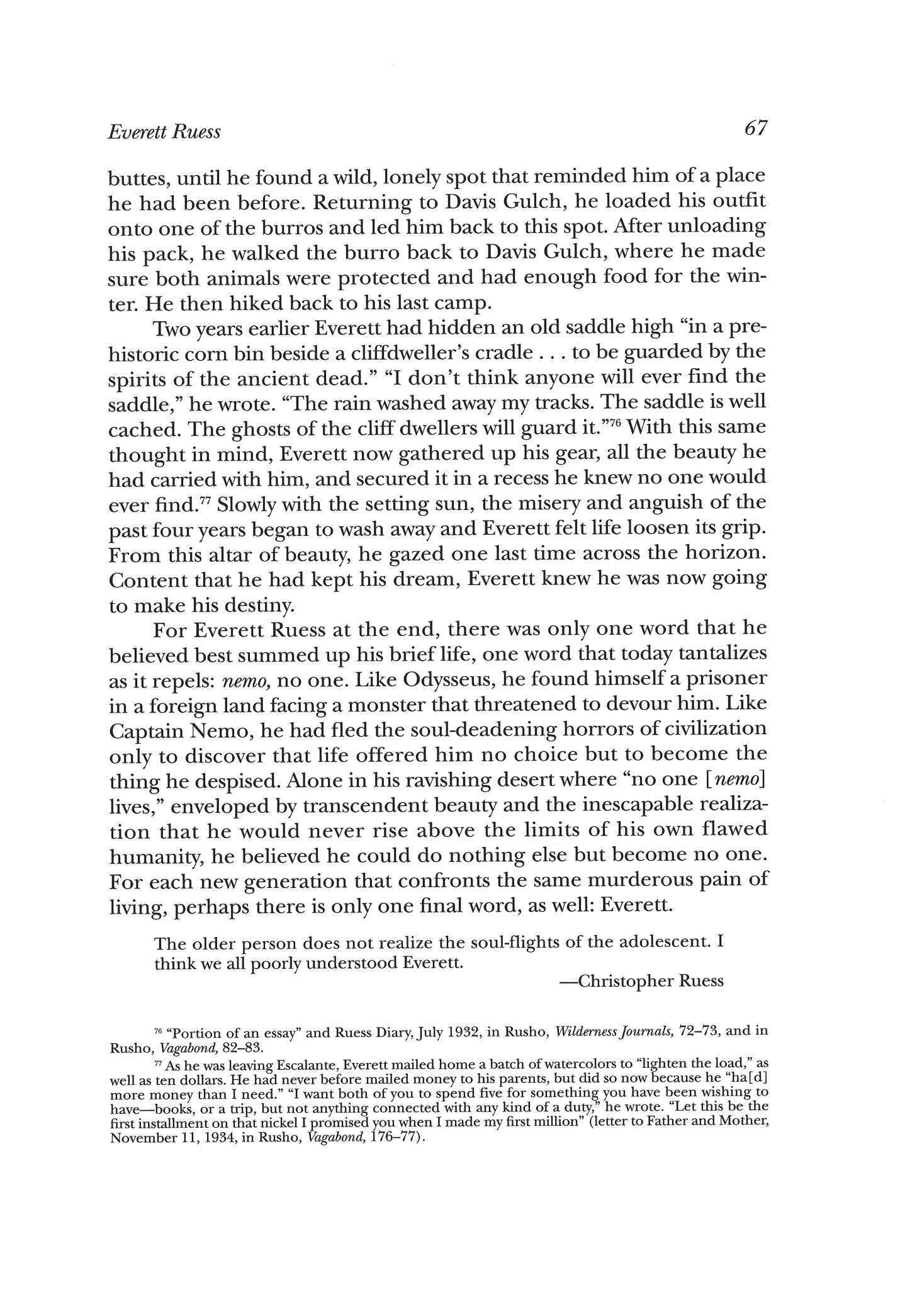
Everett Ruess 67
Much Ado About Nothing: m Juan River Gold Rush, 1892-93
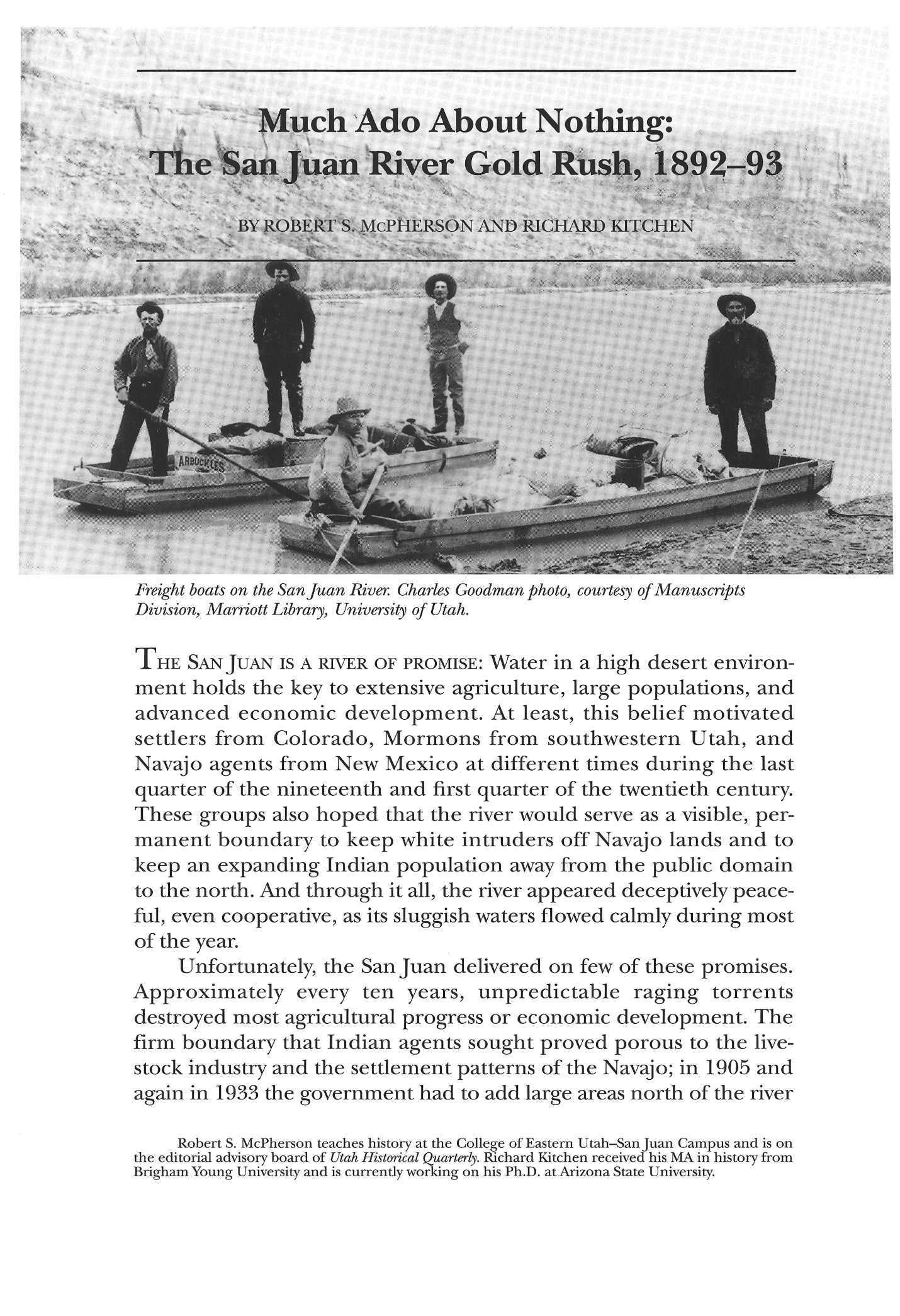
TH E SAN JUAN IS A RIVER OF PROMISE: Water in a high desert environment holds the key to extensive agriculture, large populations, and advanced economic development. At least, this belief motivated settlers from Colorado, Mormons from southwestern Utah, and Navajo agents from New Mexico at different times during the last quarter of the nineteenth and first quarter of the twentieth century. These groups also hoped that the river would serve as a visible, permanent boundary to keep white intruders off Navajo lands and to keep an expanding Indian population away from the public domain to the north. And through it all, the river appeared deceptively peaceful, even cooperative, as its sluggish waters flowed calmly during most of the year.
Unfortunately, the SanJuan delivered on few of these promises. Approximately every ten years, unpredictable raging torrents destroyed most agricultural progress or economic development. The firm boundary that Indian agents sought proved porous to the livestock industry and the settlement patterns of the Navajo; in 1905 and again in 1933 the government had to add large areas north of the river
RY
)N AND RICHARD KITCHEN
Freight boats on the SanJuan River. Charles Goodman photo, courtesy of Manuscripts Division, Marriott Library, University of Utah.
Robert S McPherson teaches history at the College of Eastern Utah-San Juan Campus and is on the editorial advisory board of Utah Historical Quarterly. Richard Kitchen received his MA in history from Brigham Young University and is currently working on his Ph.D at Arizona State University
to the reservation As for large populations, many families came and went, but relatively few remained for long or concentrated in one place. The waters of hope dried quickly in the hot desert air of the Colorado Plateau.
No better example of hope leading to disillusionment, and of boom followed by bust, exists in this riverine corridor than the gold rush of 1892-93, which rivaled similar explosions in other parts of the West. Even this rush, in the calm of turn-of-the-century southeastern Utah, had its precursors and aftermath. From the early 1880s through approximately 1920, gold miners searched with various degrees of intensity for precious minerals along the San Juan River drainage. Gold had always been present there, but it was not often found in a coarse enough state to mine profitably. Rather, it was an extremely fine dust found in alluvial deposits mixed with sand and debris deposited by the river. While this flour gold could be found on the sand bars along the river, most nuggets, if any, were located on the ancient lateral gravel terraces that lay sometimes over 200 feet above the high water level.1
Still, despite the difficulties in procuring it,just the mere presence of gold evoked dreams of riches to be plucked. The height of these dreams occurred along the San Juan in the rush of 1892-93, which, to borrow a title from one of William Shakespeare's plays, proved to be much ado about nothing However, that there was "much ado" at the time is without doubt Rumors were rampant Enticing newspaper headlines and railroad advertising from the Four Corners area fanned the flames of the gold rush through deception, hearsay, and blind competition. Little was ever gained.
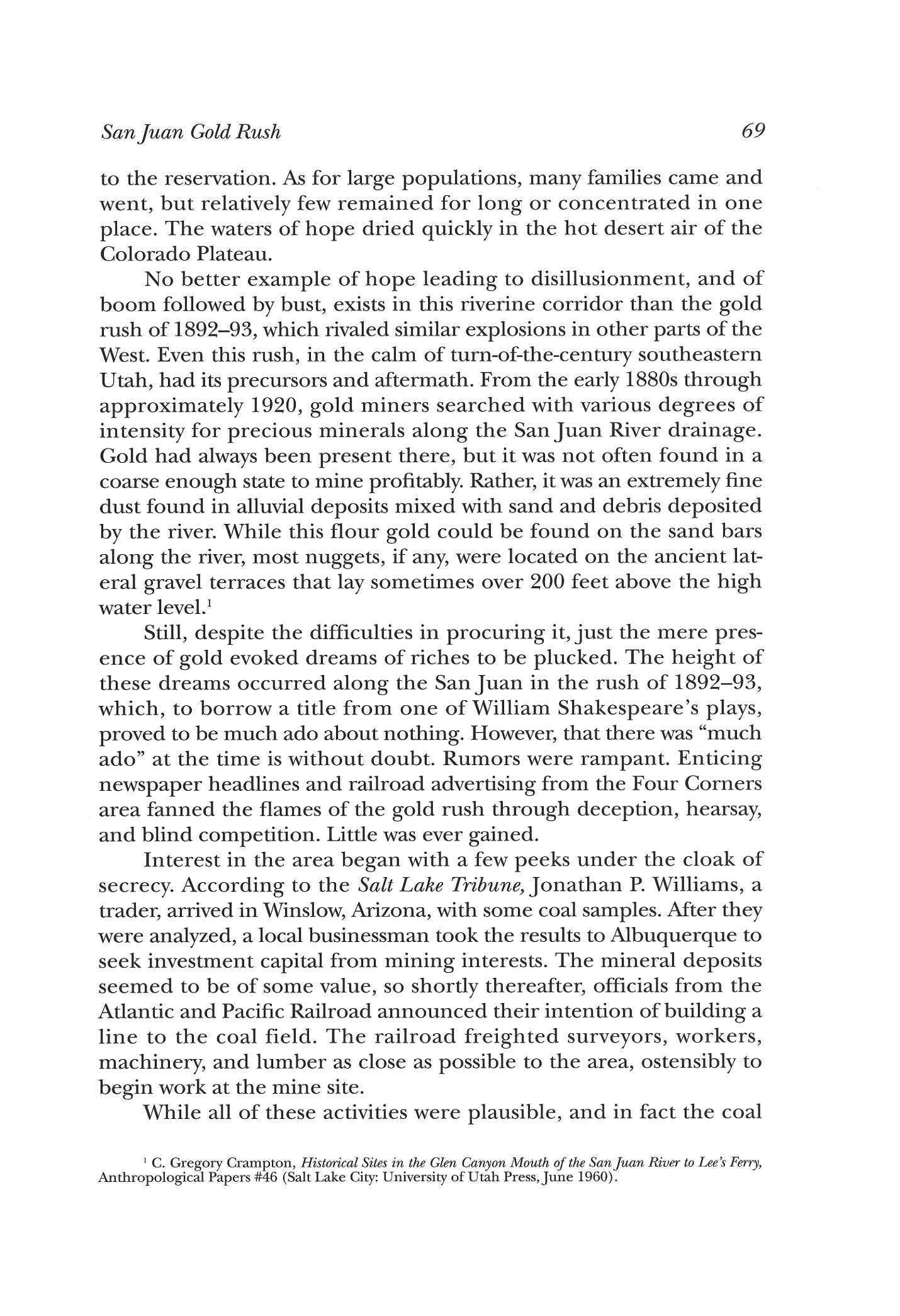
Interest in the area began with a few peeks under the cloak of secrecy. According to the Salt Lake Tribune, Jonathan P. Williams, a trader, arrived in Winslow, Arizona, with some coal samples. After they were analyzed, a local businessman took the results to Albuquerque to seek investment capital from mining interests. The mineral deposits seemed to be of some value, so shortly thereafter, officials from the Atlantic and Pacific Railroad announced their intention of building a line to the coal field The railroad freighted surveyors, workers, machinery, and lumber as close as possible to the area, ostensibly to begin work at the mine site.
While all of these activities were plausible, and in fact the coal
San Juan Gold Rush 69
1 C Gregory Crampton, Historical Sites in the Glen Canyon Mouth of the San Juan River to Lee's Ferry, Anthropological Papers #46 (Salt Lake City: University of Utah Press, June 1960)
samples had been seen, apparently an old prospector by the name of French had some doubts as to what was actually taking place The amount of equipment, the secrecy of the group, and the fact that the machinery was sent at night aroused his curiosity. Taking two men into his confidence, French followed the next shipment out; the party he followed stopped at a coal mine, spent the night there, then moved on to the SanJuan River.
As French suspected, something else was going on. The coal mining equipment turned out to be hydraulic machinery for gold mining Williams had found gold as well as coal, so he and his associates decided to use the coal as a cover for gold production. The group had sworn their workers to silence. Karl Snyder, an Albuquerque lawyer and member of the coterie, took a circuitous route to the San Juan county courthouse, where, under some pretext, he was made deputy county recorder. This allowed the group to legalize their claim on sites in total secrecy
But French had uncovered the plan When they learned of his presence, the businessmen offered him and his friends $5000 if they would stay for ten days until the recording work had been completed. One of French's group considered the glitter of gold more inviting than greenbacks, however, and he returned to Winslow. The secret was out.2
This initial report of gold was the first of many that encouraged interstate rivalry, a get-there-first attitude, and many a miner's dream While the diggings were in Utah, primarily between Bluff and the confluence of the San Juan with the Colorado River, the first reports emphasized that miners from Arizona were getting all the benefits of this gold. Imagine the feelings of the people in Salt Lake City when they read a Flagstaff, Arizona, dispatch reprinted in the Deseret News announcing that there was "great excitement" along the Atlantic and Pacific Railroad line because of the rich finds on the San Juan "Five hundred citizens from Flagstaff, Williams, and Winslow have left for the new El Dorado. The placers extend for fifty miles from the mouth of the San Juan and 200 locations have been made. The new gold fields are reported as being the richest ever found."3
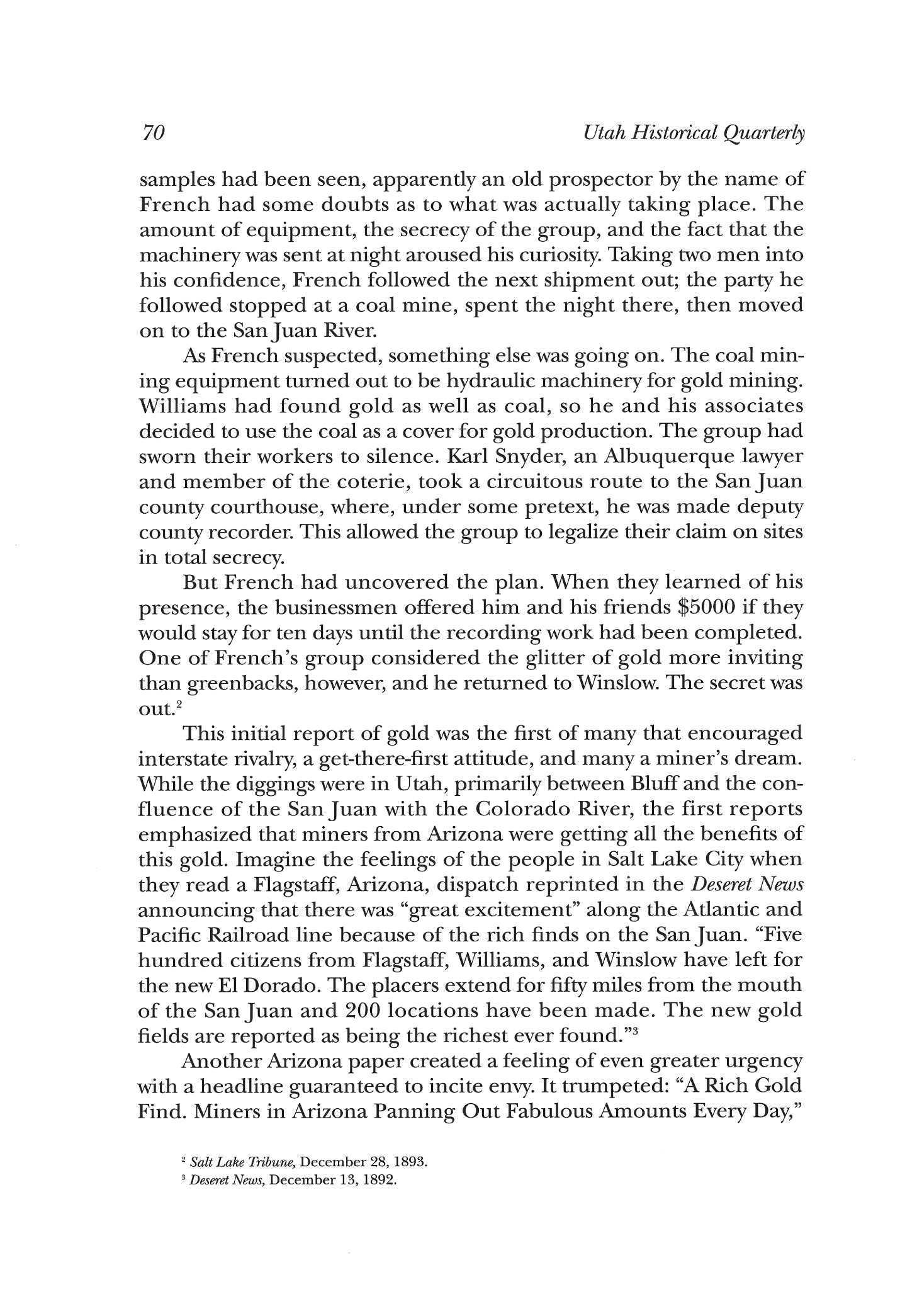
Another Arizona paper created a feeling of even greater urgency with a headline guaranteed to incite envy It trumpeted: "A Rich Gold Find Miners in Arizona Panning Out Fabulous Amounts Every Day,"
2 Salt Lake Tribune, December 28, 1893
3 Deseret News, December 13, 1892
70 Utah Historical Quarterly
O. A. Smith and his rocker. A rocker, a cradle usedfor panning, allowed the gold to settle out and be retrieved. Charles Goodman photo, '-
and then reported that "excitement is at fever heat over a gold find" along the San Juan. "Trainmen and telegraph operators are deserting the railroad, crippling it. Even officials of the Atlantic and Pacific have caught the infection. . . . Business is seriously interfered with. Friday one man washed out $700 and another reported $2,000 as a result of thirty-six hours' work."4
Additional communications began giving the exact number of outfits leaving for the goldfield each day, suggesting that there were no more animals for teams available in the area. Railroad workers supposedly commandeered horses being shipped to miners in Winslow Estimates claimed that between 500 and 1,000 men from Arizona were already on their way. 5 This tide of interest swept to the north, swirling against the red rocks and snaking into the canyons of the San Juan. While no one will ever know the exact number of miners in the canyons at this time, the gold rush appears to have peaked in the latter half of December through the mid-part of January.
Within a week the news spread to surrounding states. A press release from Denver reprinted in the Salt Lake Tribune indirectly urged Utahns to awaken to the possibilities lying on their doorstep. The Denver paper reported that "in every [mining] camp" in the Four Corners region people talked only about the finds in southern Utah. Consequently, "many outfits have already started for the new fields,

': - -
. courtesy ofManuscripts Division, Marriott Library, University of Utah.
- .'.'>•-;S J * ; ' " \ •••"• ."'•'_ - : ~ O.A^tn'&
lV 4 » •: : I-;:!: H " ^^- i j o t\, ; UtaJti f teTaBm Salt Lake Tribune, December 13, 1892 Salt Lake Herald, December 16, 1892
W fc\.< R.cXet,- ^3»
and by Saturday it is estimated that three hundred miners will have left . . . for the New El Dorado." As in Arizona, workers and officials on the railroad in New Mexico "have thrown up their positions and headed a great army of gold hunters" to the profitable fields.6 To some people in Denver, even Christmas was forgotten as the city filled with hopeful gold seekers and "all west-bound trains were loaded with eager prospectors."7
By late December, Utah had also caught the gold fever Perhaps one reason for the slow start was the vast distances between any real urban area in Utah and the San Juan country. More likely is the fact that Utah's predominantly Mormon population had a deeper set of roots wrapped around family; the LDS church had historically counseled its members not to become involved in get-rich-quick schemes and the rough, migrant lifestyle of mining communities. Towns in the surrounding states did not have this attitude and so perpetuated an ongoing love affair with mineral exploration that adapted easily to new rumors and possible finds.
Other attitudes encouraged the gold fever and found voice in newspapers, boosting circulation by appealing to raw-boned courage as much as to the get-rich-quick-interest of the times Thinly disguised was a growing mystique of the area that challenged the manhood of those attempting to go to San Juan. There were "terrible stories" told of "weird wonders, such as the abodes of the cliff dwellers and the massacre of a half dozen miners by the savage and bloodthirsty Navajos . . and the many strange murders that haunt the memory of this grand canyoned stream . . . whose perpendicular walls defy the exploration of the most daring. This fabled country has a terror that almost freezes the imagination even of a person smitten with the gold fever ."8 Hyperbole was the order of the day.
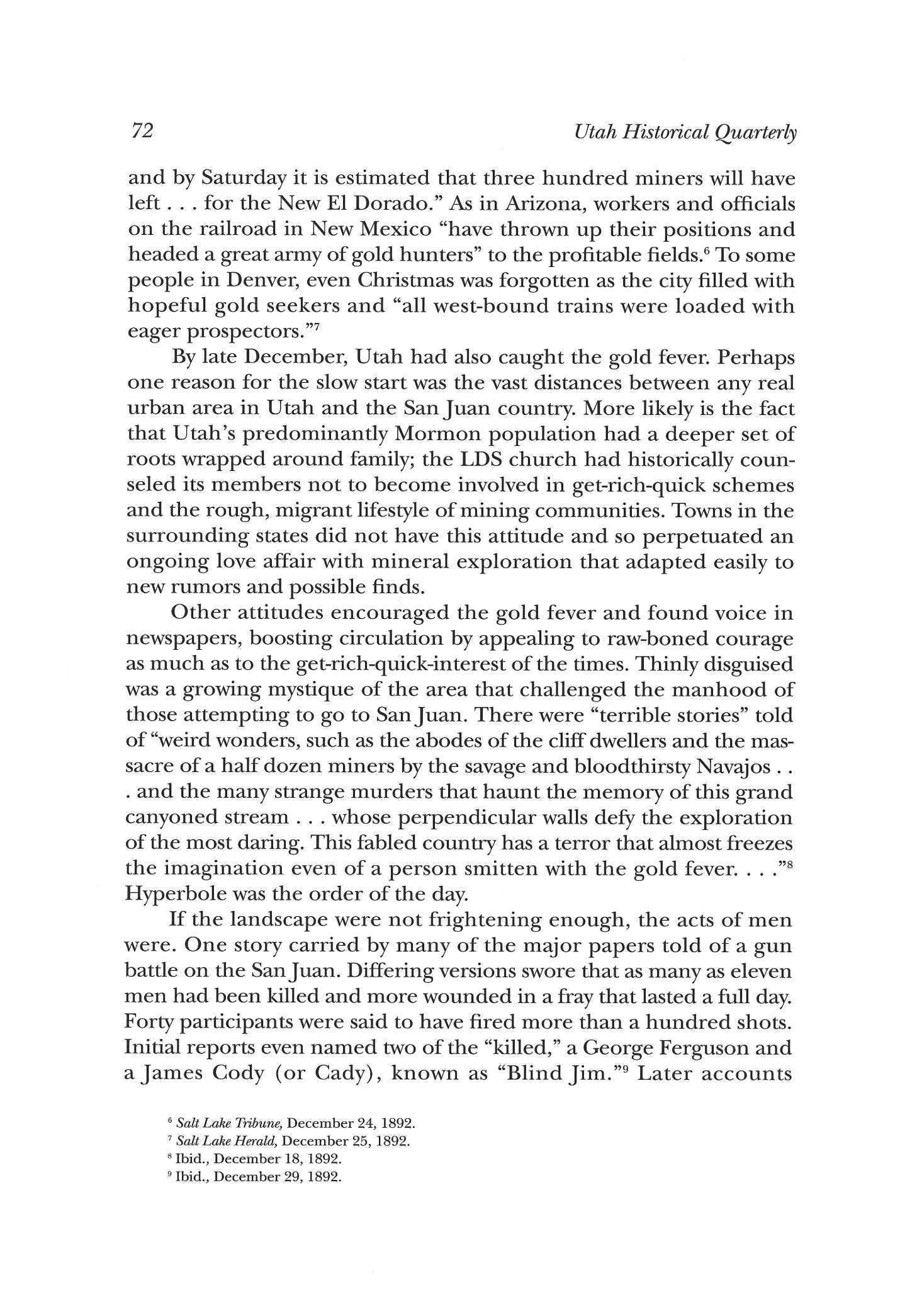
If the landscape were not frightening enough, the acts of men were One story carried by many of the major papers told of a gun battle on the SanJuan. Differing versions swore that as many as eleven men had been killed and more wounded in a fray that lasted a full day. Forty participants were said to have fired more than a hundred shots Initial reports even named two of the "killed," a George Ferguson and a James Cody (or Cady), known as "Blind Jim."9 Later accounts
6 Salt Lake Tribune, December 24, 1892
7 Salt Lake Herald, December 25, 1892
8 Ibid., December 18, 1892
9 Ibid., December 29, 1892
72 Utah Historical Quarterly
dropped both the number of dead and the length of the battle but raised the number of shots fired to over 200 Eventually the number of dead dwindled to one.
The fracas arose (as with most mining camp difficulties) over the rightful ownership of a rich gold claim sporting large nuggets Some versions had independent miners fighting workers from the Gable Mining Company while other accounts suggested more of a free-forall among independents. In either case, these stories gave legitimacy to the claim of an immense gold find on the SanJuan, where a series of low-grade quarrels over the discovery of nuggets one day could erupt into violence the next.10
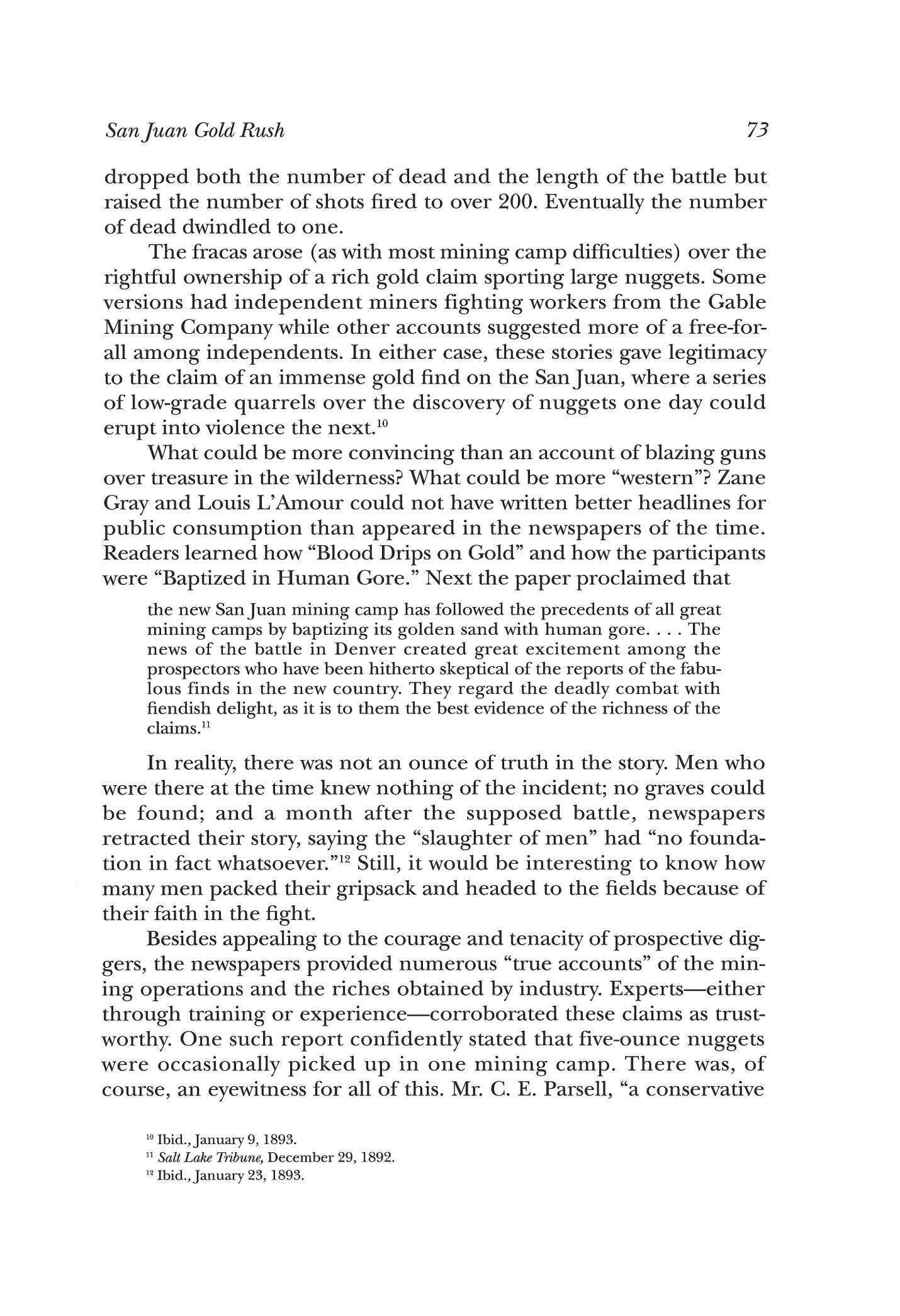
What could be more convincing than an account of blazing guns over treasure in the wilderness? What could be more "western"? Zane Gray and Louis L'Amour could not have written better headlines for public consumption than appeared in the newspapers of the time. Readers learned how "Blood Drips on Gold" and how the participants were "Baptized in Human Gore." Next the paper proclaimed that the new San Juan mining camp has followed the precedents of all great mining camps by baptizing its golden sand with human gore The news of the battle in Denver created great excitement among the prospectors who have been hitherto skeptical of the reports of the fabulous finds in the new country. They regard the deadly combat with fiendish delight, as it is to them the best evidence of the richness of the claims.11
In reality, there was not an ounce of truth in the story. Men who were there at the time knew nothing of the incident; no graves could be found; and a month after the supposed battle, newspapers retracted their story, saying the "slaughter of men" had "no foundation in fact whatsoever."12 Still, it would be interesting to know how many men packed their gripsack and headed to the fields because of their faith in the fight.
Besides appealing to the courage and tenacity of prospective diggers, the newspapers provided numerous "true accounts" of the mining operations and the riches obtained by industry. Experts—either through training or experience—corroborated these claims as trustworthy. One such report confidently stated that five-ounce nuggets were occasionally picked up in one mining camp. There was, of course, an eyewitness for all of this. Mr. C. E. Parsell, "a conservative
10 Ibid., January 9, 1893
11 Salt Lake Tribune, December 29, 1892
12 Ibid., January 23, 1893
SanJuan Gold Rush 73
Dempsey 's gold claim, showing the equipment used at a placer claim.
Charles Goodman photograph, courtesy Manuscripts Division, Marriott Library, University of Utah.
man [with] vast experience [and who was] not of an excitable temperament," testified that there were many one ounce nuggets and many more that ran a quarter to a half ounce each.13
W L Austin, "patentee of the Austin process, for treating rebellious gold and silver ores, and one of the very best metallurgists and geologists in America," rendered his opinion bolstered by scholarly credentials He believed that San Juan was one of the "greatest mineralized sections to be found on this continent."14 The fact that he had a product to sell to miners undoubtedly whetted his enthusiasm
Perhaps the most zealous of all those touting the gold rush were the railroad companies. Whether the miners found gold or not, they would, in most cases, need to use the railroads to get to the jumpingoff points for the gold field Railroad executives knew where gold could be found—in the pockets of those headed for the diggings. The Rio Grande Western, for instance, advertised the San Juan strike at a "lively rate," sending a representative to Montana and Idaho, while their California agents were "to hustle and to sing their little song of the gold-laden San Juan."15

Next, the railroads began a battle over the best route to the gold fields. From the point of view of the Salt Lake Herald, the Rio Grande Western provided the most efficient way into the fields The trip sounded easy. All one had to do was take the train, at the special rate of $8.50, from Salt Lake City to Thompson Springs, some thirty-five miles from the Colorado/Utah border, then follow a good wagon road through Moab to Monticello then Bluff. The train even offered a special rate for pack animals and general outfits.16
Denver papers reported that every railroad company coming into the city had issued a bulletin "with what purports to be a map of the
Salt Lake Herald, December 31, 1892
Mancos Times (Colorado), September 21, 1894
Salt Lake Tribune,January 3, 1893
Salt Lake Herald, December 22, 1892
...... . ... .
country, showing by some contrivance the fact that their road is the most direct route."17 The Rio Grande Southern, for instance, offered to forge a new path to the gold region. The road would start in Dolores or Mancos, would be 100 miles long, and would have its western terminus at Bluff City, "in the heart of the gold region."18 Nothing ever materialized.
The best-route conflict in Utah eventually shrank to two possibilities; one jumping off point was in Salina and the other in Green River. Train travel was possible to both towns, stores catered to the needs of miners, and the printing business boomed as well One newspaper reported that "Salina businessmen have printed 10,000 dodgers, advertising the advantages of that route to the San Juan country."19 The Salt Lake Herald announced that a map would shortly be issued by the Western, showing various routes from Ogden aswell as distances by team from Thompson's Spring, Green River station, Salina, and Elsinore.20
Out-of-state boosters followed suit. Albuquerque, Farmington, and Winslow established new stage lines along the Atlantic and Pacific Railway, as did Durango and Dolores, Colorado, on the Denver & Rio Grande. 2 1 The first stage to and from the gold fields returned to Dolores in four days with one coach, six horses, and twenty-one passengers. 22
While much of this excitement was self-perpetuating, there were those who were not fooled A few lone voices in the wilderness would later be able to announce smugly that they had tried to warn the masses, but at this point in the frenzy, few listened. A few examples of these warnings will suffice Cass Hite, a miner who had spent years on the San Juan before the rush, did not believe one word of the fabulous accounts. In a letter to Denver's Republican he tried to set the readership straight by pointing out the impossibility of these claims. Hite believed that any gold found in sedimentary formations was characteristically fine flour gold, that coarse gold did not travel far from its point of origin, and that any gold that had moved a considerable distance may have started out soft and heavy but before long would have been ground to a very light consistency.23
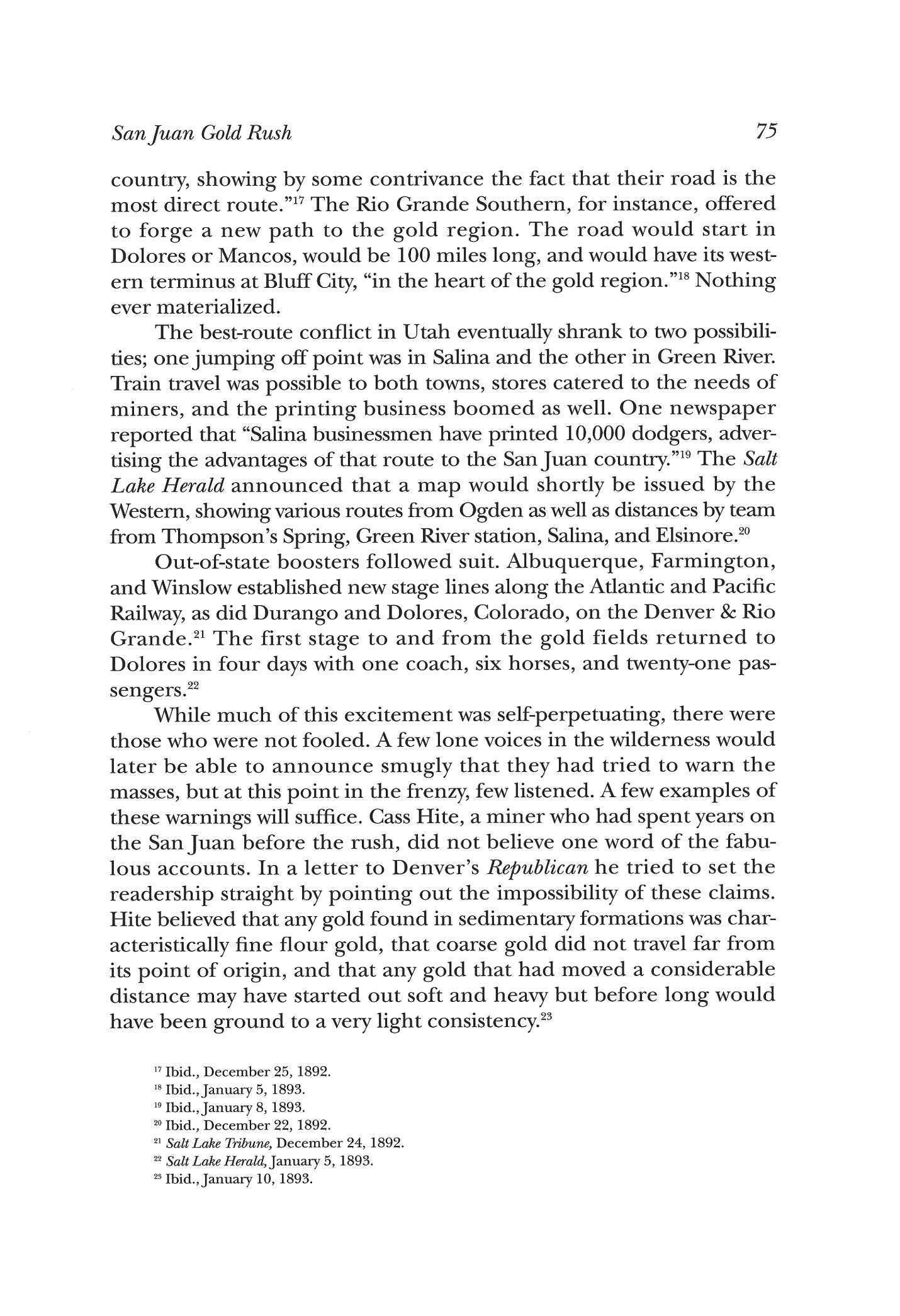
17 Ibid., December 25, 1892
18 Ibid., January 5, 1893.
19 Ibid., January 8, 1893
20 Ibid., December 22, 1892
21 Salt Lake Tribune, December 24, 1892
22 Salt Lake Herald, January 5, 1893
23 Ibid., January 10, 1893
San Juan Gold Rush 75
Others joined in trying to stop the "senseless stampede," as one paper called it, while another attacked the "San Juan fake." Eyewitnesses told of spending days on the river with little to show for their efforts, the gold being "so fine and light that so far it has been impossible to gather it."24 One person testified that many of the articles he had read about the gold fields ended with the statement that "the SanJuan is no country for a poor man." He went on to refute this with, "It is the greatest place on earth for a poor man, and the longer he stays there the poorer will he become." 2 5 Still, there was little staunching of the flow of humanity along the river and into the canyons.
Later, some sought revenge for having been fooled. One Dr. Shores grabbed a headline in the Salt Lake Tribune that summarized his story. It read: "Another San Juan Pilgrim Returns—He is Angry and Will Pursue the Author of the Fake." The article referred to him as an "owl" and "a wiser and more satisfied man than when he left three weeks ago." He complained that the SanJuan country was inaccessible and held uncountable hardships, all of which he would have gladly endured if there had been something at the end of his trials. There was not—"not a single redeeming feature." According to the article, the doctor had employed a Pinkerton detective "who will never rest night or day until the miscreant who started the SanJuan craze is brought to justice."26 There was no further report on the progress of the case.

If Shores had reason to be upset, the Utah Navajos had grounds for war. In 1884 President Chester A. Arthur, through executive order, had set aside all of the Utah lands south of the SanJuan River as part of the Navajo Reservation. At the time, no one seemed terribly concerned about what was considered a wasteland. But by 1892 the glint of gold had gilded that picture, setting in motion political events that would return to the public domain that part of the reservation believed to hold precious minerals
Interestingly, on December 28, 1892, only days after the initial news of the "discovery," the Salt Lake Herald reported that a change to the reservation boundary had been made "within the past sixty days." The placement of the land west of 110 degrees longitude back into public use had been "manipulated very quietly by some persons imme-
24 Ibid., January 18, 1893; Salt Lake Tribune, January 27, 1893
25 Salt Lake Tribune, January 30, 1893
26 Ibid., January 24, 1893
76 Utah Historical Quarterly
diately interested in the move. .. . It is presumed that parties have been locating claims in that country and working important discoveries, and that they obtained the influence of prominent men to secure a release."27 A settler in Bluff was even more blunt To him, "It is a great stampede, and I think it has been worked for a purpose."28
The Navajos may not have understood the political shenanigans, but they did understand encroachment. Conflict resolution took two different forms for them. In one instance a man known as Navajo Frank went to Mancos to discuss the issues. According to him, the problem and its solution were clear. The newspapers reported, in a style entertaining to its readers, his broken English Frank is reported to have said,

Indian put on reservations by Big White Chief and white man he no must come round. Long time now white man he comes from below. Whole lot white man, all got guns on San Juan. Gold belongs to Indian. White man no have it White man must keep off Indian's land Indian no go on white man's land. Indian no cross San Juan.29
Although the prose may have amused its readers, the meaning is clear and perceptive.
In response to this announcement, Captain Ben K. Wetherill, a member of the well-known trading family in the Four Corners area, advised compliance with Frank's suggestion and respect for established boundaries. He believed that once the Navajos were aroused they could be dangerous. Wetherill noted that they generally stayed on their lands and that white prospectors should not come onto it. He ended by saying, "Frank talks in earnest, and if there is a feeling
Salt Lake Herald, December 28, 1892
Ibid., January 18, 1893, reprint of letter to Joseph A. Young from Platte D. Lyman. Salt Lake Tribune, December 26, 1892
A mining camp on the river, 1894. Charles Goodman photo, courtesy of Manuscripts Division, Marriott Library, University of Utah.
against the white men, all the old timers who know anything about the Navajo will keep on the north side of the San Juan."30
Unfortunately, the conciliatory advice on both sides was often ignored. As more whites flooded into the area, the balance of power shifted, decreasing the chances that the Navajos could successfully curtail the white encroachment. A newspaper report dismissed any action by the Navajos as irrelevant because "there are so many white men in the country now that the savages are not feared."31
The Navajos, however, did not sit passively by, ignoring the encroachment upon their lands There was no widespread violence, but there were accounts concerning the trespass of boundaries. One claimed that "the Navajos have driven out every party of prospectors crossing the San Juan River. David Miengies' outfit made their way back on foot, the horses and pack outfit having been run off by the Indians. Miengies says the Indians are massing and mean trouble."32 Another report told of the Indians driving prospectors from the south side of the SanJuan, destroying claim markers and scattering the miners' horses and burros.33 Thus, the Navajos waged an aggressive defensive policy to maintain the lands given to them
Ironically, the most sensational report of Native American violence over mining was one in which no Euro-Americans actually took part The incident arose over a raid organized by Navajo Henry Ever since the rush began, Henry had tried to arouse the Indians, and now he planned to attack the prospectors and any Navajos friendly to their cause. Unfortunately for Henry, he ran into a group of Navajos who did not share his feelings. After pulling a gun on one man, he and his followers became embroiled in a fight that ended in Henry being chopped to pieces with an ax; many of his associates were seriously injured.34 While this incident was atypical, it certainly illustrates how divided the sides could become Once enthusiasm for the rush subsided, however, both the Navajos and the Anglos relaxed their vigilance, and life returned to normal
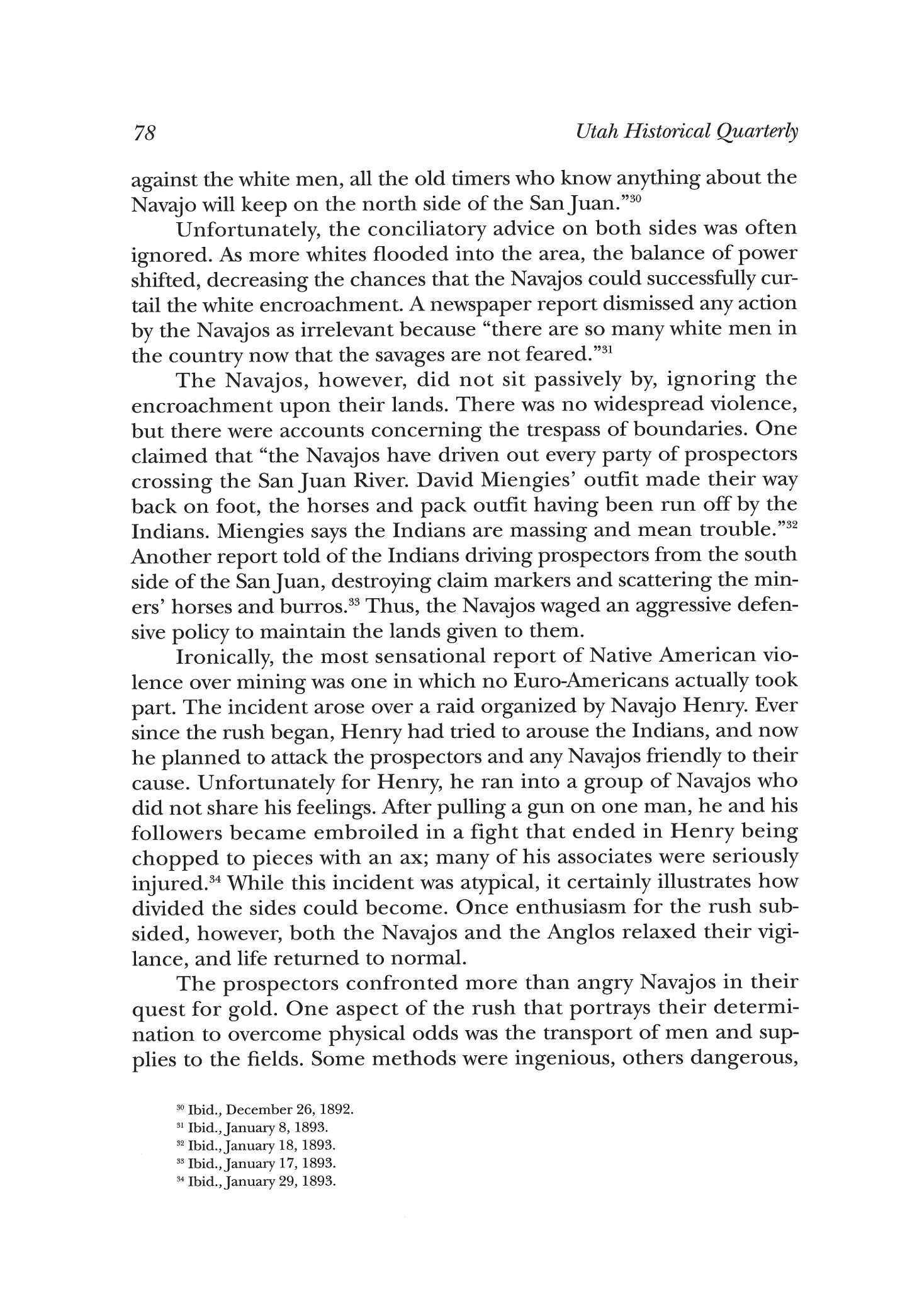
The prospectors confronted more than angry Navajos in their quest for gold. One aspect of the rush that portrays their determination to overcome physical odds was the transport of men and supplies to the fields. Some methods were ingenious, others dangerous,
30 Ibid., December 26, 1892
31 Ibid., January 8, 1893
32 Ibid., January 18, 1893
33 Ibid., January 17, 1893.
34 Ibid., January 29, 1893
78 Utah Historical Quarterly
Honaker's home and store on the San Juan River, courtesy ofSanJuan County Historical Commission; trail to Honaker's camp on the river; Charles Goodman photo, courtesy ofManuscripts Division, Marriott Library, University of Utah.
and still others labor-intensive, but all pitted man against the land. As the rush progressed, a burgeoning network of roads crisscrossed the rough canyon country, skirting the river and slicing across the high desert region of southeastern Utah Roads for horses, pack mules, and, in a few instances, wagons started to appear in some of the most impossible places. Paths snaked up Comb Wash, crossed over Lime Ridge, branched off to Mexican Hat, or continued on to Clay Hills or the mouth of Slickhorn Canyon.
Some routes were death-defying. Take, for instance, the one pioneered by A. C. Honaker and Charles Goodman that went to their mine located at Sheep's Head Bar, fifty miles west of Bluff. The site was almost inaccessible, lying 1,600 feet below the rim of the canyon. But the men used powder and tools to cut a trail to the river with the hope that gold-saving machines could be brought in and the "fun" begin.35 The result of this engineering feat, known as the Honaker Trail, begins about eight miles below Mexican Hat and traverses down the face of the escarpment for two and a half miles. Despite the builders' high hopes, not even pack animals but only humans were able to use the trail.36
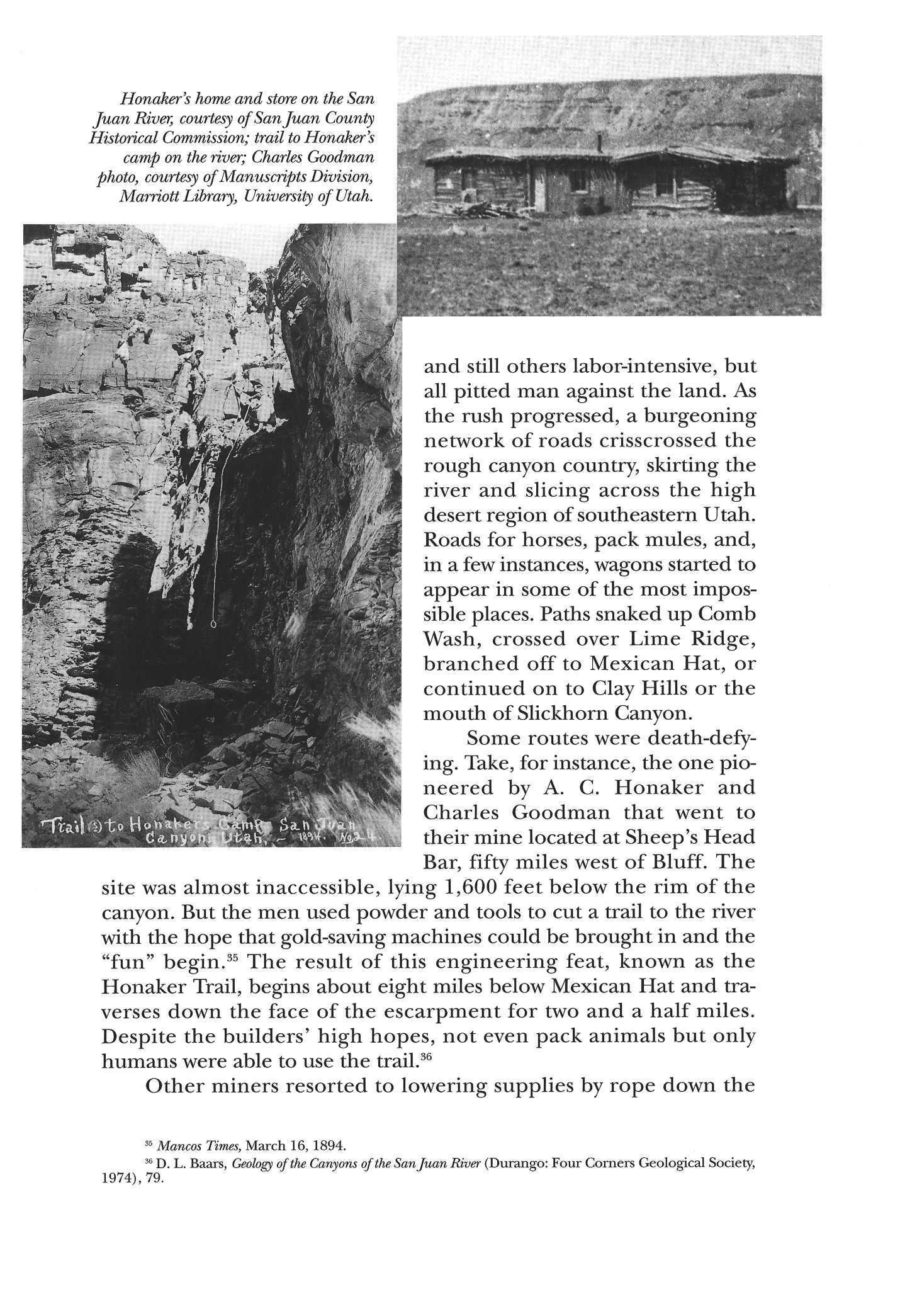
Other miners resorted to lowering supplies by rope down the
35 Mancos Times, March 16, 1894
36 D L Baars, Geology of the Canyonsof the SanJuan River (Durango: Four Corners Geological Society, 1974), 79.
cliffs to the banks below Bert Loper, who came to San Juan in 1893, describes the difficulty in using this system.
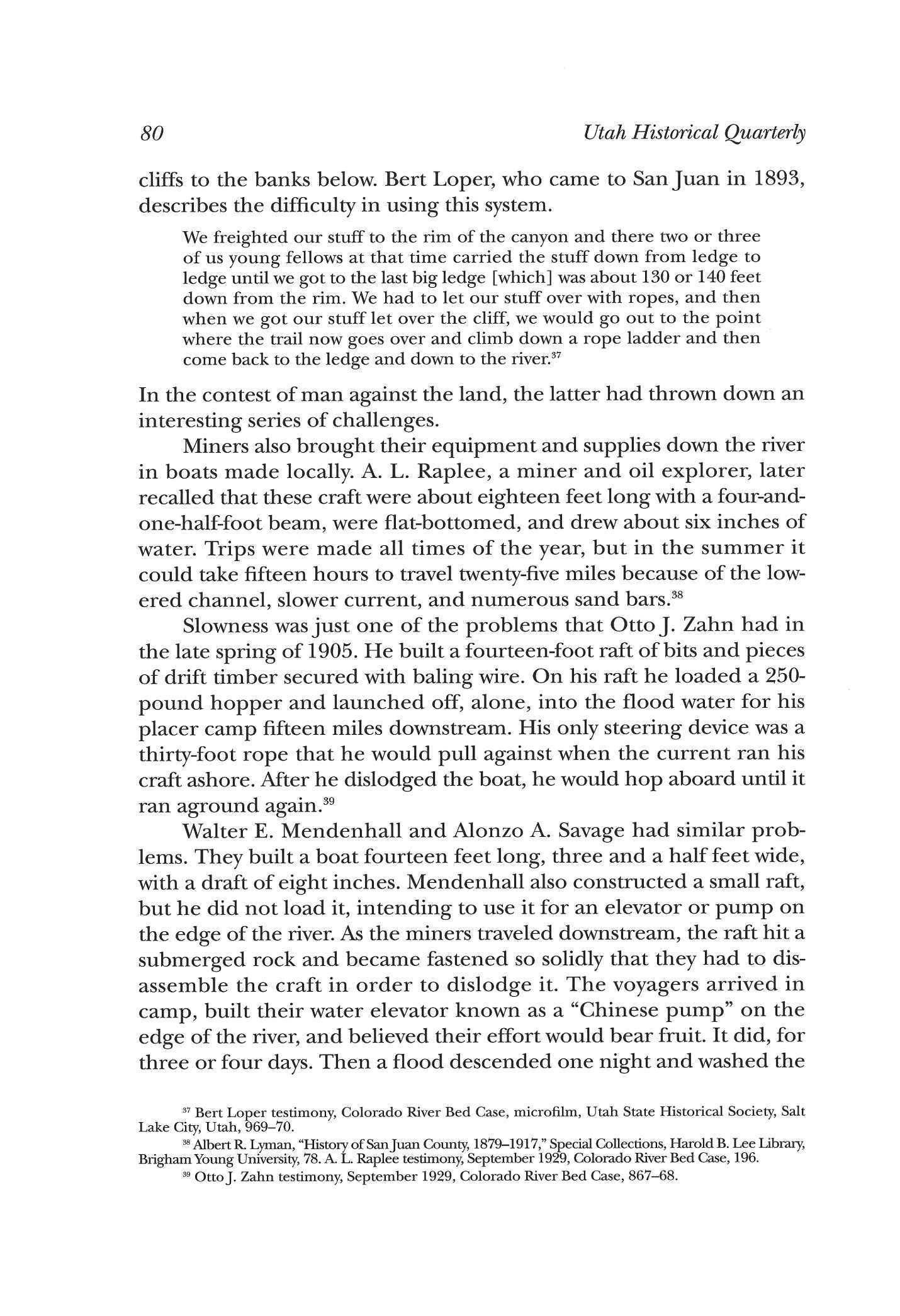
We freighted our stuff to the rim of the canyon and there two or three of us young fellows at that time carried the stuff down from ledge to ledge until we got to die last big ledge [which] was about 130 or 140 feet down from the rim We had to let our stuff over with ropes, and then when we got our stuff let over the cliff, we would go out to the point where the trail now goes over and climb down a rope ladder and then come back to the ledge and down to the river.37
In the contest of man against the land, the latter had thrown down an interesting series of challenges.
Miners also brought their equipment and supplies down the river in boats made locally. A. L. Raplee, a miner and oil explorer, later recalled that these craft were about eighteen feet long with a four-andone-half-foot beam, were flat-bottomed, and drew about six inches of water. Trips were made all times of the year, but in the summer it could take fifteen hours to travel twenty-five miles because of the lowered channel, slower current, and numerous sand bars.38
Slowness wasjust one of the problems that Otto J Zahn had in the late spring of 1905. He built a fourteen-foot raft of bits and pieces of drift timber secured with baling wire. On his raft he loaded a 250pound hopper and launched off, alone, into the flood water for his placer camp fifteen miles downstream. His only steering device was a thirty-foot rope that he would pull against when the current ran his craft ashore. After he dislodged the boat, he would hop aboard until it ran aground again.39
Walter E. Mendenhall and Alonzo A. Savage had similar problems. They built a boat fourteen feet long, three and a half feet wide, with a draft of eight inches. Mendenhall also constructed a small raft, but he did not load it, intending to use it for an elevator or pump on the edge of the river. As the miners traveled downstream, the raft hit a submerged rock and became fastened so solidly that they had to disassemble the craft in order to dislodge it. The voyagers arrived in camp, built their water elevator known as a "Chinese pump" on the edge of the river, and believed their effort would bear fruit It did, for three or four days. Then a flood descended one night and washed the
37 Bert Loper testimony, Colorado River Bed Case, microfilm, Utah State Historical Society, Salt Lake City, Utah, 969-70
38 Albert R Lyman, "History of SanJuan County, 1879-1917," Special Collections, Harold B Lee Library, Brigham Young University, 78 A L Raplee testimony, September 1929, Colorado River Bed Case, 196
39 Otto J Zahn testimony, September 1929, Colorado River Bed Case, 867-68
80 Utah Historical Quarterly
Atwood Mining Camp. The boat was later taken to Lee's Ferry, where it was used as a ferry for years. Courtesy of San Juan County Historical Commission.
elevator and framework down the river before the men could save any of it. At that point, it was back to the pan and rocker.40
A few of the miners even managed to go up the river against a strong current, using poles, oars, and ropes. Frank H. Karnell remembers building a boat in Bluff, filling it with one thousand pounds of supplies, and floating it down to his camp above Mexican Hat. He used the same boat for making his wayupriver, two to three miles at a time, to work various placer sites on the gravel bars. At one point, he and his partners used three boats to ply the SanJuan; they were not alone Frank recalled twenty groups sailing past him at different times during this period.41 Few, if any, of these travelers ever brought their boats back to Bluff, the point of origin.
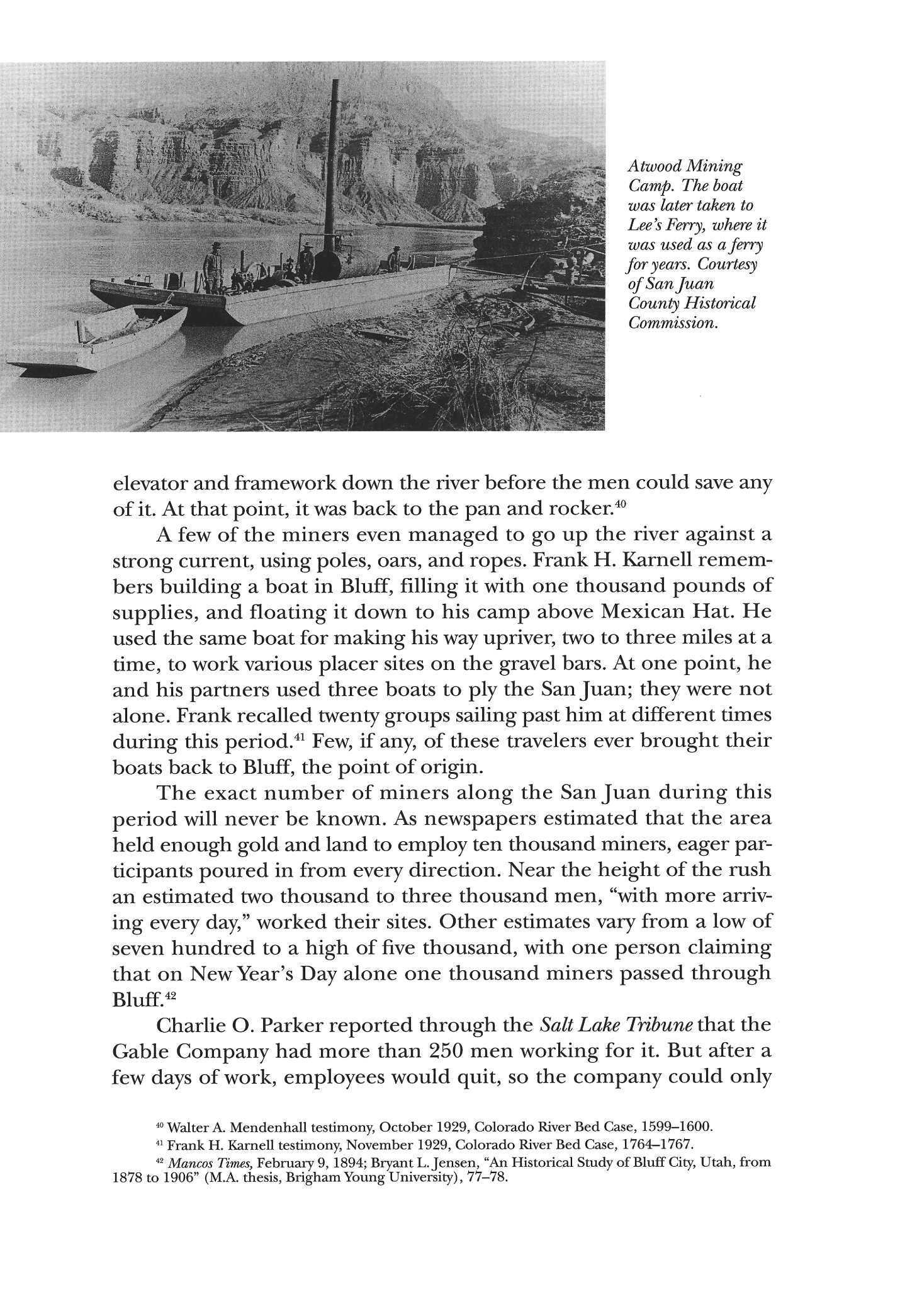
The exact number of miners along the San Juan during this period will never be known. As newspapers estimated that the area held enough gold and land to employ ten thousand miners, eager participants poured in from every direction. Near the height of the rush an estimated two thousand to three thousand men, "with more arriving every day,"worked their sites Other estimates vary from a low of seven hundred to a high of five thousand, with one person claiming that on NewYear's Day alone one thousand miners passed through Bluff.42
Charlie O. Parker reported through the Salt Lake Tribune that the Gable Company had more than 250 men working for it. But after a few days of work, employees would quit, so the company could only
f~:xZ£.*Jk'-,\\\-
40 Walter A Mendenhall testimony, October 1929, Colorado River Bed Case, 1599-1600
41 Frank H. Karnell testimony, November 1929, Colorado River Bed Case, 1764-1767.
42 Mancos Times, February 9, 1894; Bryant L.Jensen, "An Historical Study of Bluff City, Utah, from 1878 to 1906" (M.A thesis, Brigham Young University), 77-78
hold on to its "broke men, as everybody with a few dollars is out staking off claims." Parker went on to estimate that there were then 3,000 men working along the river and that he knew of one man who sold out his claim to a Denver company for $10,000.43
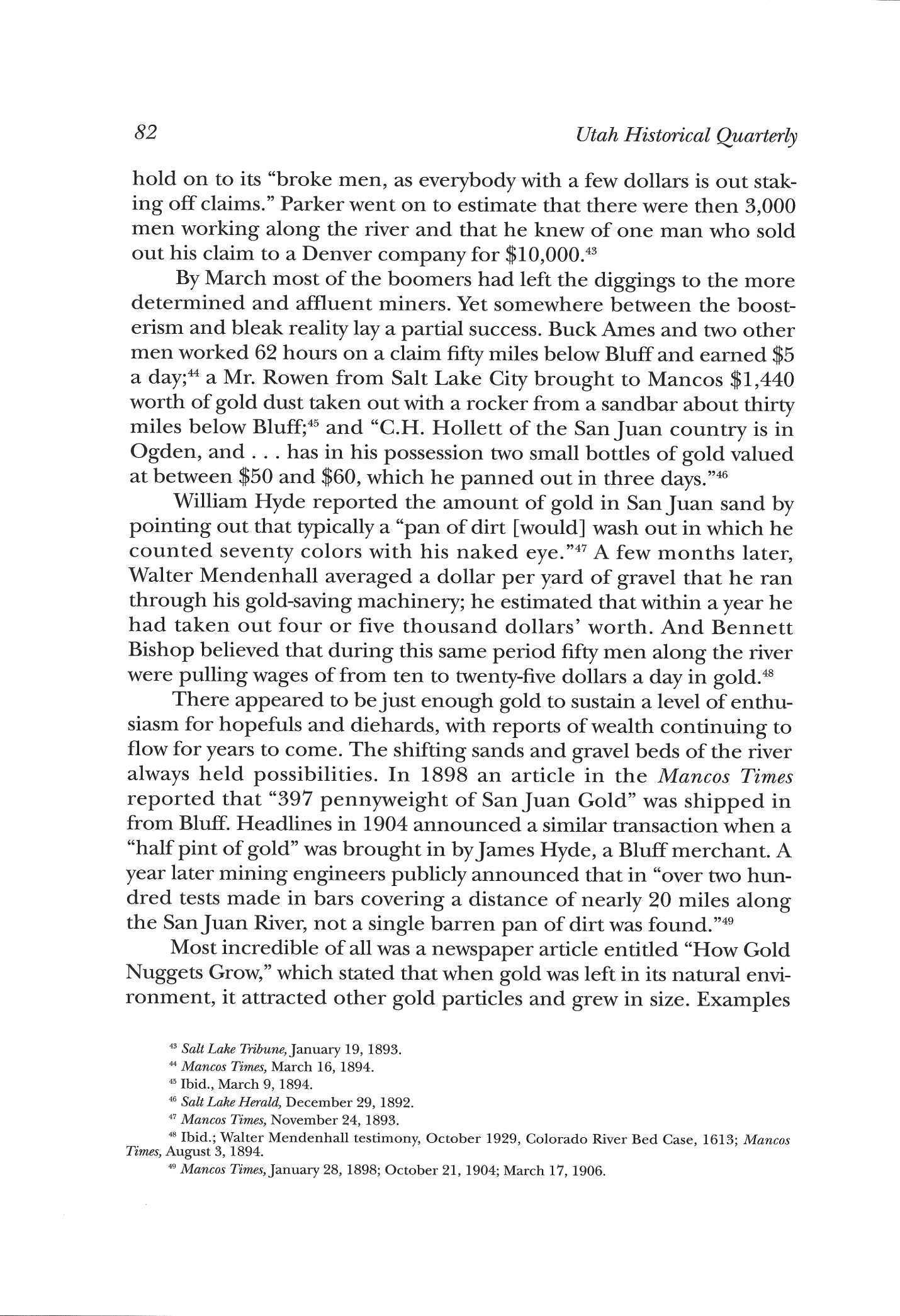
By March most of the boomers had left the diggings to the more determined and affluent miners. Yet somewhere between the boosterism and bleak reality lay a partial success. Buck Ames and two other men worked 62 hours on a claim fifty miles below Bluff and earned $5 a day;44 a Mr. Rowen from Salt Lake City brought to Mancos $1,440 worth of gold dust taken out with a rocker from a sandbar about thirty miles below Bluff;45 and "C.H. Hollett of the San Juan country is in Ogden, and . . . has in his possession two small bottles of gold valued at between $50 and $60, which he panned out in three days."46
William Hyde reported the amount of gold in San Juan sand by pointing out that typically a "pan of dirt [would] wash out in which he counted seventy colors with his naked eye."47 A few months later, Walter Mendenhall averaged a dollar per yard of gravel that he ran through his gold-saving machinery; he estimated that within a year he had taken out four or five thousand dollars' worth And Bennett Bishop believed that during this same period fifty men along the river were pulling wages of from ten to twenty-five dollars a day in gold.48 There appeared to bejust enough gold to sustain a level of enthusiasm for hopefuls and diehards, with reports of wealth continuing to flow for years to come. The shifting sands and gravel beds of the river always held possibilities. In 1898 an article in the Mancos Times reported that "397 pennyweight of San Juan Gold" was shipped in from Bluff. Headlines in 1904 announced a similar transaction when a "half pint of gold" was brought in byJames Hyde, a Bluff merchant. A year later mining engineers publicly announced that in "over two hundred tests made in bars covering a distance of nearly 20 miles along the SanJuan River, not a single barren pan of dirt was found."49
Most incredible of all was a newspaper article entitled "How Gold Nuggets Grow," which stated that when gold was left in its natural environment, it attracted other gold particles and grew in size. Examples
43 Salt Lake Tribune, January 19, 1893
44 Mancos Times, March 16, 1894
45 Ibid., March 9, 1894.
46 Salt Lake Herald, December 29, 1892
47 Mancos Times, November 24, 1893.
48 Ibid.; Walter Mendenhall testimony, October 1929, Colorado River Bed Case, 1613; Mancos Times, August 3, 1894.
49 Mancos Times, January 28, 1898; October 21, 1904; March 17, 1906.
82 Utah Historical Quarterly
of this phenomenon had been "observed" in mines in California. The article closed by speculating that people might abandon regular farming to establish gold farms where they would grow nuggets for a crop. 50 In the goldfields, hope sprang eternal.
The traditional "lost" mine also engendered hope, and San Juan had its own. The story revolves around Indianan Samuel Brooks, who came to southeastern Utah to earn his fortune. He went to the Comb Wash area and set up camp along one of the intermittent streams. Lady Luck bedded down with him; in a few days he found uncharacteristically large nuggets on top of the ground in a dry gravel wash Exuberant with his find, he took his samples to Bluff to buy supplies The test on the majority of his nuggets proved them to be fool's gold. However, after a second trip with another batch of minerals, he had positive proof of what he had come for—gold.
When Brooks returned to his camp, he noticed that a pile of rejected fool's gold had been taken by two individuals wearing moccasins. Concerned for his welfare, he began carrying a weapon and keeping close watch on the surrounding area. In the meantime, a well-
 Frank Hyde and A. L. Raplee; Beatrice Nielson collection, courtesy of SanJuan County Historical Commission. Raphe's placer mine, 1889; Charles Goodman photo, courtesy ofManuscripts Division, Marriott Library.
Frank Hyde and A. L. Raplee; Beatrice Nielson collection, courtesy of SanJuan County Historical Commission. Raphe's placer mine, 1889; Charles Goodman photo, courtesy ofManuscripts Division, Marriott Library.
Montezuma Journal, August 28, 1903
known Paiute from the area, Posey, attempted to trade gold nuggets to a Bluff storekeeper who recognized them as the same fool's gold that he had tested earlier
Brooks continued to pick up his nuggets, gathering more than one hundred pounds. Then one night, while preparing his meal, he was ambushed, but he managed to get under cover and stop the bleeding. After some time, three Indians, with weapons ready, approached the camp Brooks shot one; the other two escaped unscathed, but his action earned him enough time to pack his stash and gear on twoanimals and set out for Bluff. There, the settlers cared for his infected wounds.
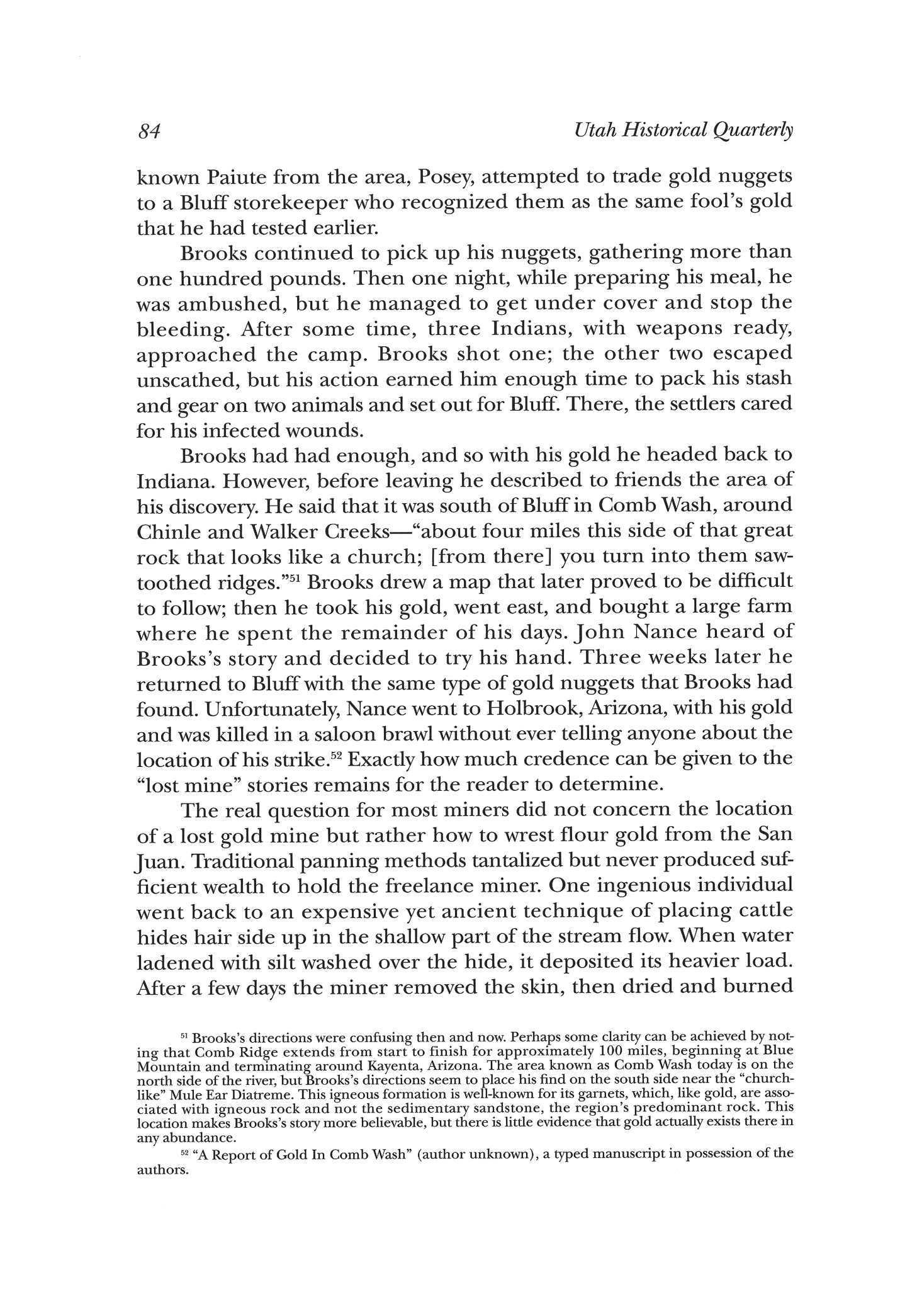
Brooks had had enough, and so with his gold he headed back to Indiana. However, before leaving he described to friends the area of his discovery. He said that it was south of Bluff in Comb Wash, around Chinle and Walker Creeks—"about four miles this side of that great rock that looks like a church; [from there] you turn into them sawtoothed ridges."51 Brooks drew a map that later proved to be difficult to follow; then he took his gold, went east, and bought a large farm where he spent the remainder of his days. John Nance heard of Brooks's story and decided to try his hand. Three weeks later he returned to Bluff with the same type of gold nuggets that Brooks had found. Unfortunately, Nance went to Holbrook, Arizona, with his gold and was killed in a saloon brawl without ever telling anyone about the location of his strike.52 Exactly howmuch credence can be given to the "lost mine" stories remains for the reader to determine.
The real question for most miners did not concern the location of a lost gold mine but rather how to wrest flour gold from the San Juan. Traditional panning methods tantalized but never produced sufficient wealth to hold the freelance miner. One ingenious individual went back to an expensive yet ancient technique of placing cattle hides hair side up in the shallow part of the stream flow. When water ladened with silt washed over the hide, it deposited its heavier load. After a few days the miner removed the skin, then dried and burned
51
abundance
52 "A Report of Gold In Comb Wash" (author unknown), a typed manuscript in possession of the authors
84 Utah Historical Quarterly
Brooks's directions were confusing then and now Perhaps some clarity can be achieved by noting that Comb Ridge extends from start to finish for approximately 100 miles, beginning at Blue Mountain and terminating around Kayenta, Arizona The area known as Comb Wash today is on the north side of the river, but Brooks's directions seem to place his find on the south side near the "churchlike" Mule Ear Diatreme. This igneous formation is well-known for its garnets, which, like gold, are associated with igneous rock and not the sedimentary sandstone, the region's predominant rock This location makes Brooks's story more believable, but there is little evidence that gold actually exists there in any
it, recovering the gold from the ashes. Reportedly, he obtained a full pound of gold from this process, but it cost him thousands of dollars. Both expense and effort proved to be too much to sustain this operation.53
As in countless other attempts to obtain wealth from the landscape, the situation called for better, more sophisticated technology and more investment capital to sustain the operation. New methods for extracting gold were as numerous and distinctive as the names that graced the equipment. Some of the titles of these gold-saving machines taken from newspaper accounts over the years include: the Straum Machine, the Mendenhall Machine, the Kennedy Gold Saving Machine, the Bennett Amalgamator, thejessup Machine, the Austin Process, the Ernsberger Machine, the Automatic Gold Separator, the Fitzgerald, and the Comet Amalgamator.
Thus, in a land that freely provided nothing, it took green dollars to milk wealth from the brown waters of the SanJuan Beyond the traditional pan, rocker, and sluice box, the second phase of mineral extraction began in early 1894. By this time the get-rich-quick boomers were gone It was now technology's turn to pit itself against the resources of a stingy land.

Two men, D. H. Lemmon and Major J. W Hanna, serve as examples of those who put their money where their faith was. The two men used a Kennedy machine that required an engine both to pump water from the river fifty feet away and to separate gravel from the high bars above the river bank. Sand and silt in the water clogged the filters and quickly wore out the packings on the pump Yet the miners wanted this sand because it held the gold. At one point, Hanna believed "the finest sand is no more nor less than a gold quartz." In order to retrieve it, he considered using a cyanide mill, but no further mention is made of this deadly chemical being utilized for mineral extraction.54 The experimenting went on By August 1894 Lemmon and Hanna had completed extensive testing of the large gravel beds along the river and had chosen a spot near Bluff. There they placed two Kennedy machines and "an electroplate of large capacity" that were said to save all the gold that funneled through them.55 The men believed they
54 Mancos Times, March 30, 1894; April 20, 1894
55 Ibid., July 6, 1894; August 17, 1894
SanJuan Gold Rush 85
53 Mrs E.J (Billie) Yost to Otis Marston, December 5, 1955, correspondence in possession of authors Yost was writing about the experiences of her father, William F Williams, during the gold rush era.
could process between 200 and 250 cubic yards of gravel a day at a value of over fifty cents per cubic yard.
In September Major Hanna pronounced himself a success In a newspaper interview he declared he had spent $7,000 in experimentation over a year's time. He estimated that there were now two hundred men along the river working both the high and low banks for seventy miles downstream. "A man with a rocker made out of candle box makes $3 to $7 a day With improved machinery he can do better."56 Hanna went on to describe his operation on the high sand bars. Wheel scrapers pushed boulders and sand to the machine where the large rocks then fell through to the river while the sand passed through three sets of screens. A copper plate with quicksilver amalgamated the gold, saving it for further processing. According to Hanna, at this point in the venture he had recouped his expenses. 57
Hanna and Lemmon would mine for a few more years, but they eventually gave in to defeat Others, such as Charles Spencer in the early 1900s, would take up the banner of gold, swearing that crushing rock, dredging the river, and amalgamating chemically held the solution to the problem.58 However, more expensive schemes and greater technological investment still could not wrench enough precious metal out of the river to make it pay. Machines reported to process fifty cubic yards a day were to be replaced with multiples of machines that could do a hundred cubic yards daily. At one point Spencer estimated that eventually these river sites would be churning out $5,000 worth of gold a day. But Spencer, like Hanna, was good for only a few years before he also climbed out of the business.

While men and machines worked along the river and found poverty, the people upstream prospered. The peaceful Mormon town of Bluff assumed a bustling, mercantile atmosphere as the demand for goods of all types increased. Freighting from Mancos, Cortez, and Durango took on new proportions as everything from clothes, tools, and food for miners, as well as hay for horses, poured into the community. While overland freighters held the lion's share of the business, some goods arrived by boat from Farmington—a trip that in itself would have been an adventure
56 Ibid., September 21, 1894
57 While this process with the copper plate is not entirely clear, part of the operation was based on a well-established practice: quicksilver—mercury—dissolves the gold into an amalgam, and then the mercury is removed either chemically (nitric acid) or with heat The gold remains behind
58 Mancos Times-Tribune, February 7, 1906; Denver Post, July 29, 1907; Mancos Times-Tribune, January 5, 1912, April 5, 1912
86 Utah Historical Quarterly
Close on the heels of the gold-seekers came alcohol, gambling, and other vices that the Mormon citizenry felt obligated to curtail Albert R Lyman, a young boy at the time, watched the drama of "good and evil" unfold. When a load of whiskey arrived in town, the Bluff City fathers purchased it from a would-be saloonkeeper, locked it in an old shoe shop away from the thirsty throats of a gathering clientele, then made the mistake of letting an outsider ascertain the kegs' location in the building. That night, a man crawled under the store, drilled through the floor, punctured the barrels, and filled the jugs passed to him by the waiting crowd. Lyman reports, "The plot worked like a charm, and before morning, more drunken men wallowed in the streets than Bluff ever saw before or since."59
While "evil" triumphed in the streets of Bluff that morning, Lyman was later able to witness the "good." An entry in his diary dated December 30, 1893, recorded, "Pa baptized a man today. The boom brought him in and he has stayed ever since That boom brought many men to the sound of the gospel Five of them have been baptized; thus we see the hand of the Lord in all things—that He ruled over the SanJuan boom for God."60
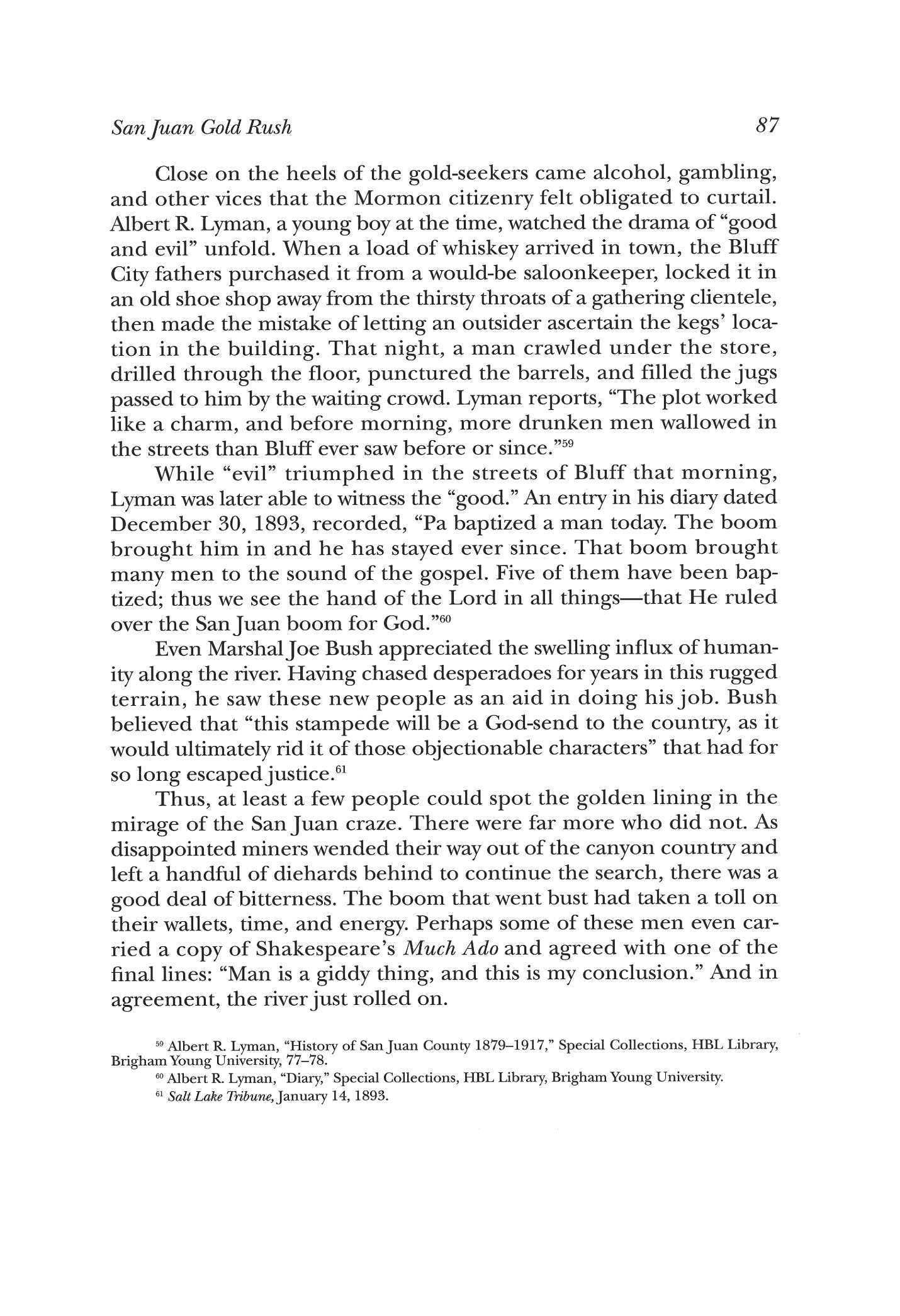
Even MarshalJoe Bush appreciated the swelling influx of humanity along the river Having chased desperadoes for years in this rugged terrain, he saw these new people as an aid in doing his job Bush believed that "this stampede will be a God-send to the country, as it would ultimately rid it of those objectionable characters" that had for so long escaped justice.61
Thus, at least a few people could spot the golden lining in the mirage of the San Juan craze. There were far more who did not. As disappointed miners wended their way out of the canyon country and left a handful of diehards behind to continue the search, there was a good deal of bitterness. The boom that went bust had taken a toll on their wallets, time, and energy. Perhaps some of these men even carried a copy of Shakespeare's Much Ado and agreed with one of the final lines: "Man is a giddy thing, and this is my conclusion." And in agreement, the riverjust rolled on.
59 Albert R Lyman, "History of San Juan County 1879-1917," Special Collections, HBL Library, Brigham Young University, 77-78
60 Albert R Lyman, "Diary," Special Collections, HBL Library, Brigham Young University
61 Salt Lake Tribune, January 14, 1893
San Juan Gold Rush 87
The very rich have often intrigued us, and this book is about one of Utah's wealthiest: Suzanne Bransford Authors Judy Dykman and Colleen Whitley give us almost a year-by-year account of her life, beginning with her ancestors— prosperous Southerners prior to the Civil War—and her early years in California when it was still a frontier As a young woman in the 1880s Susie worked on the West Coast sewing dresses, making hats, and styling hair— work she would later deny having done when Eastern society leaders shunned her after learning she had once worked as a common laborer Still single in her mid-twenties and looking for a change, she followed family friends to Park City, a well-established mining town when she arrived in 1884 Her early years in Park City are elusive to the authors, perhaps due to Susie's own request that letters and diaries referring to this time be destroyed.
Shortly after her arrival in Utah, Susie married Albion B. Emery, who was thirteen years her senior. "The Emerys' marriage was surprisingly happy even though they hadn't known each other long" (24). Within this union Susie failed to have her own child, but she and Albion became parents to her sister's child when he was left motherless shortly after his birth They also adopted a shy, quiet girl, Louise Grace, whose personality sharply contrasted with Susie's flamboyance Their relationship was
strained most of their lives as Grace failed to live up to Susie's social expectations
When Susie was only thirty-five, Albion's death left her a widow Albion left no will, and his estate was settled in a major court case that would smear the Emery name in Utah's newspapers and turn Susie's public image from that of a grieving widow into a greedy, ungrateful friend.
By the time she married her second husband, Colonel Holmes, a prominent Utah citizen, Susie was already moving into the Gilded Age high society by incorporating their norms and behavior Her high-style living in elaborate homes and fashionable hotels provided places of flamboyant entertaining when she was not traveling around the country and Europe Her magnificent dresses would become one of the hallmarks of her social image Her money came from stock holdings in Utah mining.
The balance of the book gives the reader an in-depth look into this famous woman's life as the authors detail her years with family and friends Though much of her time was spent away from the state, many of us remember landmark buildings associated with the family. These include the Bransford Apartments that stood on the northeast corner of State Street and South Temple; the Louise Grace Emery Apartments on the corner of State Street and North Temple; and of

h L i h . if n>'\ 1 ' ; h h L I m II mm Ml i >5I 1 •••• M want Book Reviews \uman Hi II T l [il II miirtinfiii Lililll III! 'OWttl [ill] r*»l 1\ rciiirii t 1 1 -J
T/?e Silver Queen: Her Royal Highness Suzanne Bransford Emery Holmes Delitch Engalitcheff 1859-1942. ByJUDYDYKMAN and COLLEEN WHITLEY (Logan: Utah State University Press, 1998 xii + 188 pp Cloth, $37.95; paper, $22.95.)
course the Gardo House, originally built by Brigham Young but perhaps made famous when Susie owned it and lived there
The authors' research is extensive and impressive, including conversations with many of Susie's descendants and acquaintances. Numerous primary sources were also consulted, furthering the documentation of Susie's life The book abounds with period photographs, helping the reader understand Utah's Gilded Age. The authors have also carefully and helpfully placed Susie within national historic events.
Susie would marry three more times, not always happily. With one, Prince Nicholas V. Engalitcheff, she earned her coveted title The Great Depression and falling stock values decimated her assets, yet she continued to maintain her facade of wealth to impress the eastern social aristocracy.
Susie resorted to selling the jewels from necklaces to finance her travels; a sign of failure in the society she worked so hard tojoin would be to "drop out" and not be constantly seen on the travel circuit Her attempt to replenish
her finances with a biography failed as the world's attention turned to current events of a pending world war and away from aging socialites
In the end, it is a sad story. In her quest tojoin the East Coast high society she denied her roots and eventually lost her loved ones The family had many divisions, some public, as money disputes were fought out in court. Susie's family members were lost before she made amends She died surrounded by little love and no money
For those interested in the lifestyles of the flamboyant Gilded Age as played out in Utah, this book is for you It is a complete biography of one of Utah's best-known socialites of this period as well as an excellent description of how the very rich in this era lived Susie is a tragic and perhaps ironic example of this clique—one who worked so hard to belong, then, once accepted, worked full-time to maintain her position there at a great personal cost.
ANN CHAMBERS NOBLE Cora, Wyoming
Living at the Edge: Explorers, Exploiters and Settlers of the Grand Canyon Region. By MICHAEL F. ANDERSON. (Grand Canyon, Ariz.: Grand Canyon Assoc, 1998. viii + 184 pp Paper, $18.95.)
We have in this volume the history and culture of the Grand Canyon, a new picture of the canyon, and a fresh interpretation of its importance in the development and shaping of history with regard to the human element living on the rims. It is easily the best account yet written about the people living on the rim who left their marks upon one of earth's mightiest wonders The reader is awestruck by 200 rare historic photographs, many never published.
Michael F Anderson is a scholar's historian He collected voluminous material, studied it carefully, and inter-
preted the information as objectively as his background would allow. Using twelve custom maps, the author blended geography with the human story of this "big hole in the earth's surface." It is the most complete treatment yet given pioneer history in and about the Grand Canyon. There are many books about the canyon—its geology, majesty, and splendor There are very few books that encompass the story of humans at the edge of the canyon
Stories of the Spanish, mountain men, and government surveyors unfold easily I was fascinated with the tracing
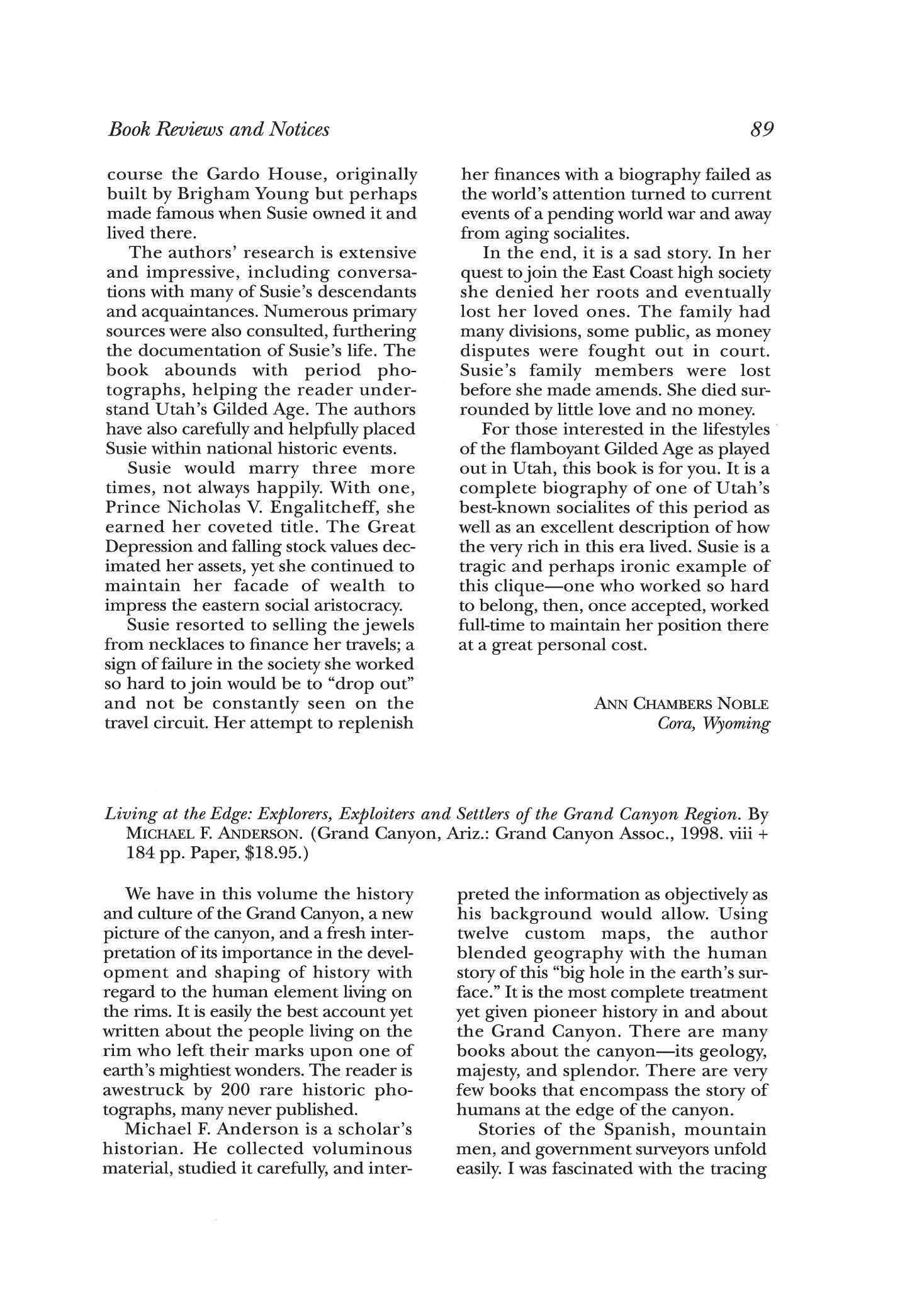
Book Reviews and Notices 89
of railroads in the canyon, some built, some proposed Moving to the chapter on the South Rim, I found an amazing full-page photograph of an early automobile teetering on the edge of the cliff. These old pictures tell as much of the story as written words do The scholarly reading is made more enjoyable by the insertion of colored pages with short vignettes on subjects such as "Lost Gold on the Arizona Strip" and "And Who Were the Harvey Girls?"
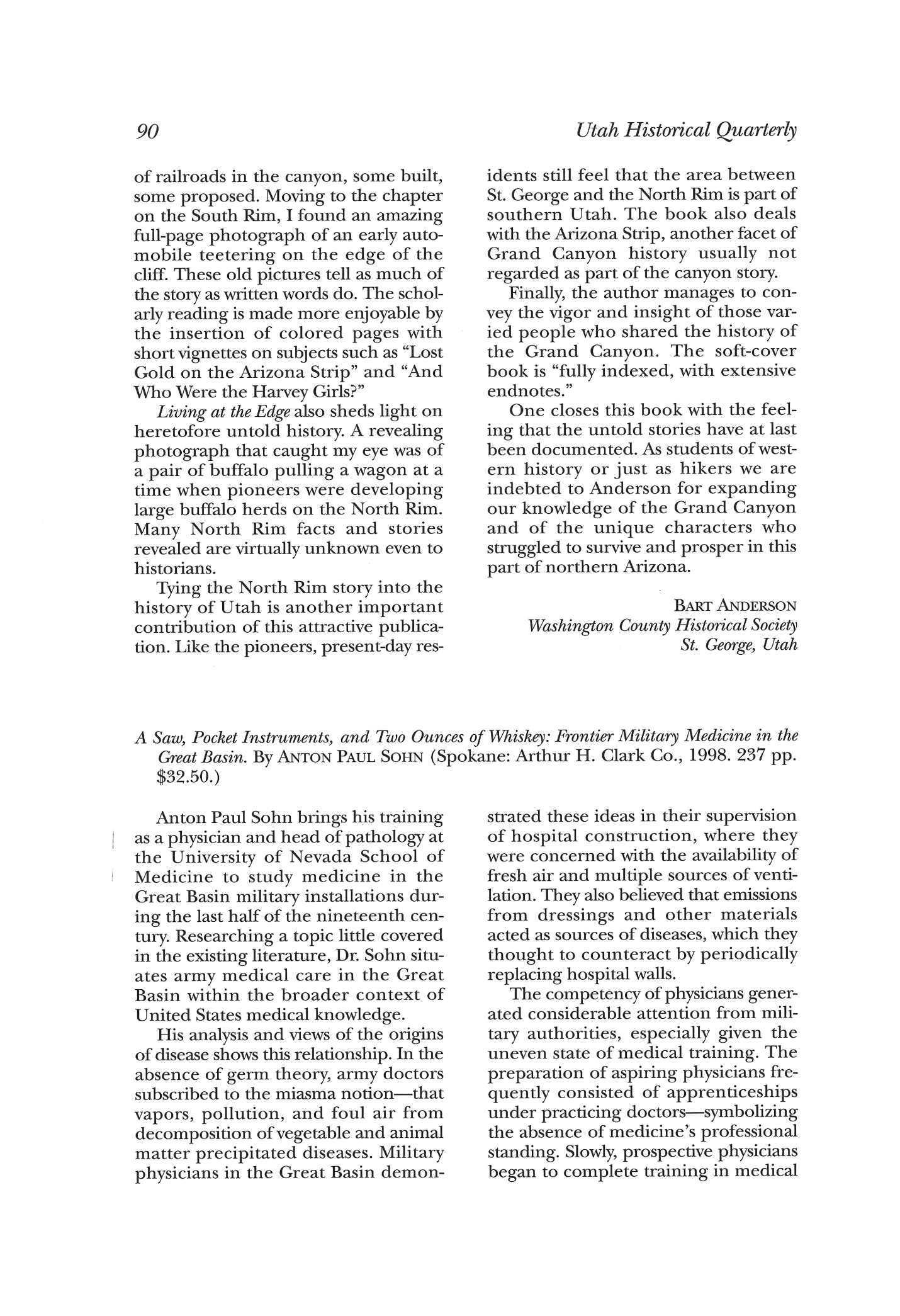
Living at the Edge also sheds light on heretofore untold history. A revealing photograph that caught my eye was of a pair of buffalo pulling a wagon at a time when pioneers were developing large buffalo herds on the North Rim Many North Rim facts and stories revealed are virtually unknown even to historians.
Tying the North Rim story into the history of Utah is another important contribution of this attractive publication Like the pioneers, present-day res-
idents still feel that the area between St George and the North Rim is part of southern Utah. The book also deals with the Arizona Strip, another facet of Grand Canyon history usually not regarded as part of the canyon story
Finally, the author manages to convey the vigor and insight of those varied people who shared the history of the Grand Canyon. The soft-cover book is "fully indexed, with extensive endnotes."
One closes this book with the feeling that the untold stories have at last been documented As students of western history or just as hikers we are indebted to Anderson for expanding our knowledge of the Grand Canyon and of the unique characters who struggled to survive and prosper in this part of northern Arizona
BART ANDERSON Washington County Historical Society St. George, Utah
A Saw, Pocket Instruments, and Two Ounces of Whiskey: Frontier Military Medicine in the Great Basin. By ANTON PAUL SOHN (Spokane: Arthur H Clark Co., 1998 237 pp $32.50.)
Anton Paul Sohn brings his training as a physician and head of pathology at the University of Nevada School of Medicine to study medicine in the Great Basin military installations during the last half of the nineteenth century Researching a topic little covered in the existing literature, Dr Sohn situates army medical care in the Great Basin within the broader context of United States medical knowledge. His analysis and views of the origins of disease shows this relationship In the absence of germ theory, army doctors subscribed to the miasma notion—that vapors, pollution, and foul air from decomposition of vegetable and animal matter precipitated diseases Military physicians in the Great Basin demon-
strated these ideas in their supervision of hospital construction, where they were concerned with the availability of fresh air and multiple sources of ventilation. They also believed that emissions from dressings and other materials acted as sources of diseases, which they thought to counteract by periodically replacing hospital walls.
The competency of physicians generated considerable attention from military authorities, especially given the uneven state of medical training. The preparation of aspiring physicians frequently consisted of apprenticeships under practicing doctors—symbolizing the absence of medicine's professional standing. Slowly, prospective physicians began to complete training in medical
90 Utah Historical Quarterly
colleges Still, no national standards existed before the end of the nineteenth century nor did any accrediting agencies function during these years. Nevada, where the majority of the Great Basin physicians were located, required a high school diploma by the mid-1870s but had no statewide licensing until 1899
Concerned about the professional quality of their physicians, the army demanded that candidates pass an extremely rigorous examination that covered topics ranging from Latin to surgery The high rate of failure in these examinations and the intense demand for medical care on the frontier meant that the military also recruited contract physicians who were seeking posts in the West In both cases the men had limited resources with which to treat their patients. Instruments such as chisels and probes were crude and few. Effective drugs were rare In fact, whiskey continued to be used in amputations, one of the most common forms of frontier surgery
Army physicians in the Great Basin had to cope with constant paperwork. This ranged from fiscal recordkeeping to hospital requisitions Since military physicians kept track of medical accounts, by default these men assumed the responsibilities of post treasurer for their installations. Great Basin physicians were also expected to provide reports that categorized the afflictions and ailments encountered in treating soldiers These reports gave the army consistent records of the quality of life on the frontier. In addition, army doctors in the Great Basin wrote prescriptions, monitored hospital workers, and enforced health regulations
Army physicians dealt with sanitation issues, disease outbreaks, traumas, and other ailments tied to military life. On the frontier, poor hygienic habits of the soldiers and contaminated food or utensils made infectious diarrhea
the most common problem facing medical doctors Malaria also plagued soldiers on the frontier although quinine and an eventual accurate diagnosis of the offending parasite reduced the incidence of this once-severe affliction. Inadequate diet often led to scurvy, which frequently reduced the soldiers' capacity to resist other diseases Army physicians commonly treated alcoholism, a routine occurrence in the isolated frontier forts. As members of a new mobile class without customs, roots, or close social ties, soldiers were prone to this weakness Inevitably, venereal disease also accompanied this lifestyle. Finally, post doctors often saw violent trauma, an unavoidable outcome of the very trade of soldiering
As the only trained personnel in the region, army physicians also extended their care to the surrounding populations Civilians came in sufficient numbers to provide both medical practitioners and the forts with outside income. Indians, too, used the fort physicians; smallpox epidemics in the Great Basin brought in desperate indigenous people whose own healers proved inadequate
Sohn provides the readers with a sound, thorough, and easily understood history of military medicine in the Great Basin. Despite the author's skill at placing the Great Basin within larger contexts, he fails to address this issue regarding the fate of indigenous people who suffered the same end as their ancestors when encountering the diseases Europeans and their descendants brought with them to the Americas. This minor point aside, Sohn's work stands as an effective introduction to army medical care in the Great Basin
 EDWARD J DAVTES II University of Utah
EDWARD J DAVTES II University of Utah
Book Reviews and Notices 91
Culture across Borders: Mexican Immigration and Popular Culture. Edited by DAVID R MACIEL and MARIA HERRERA-SOBEK (Tucson: University of Arizona Press, 1998 xiv + 268 pp Cloth $40; paper $16.95.)
A thin line that marks the spot where two worlds come together, the border between the United States and Mexico is also a line of national anxiety for both countries Much of that anxiety is focused on the figure of the immigrant who crosses that tense, frightening line
In the first chapter of this collection about how the image of the immigrant arises within U.S and Mexican popular culture, UCLA historian Juan GomezQuinones and California State University-Dominguez Hills historian David R. Maciel provide a useful summary of the history of immigration from Mexico to the United States. They see the immigrants as cultural actors operating in an international space and explore how this changes spatially, temporally, and socially They also explore how the history of Mexican immigration challenges dominant ideology concerning the peculiar institution of slavery and its role in the formation of U.S. society and the positive value accorded to immigrants in the national mythos when they have been systematically devalued in the political and social economy.
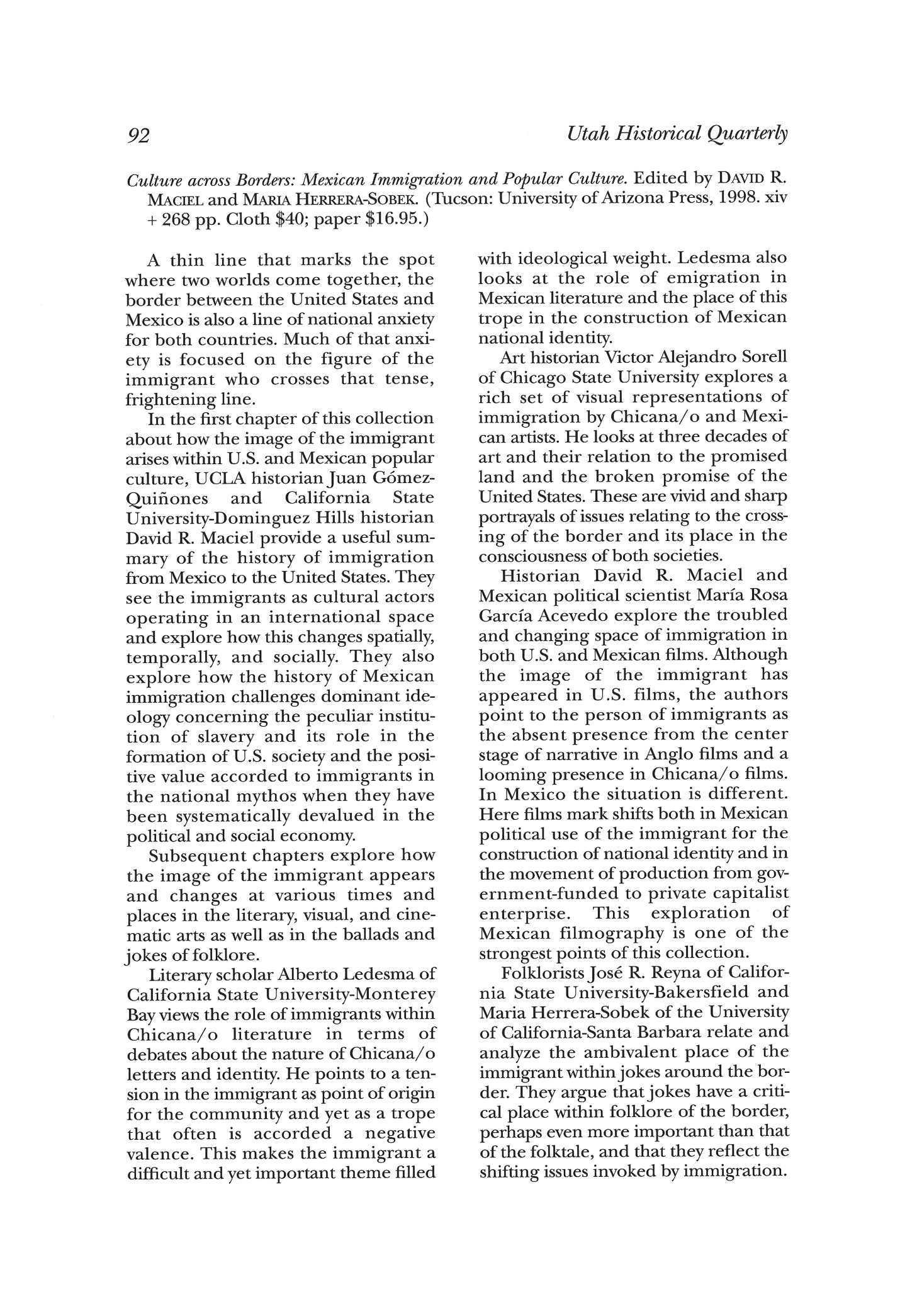
Subsequent chapters explore how the image of the immigrant appears and changes at various times and places in the literary, visual, and cinematic arts as well as in the ballads and jokes of folklore.
Literary scholar Alberto Ledesma of California State University-Monterey Bay views the role of immigrants within Chicana/o literature in terms of debates about the nature of Chicana/o letters and identity He points to a tension in the immigrant as point of origin for the community and yet as a trope that often is accorded a negative valence This makes the immigrant a difficult and yet important theme filled
with ideological weight Ledesma also looks at the role of emigration in Mexican literature and the place of this trope in the construction of Mexican national identity.
Art historian Victor Alejandro Sorell of Chicago State University explores a rich set of visual representations of immigration by Chicana/o and Mexican artists He looks at three decades of art and their relation to the promised land and the broken promise of the United States These are vivid and sharp portrayals of issues relating to the crossing of the border and its place in the consciousness of both societies
Historian David R. Maciel and Mexican political scientist Maria Rosa Garcia Acevedo explore the troubled and changing space of immigration in both U.S and Mexican films Although the image of the immigrant has appeared in U.S films, the authors point to the person of immigrants as the absent presence from the center stage of narrative in Anglo films and a looming presence in Chicana/o films In Mexico the situation is different. Here films mark shifts both in Mexican political use of the immigrant for the construction of national identity and in the movement of production from government-funded to private capitalist enterprise. This exploration of Mexican filmography is one of the strongest points of this collection
Folklorists Jose R Reyna of California State University-Bakersfield and Maria Herrera-Sobek of the University of California-Santa Barbara relate and analyze the ambivalent place of the immigrant withinjokes around the border. They argue that jokes have a critical place within folklore of the border, perhaps even more important than that of the folktale, and that they reflect the shifting issues invoked by immigration.
92 Utah Historical Quarterly
Finally, Maria Herrera-Sobek investigates the critical folk genre of the corrido, a kind of ballad that seems to constantly be refreshed in the culture of the border. She shows how the corrido functions within Mexican films of immigration as a shorthand, a hypertext that embeds critical references and information within the cinematic flow. This is an important multi-disciplinary collection of articles around the subject of the representation of immigrants within shifting political, economic, and social spaces Of course it cannot be complete It does leave large areas of popular culture unexplored, but it points the way towards future work on this politically explosive trope and reality in both Mexican and U.S
societies and cultures Although not its focus, this book also, at times, suggests the value of comparison with other national contexts.
My only complaint with the book is that the introductory theoretical chapter, despite the marshaling of impressive phrases, seems theoretically vacuous in terms of the very social theories the authors reference. This is unfortunate, but it only slightly mars what otherwise is an excellent and informative collection about the representation of a critical contemporary and historical social issue.
DAVID CLARK KNOWLTON Human Pursuits Salt Lake City, Utah
Comstock Women: The Making of a Mining Community. Edited by RONALD
and C ELIZABETH RAYMOND (Reno: University of Nevada Press, 1998 xii +
M.JAMES
394 pp Paper, $24.95.)
Comstock Women is one of several recent books presenting women who vary widely (and often) from the stereotypical soft-hearted whores and bonanza queens who almost exclusively people the mythical mining West In this work, the writers' lens focuses in tightly on Storey County, Nevada, encompassing (as the title suggests) the fabulous Comstock Lode and its attendant settlements of Virginia City, Gold Hill, and Silver City Just as the lode stimulated the growth of these settlements, the recent computerization of the Storey County manuscript census for 1860-1910 (except 1890, lost in a fire) and the 1875 Nevada census inspired or informed many of these articles
The work opens with two articles in the "Introduction" section In the first, C Elizabeth Raymond provides an overview of the rest of the book, categorized by sections entitled "At Home in a Mining Town," "Occupations and
Pursuits," "Ethnicities," and "Image and Reality." Then, in a piece Ronald James co-authored with Kenneth H Fliess, a series of bar graphs derived from the census data is analyzed and interpreted. Interestingly, despite the general emphasis in this volume on non-stereotypical females, the authors insist that the discussion of the complexity of women's existence (especially as indicated in the 1880 census) "must begin with prostitution" (28). After accounting for all possible or potential prostitutes, other groups can be effectively analyzed The authors critique an earlier analysis by Marion Goldman for finding too many prostitutes before going on to an overview of other female occupations on the Comstock As they admit, "summaries of groups lack the life breathed into the past by individuals" (38). The remaining articles try to provide that breath of life.
Articles in each of the subsequent sections deal more with flesh-and-

Book Reviews and Notices 93
blood women and include such interesting themes as marital status (divorce was fairly prevalent), vices (especially opium use), public activities (such as spiritualism and fortune-telling), and special callings (specifically, the Daughters of Charity) The section on "Ethnicities" includes Irish, Chinese, and Paiutes, the last group atypically enumerated in the 1880 Gold Hill census (239-41) The final section, "Image and Reality," departs from the census period but does emphasize widely different interpretive approaches to turnof-the-century Comstock women. The first essay, by Andria Daley Taylor, glows with vibrantly worded descriptions of 1940s literati and their unintended impact on the Comstock Lode The final essay, by Donald L. Hardesty, suggests applications of historical archaeology for future studies of mining town women
As with all collections of essays, the writing, use of sources, and analysis are uneven As previously mentioned, census data obviously suggested certain topics, notably the ethnicities described, boardinghouse keepers, and needleworkers (each of whom has a separate essay) Nonetheless, in her discussion of the Chinese, Sue Fawn Chung also incorporates folksongs to illustrate women's concerns and conditions on which the raw data are necessarily silent Likewise, in discussing divorce, Kathryn Dunn Totton makes excellent use of court documents, additionally tracing the fate of one of the divorcees by directing the reader to a companion piece on opium use (337, n47) Such interlocking of lives across different topics is rare More would be welcomed An exception to this lament
is the almost universal use of the memoirs of Mary McNair Mathews, published in 1880. Few essayists omit her very quotable prose
The book, as a whole, suffers some copy-editing errors potentially confusing to the reader One of the most bewildering is the reference to one of the Comstock's most fortunate women, a widow who married "Silver King" James Mackay. She is first presented as widow "Louise Hungerford Bryant" (137) and, after her second marriage, as "Marie Hungerford Bryant Mackay" (138) This confusion only dissolves when in another essay she appears as "Marie Louise Bryant," who subsequently married Mr. Mackay (160). In another oversight, the discussion of women's public activities refers to the Women's Christian Temperance Union, noted thereafter as the "WTCU" (193). Such annoyances are minor, however, and can easily be corrected in a later edition
Taken in toto, this book offers tantalizing glimpses into women's history research possibilities as well as singular female groups on the Comstock It touches on innovative topics, especially drug use and fortune-telling It also illustrates the multifarious uses of census data, much of them included in the appendices with the hope that they "may serve as the basis for further research" (303) Given the solid building blocks here offered, the goal of a future synthesis should not go unrealized.

94 Utah Historical Quarterly
NANCYJ TANIGUCHI California State University, Stanislaus Turlock, California
Black Pioneers: Images of the Black Experience on the North American Frontier.
By
JOHN W. RAVAGE.
(Salt Lake
City:
University of Utah Press, 1997 xxi + 224 pp $24.95.)
This book sets out to make the invisible visible African-Americans participated in virtually every aspect of the western settlement experience: black explorers, soldiers, midwives, cowboys, madams, prospectors, teachers, outlaws, families, and more all contributed to the region's social and physical landscape Yet the contributions of these individuals have all but vanished from the national consciousness
A media historian, author John Ravage uses photographs and snapshot-like narrative to make this point. The book, he says, is a partial answer to a question asked him thirty years ago: "And what are you doing about racial issues in our society?" Partial it may be, but this is an interesting and important reply, providing indelible testimony of the countless black individuals who influenced the West.
vu. But the fact is that sixty years earlier, the National Park Service had proposed an Escalante National Monument for southern Utah.
For ten years the NPS studied this initial proposal but ran into the same bitter resentment that Clinton would encounter after his announcement The Untold Story is not investigative journalism into the 1996 event; instead it details the NPS study of the nevercreated Escalante National Monument It does this mainly through summarizing and quoting the contents—reports, correspondence, and planning documents—of a fat government file on the issue This bureaucratic paper trail, condensed though it may be, makes for laborious reading, but the book does bring to light new information about conservation efforts on the Colorado Plateau and the perennial antipathy of many Utahns toward those efforts West Fever. By

The Untold History of Utah's Grand Staircase-Escalante National Monument.
By MAXINE NEWELL and TERBY BARNES (Moab:
Canyon Country Publications, 1998. 112 pp. Paper, $11.00.)
When in 1996 Bill Clinton announced the creation of the Grand Staircase-Escalante National Monument, few people felt any sense of deja
BRIAN W. DIPPIE
(LOS Angeles: Autry Museum of Western Heritage in association with University of Washington Press, 1998 128 pp $35.)
An eclectic assortment of artifacts from the Autry Museum glows on these pages. Here, for example, are burnished landscapes a la Moran and Bierstadt; the twisting horses of Russell and Remington; movie posters ("BARBARA STANWYCK: woman afire in a land aflame!"); Indian souvenirs; beaded buckskins; and household
items—like a red velvet parlor chair with arm- and headrests formed from buffalo horns (dangerous-sounding indeed, but the only real hazard lies in what this furniture might do to a decor).
Endowed by the recently deceased Gene Autry, the museum is not about homage to a star Instead, it explores the "context for a star's fame"; in celebrating the museum's tenth anniversary, the book gives an intriguing glimpse at collections that "illuminate the whole terrain" of the western myth (11)
The accompanying text tracks the history of West-consciousness as expressed through these artifacts of western iconography. Unfortunately, at times Dippie's essay abruptly changes course and wanders to an almost distracting degree Yet despite its moments of illogic, his writing—in conjunction, of course, with the rich illustrations—admirably "illuminates" a nation's obsession with the West.
Letters
Editor:
Andy Warhol Slept Here ? Famous and Infamous Visitors to Utah. By WILL SOUTH (Salt Lake City: Signature Books, 1998. 81 pp. Paper, $12.95.)
Celebrities in Utah? So who cares?
The truth is, after a stroll through these accounts of famous and demifamous visits and non-visits (read the book to figure that out), it gets a little easier to care The anecdotes, fascinating pictures, and—is it possible?— meaning in these pages begin to accumulate weight as the reader moves beyond the old Brigham Young-Horace Greely story into more offbeat accounts
The stories are just plain fun, even when the author indulges in soapbox commentary on his pet subjects. Besides, the book becomes almost a meditation on the nature of celebrity. Bring a century and a half of the famous to the state and watch as Utahns react, and you actually have a rather interesting topic.
Reference is made to the article entitled "Frederick Benteen and Fort Damn Shame" in the Summer 1998 (Volume 66, Number 3) edition of the Utah Historical Quarterly.

The sheriff referred to in that article was my grandfather, Sterling Driggs Colton, not Sterling Cotton as stated in the article. I would appreciate your bringing this to the attention of the author, Harold Schindler, and seeing that appropriate action is taken to prevent the error from becoming perpetuated
I enjoy your publication. Thank you for your consideration.
STERLING D COLTO N Bethesda, Maryland
Editor's note: The error came from Schindler's source, Harvest of Barren Regrets: The Army Career of Frederick William Benteen, 1834-1898, by Charles K. Mills.
96 Utah Historical Quarterly
UTAH STATE HISTORICAL SOCIETY
Department of Community and Economic Developmeni Division of State History

ORY






 BYBRIAN Q. CANNON
BYBRIAN Q. CANNON













 D R Roberts, a lawyer residing in Ogden who "endorse
D R Roberts, a lawyer residing in Ogden who "endorse


 Republican national committeeman George W. Snyder, left, and state committee chairman David f. Wilson, right, meet in 1940 with presidential candidate Wendell Wilkie at the Hotel Utah. Despite Republican efforts, Utahns again voted overwhelmingly for Roosevelt. Salt Lake Tribune photo.
38 Jonas, "Utah: Sagebrush Democracy," 33-34; F Ross Peterson, "Utah Politics Since 1945," in Poll etal., Utah's History, 518
Republican national committeeman George W. Snyder, left, and state committee chairman David f. Wilson, right, meet in 1940 with presidential candidate Wendell Wilkie at the Hotel Utah. Despite Republican efforts, Utahns again voted overwhelmingly for Roosevelt. Salt Lake Tribune photo.
38 Jonas, "Utah: Sagebrush Democracy," 33-34; F Ross Peterson, "Utah Politics Since 1945," in Poll etal., Utah's History, 518

 BYANDREW M HONKER
BYANDREW M HONKER


 Top: Debrisfrom Manti flood of 1902, showing creek flume near center of town.
Bottom: Main Street, Manti, afterflood. Theflume was actually raisedfour feet by debris that was pushed under it.
Top: Debrisfrom Manti flood of 1902, showing creek flume near center of town.
Bottom: Main Street, Manti, afterflood. Theflume was actually raisedfour feet by debris that was pushed under it.





















 BYGARYJAMES BERGERA
BYGARYJAMES BERGERA


































 Frank Hyde and A. L. Raplee; Beatrice Nielson collection, courtesy of SanJuan County Historical Commission. Raphe's placer mine, 1889; Charles Goodman photo, courtesy ofManuscripts Division, Marriott Library.
Frank Hyde and A. L. Raplee; Beatrice Nielson collection, courtesy of SanJuan County Historical Commission. Raphe's placer mine, 1889; Charles Goodman photo, courtesy ofManuscripts Division, Marriott Library.







 EDWARD J DAVTES II University of Utah
EDWARD J DAVTES II University of Utah








